Lecture 9: Marlowe
Contributed by: Chis Moreton
Ported over and converted into an .md file
Week 09 - Marlowe
This is a written version of Lecture #9.
In this lecture we cover Marlowe - a special-purpose language for financial contracts on Cardano.
Overview
In the previous lectures we have learnt about all the important ingredients for writing a Plutus application.
We have first looked at the extended UTxO model - the accounting model that Cardano uses - and the additions that Plutus brings to it.
Then we have talked about on-chain validation, minting policies, writing off-chain code, we have seen how to deploy smart contracts and also how to test them.
Plutus is a very powerful language. So powerful, in fact, that you can implement other languages on top of it - you can write an interpreter in Plutus for other languages.
One such language is Marlowe. Marlowe is a Domain Specific Language (DSL) for smart contracts.
For this lecture, Professor Simon Thompson, a very prominent figure in the Haskell community who leads the Marlowe team, and his colleague Alex Nemish will give guest lectures to tell us a bit about Marlowe.
Afterwards we will look at the Marlowe playground and play with a simple smart contract.
Lecture by Prof. Simon Thompson
Marlowe is a special-purpose language for writing financial contracts on Cardano.

Why do we build DSLs?
One reason is that we want to build languages that are closer to the language of the user and not so much the language of the system. They are designed to be in the specific domain of the application. A financial language will talk about payments, for example.
When we write a DSL, we get some advantages. We can write down things in that domain, but we can\'t perhaps write as much as we could in a general purpose language. And, if we do work in this more specialised context, we have the advantage of being able to give people better feedback and better error messages. We can also give more guarantees on program behaviour. That\'s one of the things that will be stressed in this lecture.
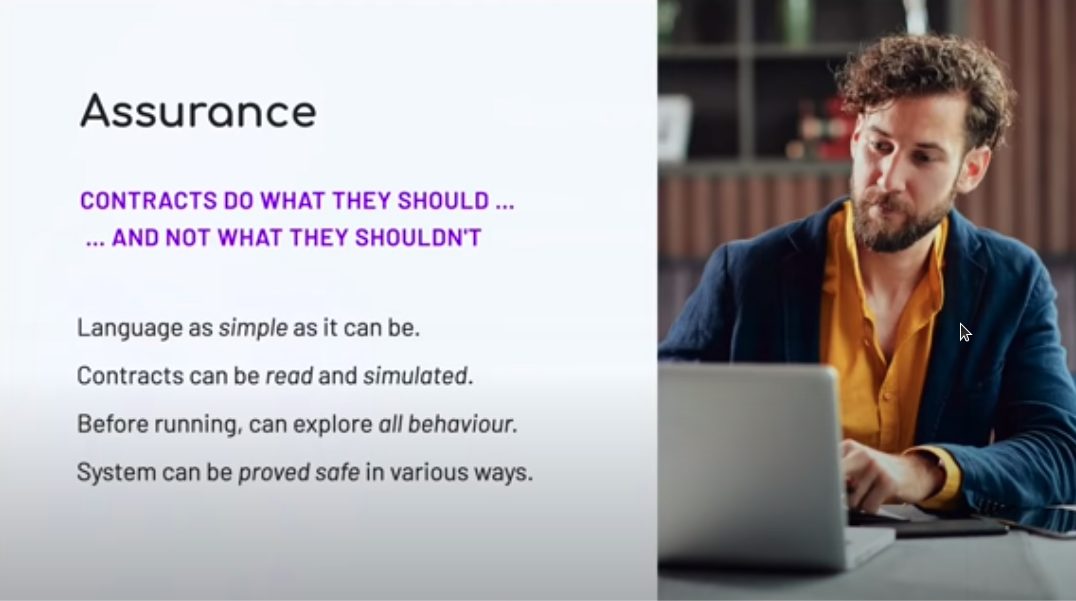
What kind of assurance can we give?
We can give two kinds of assurance. We can make sure that contracts do what they are supposed to do, but we can also make sure that they don\'t do what they shouldn\'t. We will see both aspects of that as we go along.
We\'ve designed the language to be a simple as possible and the implementation reflects that, and we\'ll talk a bit about that later on. Contracts are nice and readable, and also we can easily simulate them, so we can present to users a very clear picture of how their contract in Marlowe will behave.
In fact, we can do more than that. Because they are particularly restricted, we can explore every possible behavior path that a contract can take, before it is executed. So, we can give complete guarantees about how a contract will behave, not just on one or two tests, but on every possibly execution sequence.
It\'s also more straightforward to write mathematical proofs of various kinds of safety, so that is the strongest criteria that we can hit in this kind of world; a mathematical proof that the system will do certain things and won\'t do others.
What does a financial contract do?
Let\'s start by looking at what a financial contract can do.
A contract can accept payments from participants in the contract.
Depending on choices made by one the participants, it can evolve in different directions.
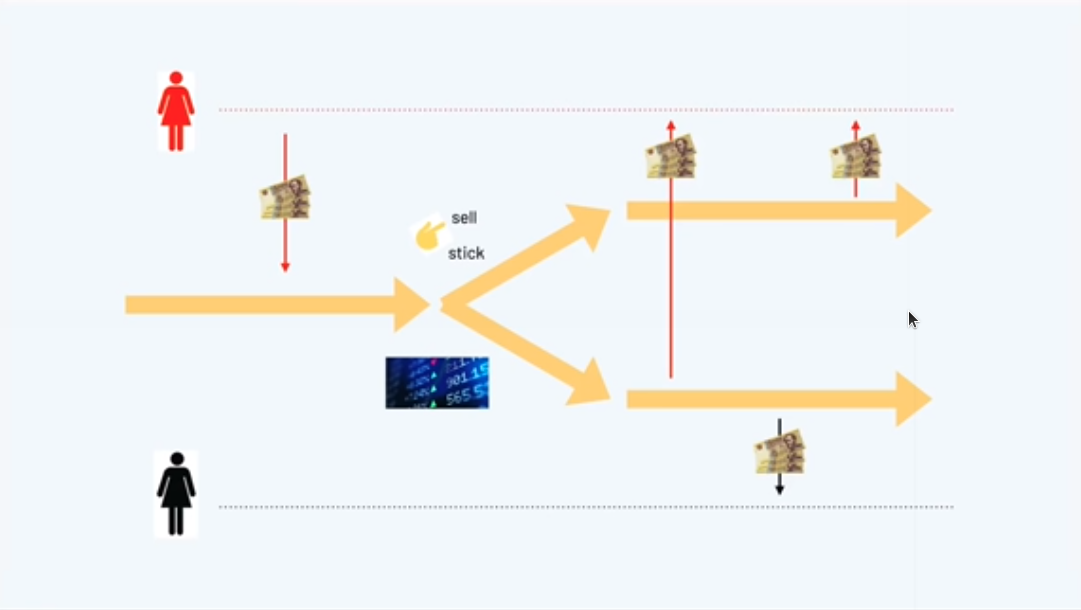
It can make decisions based on external information such as the information coming from a stock exchange. So, information coming from an oracle can determine the future behaviour of a contract.
A contract can also make payments out. If money has been deposited in the contract, that money can be deposited out to participants.
So we have flows of money and choices according to external factors.
One final thing that we have is that the roles in a contract are things that themselves can be owned. We represent that in Marlowe by minting tokens that represent those roles. That means that we can use those tokens as evidence that somebody is meant to be playing a role. They are a form of security that a person submitting a transaction is allowed to submit that transaction, but also it means that these roles are tradable. A role could be traded by another person or another contract.
Language design
Now let\'s think about how to design a language based on these ingredients.
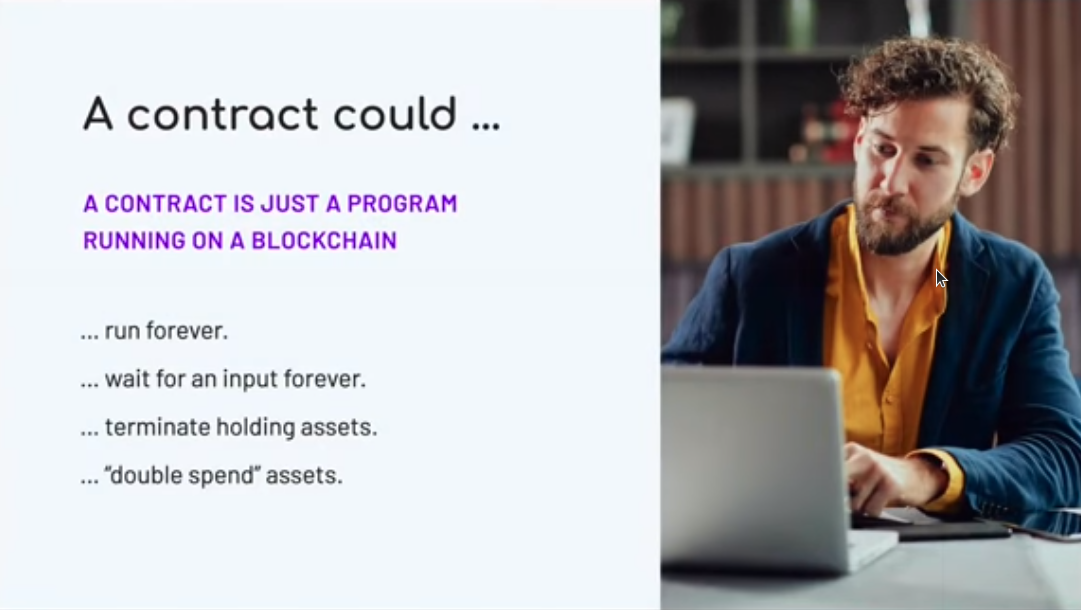
When we design a language of contracts, what we are really doing is designing a programming language. A smart contract is just a program running on a blockchain.
A contract could, in principle, run forever. And also, more subtly, it could get stuck waiting for an input forever.
It could terminate while holding assets, locking them up forever.
So there\'s a whole lot of security issues that a program might have.
Designed for safety
What we chose to do was to design for safety.
Contracts are finite
Firstly, contracts are designed to be finite. Their life will be finite, there is no recursion or looping in Marlowe. We will come back to that a bit later on when we talk about Marlowe being embedded in other languages.
Contracts will terminate
We can be sure that contracts will terminate. We do that by putting timeouts on every external action. Every choice, every deposit of money into the contract comes with a deadline. Marlowe contracts cannot wait forever for somebody to make a choice or for an action to happen. If you hit the timeout then an alternative course is taken.
No assets retained on close
We\'ve designed the semantics of the language so that when a contract reaches its close, at the end of its lifetime, any money left in the contract will be refunded to participants.
Conservation of value
Conservation of value is something that we get for free from the underlying blockchain. The blockchain guarantees that we can\'t double spend and because we are using the transaction mechanisms of the underlying blockchain, we can be sure that we are getting conservation of value.
So this is giving us a lot of guarantees out of the box. These are not guarantees that you get from Plutus contracts in general. A Plutus contract could go on forever, it need not terminate and it could terminate while holding a whole collection of assets which then become unreachable.
The Marlowe Language
So what does the language look like? Let\'s cut to the chase.
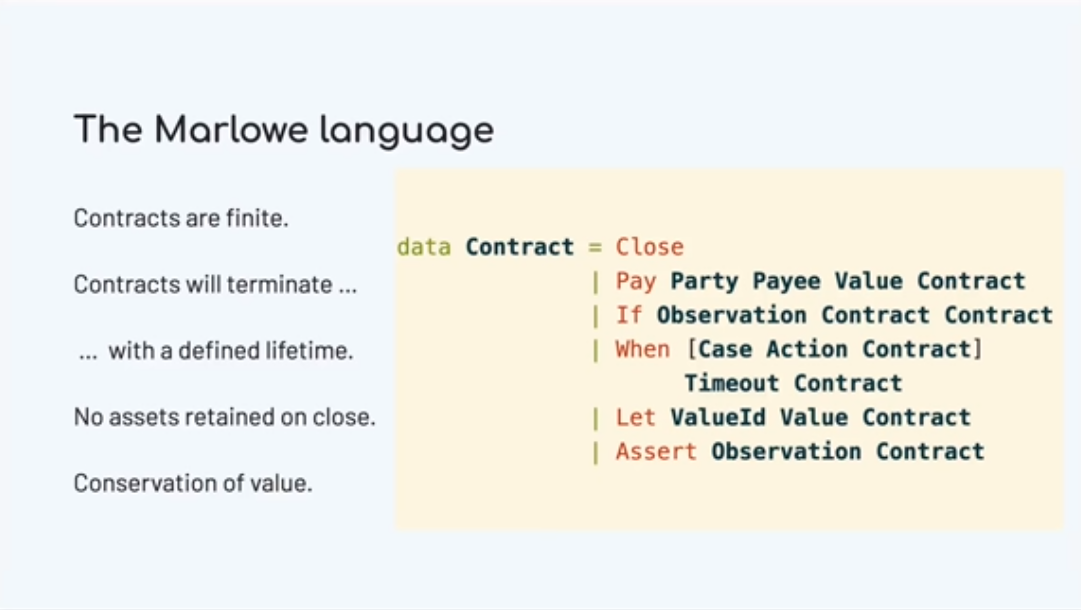
Marlowe, at heart, is represented as a Haskell datatype.
data Contract = Close
| Pay Party Payee Value Contract
| If Observation Contract Contract
| When [Case Action Contract] Timeout Contract
| Let ValueId Value Contract
| Assert Observation Contract
deriving (Eq,Ord,Show,Read,Generic,Pretty)
We have a Pay construct. In that a Party in the contract makes a payment to a Payee of a particular Value, and then the contract continues with what we call the continuation contract.
We can go in two separate directions. We can observe If a particular Observation is true or not. If the observation is true we follow the first Contract, if it is false we follow the second Contract.
The most complex construct in Marlowe is the When construct. It takes three arguments. The first of those is a list of Contract/Action pairs - a list of Cases.
What the When construct does is wait for one of a number of Actions. When one of those Actions happens, it performs the corresponding Contract. For example, it could be waiting for a deposit. If we have a case where the first part of the pair is a deposit, then we execute the corresponding second part of the pair. Similarly with making a choice or with getting a value from an oracle.
Here we are waiting for external actions and, of course, the contract can\'t make those actions happen. A contract can\'t force somebody to make a choice. It can\'t force somebody to make a deposit. But what we can do is say that if none of these actions takes place then we will hit the Timeout, and when we hit the Timeout, we will perform the Contract represented by the final argument to the When construct.
So, we can guarantee that something will happen in the When construct, either by one of the actions triggering a successive contract, or we hit the timeout and go to that continuation.
Finally we have the Close construct which has the semantics defined so that nothing is retained when we close.
That is the Marlowe language, and we will see that we can use these to construct Marlowe contracts in a variety of ways.
The Marlowe Product
So that is the language. What is the Marlowe product itself?
We have a suite of things. First we\'ll look at the overall vision for Marlowe and then look at where we are in terms of fulfilling that vision.
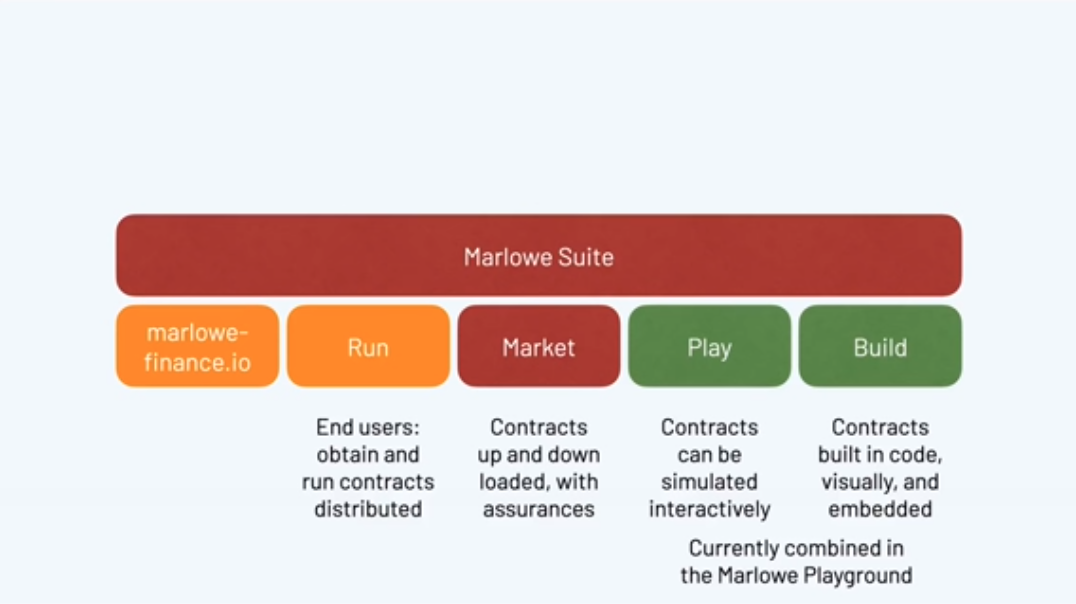
We have a prototype for Marlowe Run. That is the system through which an end user will interact with contracts running on the Cardano blockchain. You can think of Marlowe Run as the Marlowe dApp. It\'s the things that allows Marlowe contracts to be executed.
We\'re also building a market where contracts can be uploaded, downloaded, and where we can provide various kinds of assurance about those contracts.
We allow contracts to be simulated interactively and we call that Marlowe Play. We allow contracts to be built in various different ways and we call that Marlowe Build. In fact fact what we\'ve done at the moment is bundle those two - Marlowe Play and Build - into what we call the Marlowe Playground.
So as things stand at the moment you can use the Marlowe Playground to simulate and construct Marlowe contracts we\'re in the process of redesigning the user experience based on what we\'ve done with Marlowe Run.
What we\'re releasing very shortly is the prototype of Marlowe Run and this is the prototype of how end users will interact with Marlowe on the blockchain. Our intention is that we\'ll have all these products available running on the Cardano blockchain when we have the full support for this which will involve having the Plutus Application Backend and the wallet back end and so on working as they should.
Demonstration
We\'ll now look at a demo of what we have in Marlowe Run to give you a sense of what we can do at the moment in terms of giving users the experience that they will have when Marlowe is running on blockchain. This will be the app that is going to provide that experience.
At the moment it\'s running locally but in a few weeks\' time we will be releasing a version that runs in a distributed fashion on the simulated blockchain. Then, as we go into the end of the year we expect to have it running for real on the Cardano blockchain itself.
You can find the Marlowe Playground at
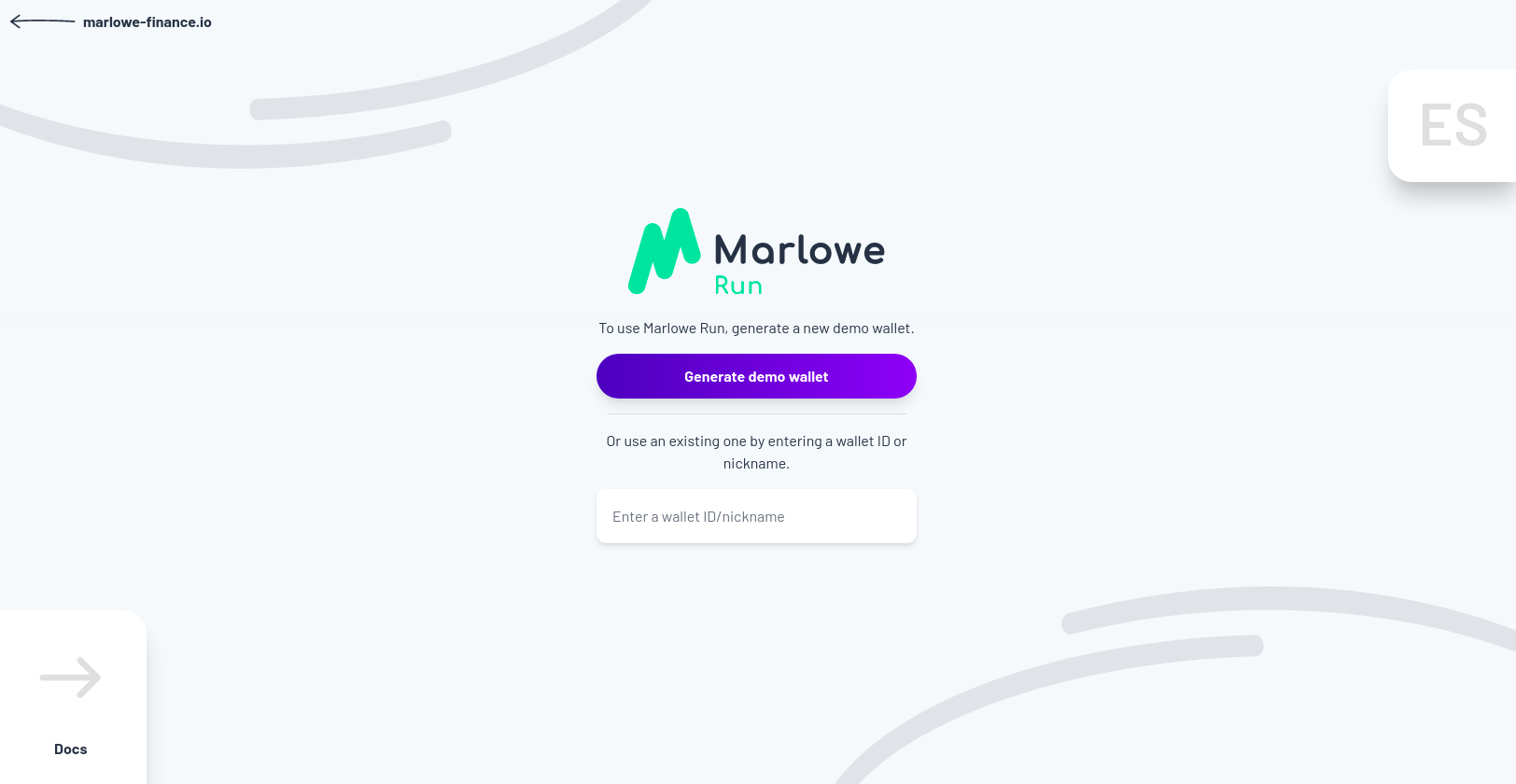
Marlowe run runs in the browser and what it does is provide the end user interaction with contracts running on the blockchain.
For the moment we\'re simulating that blockchain inside the browser but eventually this will be the tool you\'ll use to run contracts for real on Cardano.
To interact with the contract your wallet needs to be involved to control your your signature and to control your assets, so we link up Marlowe to run with a wallet. Let\'s link it up with Shruti\'s wallet. You can do this by creating a demo wallet, or by selecting an existing wallet.
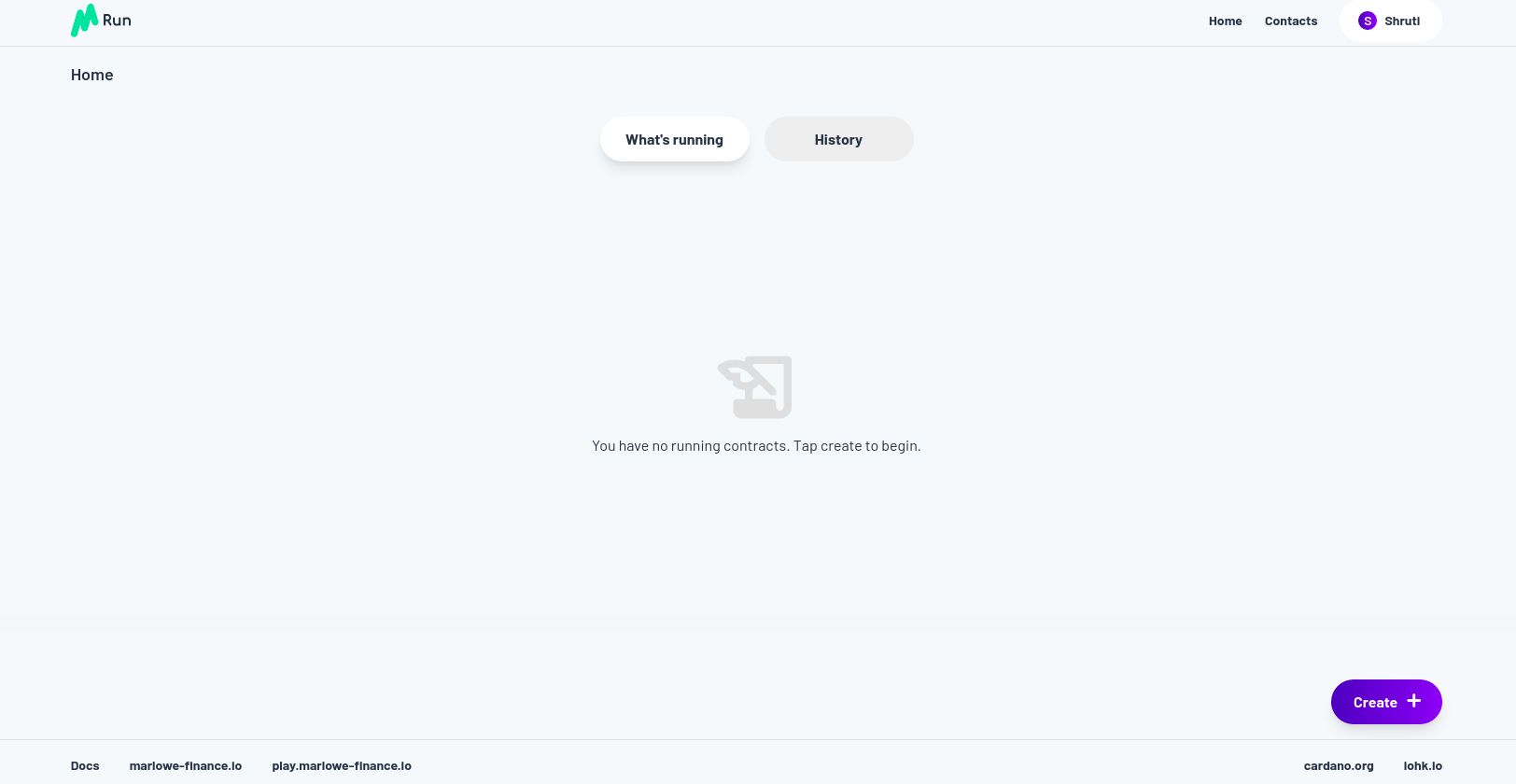
In this window we see the world from Shruti\'s perspective. Let\'s open up another window and link that window to the world from Charles\'s perspective.
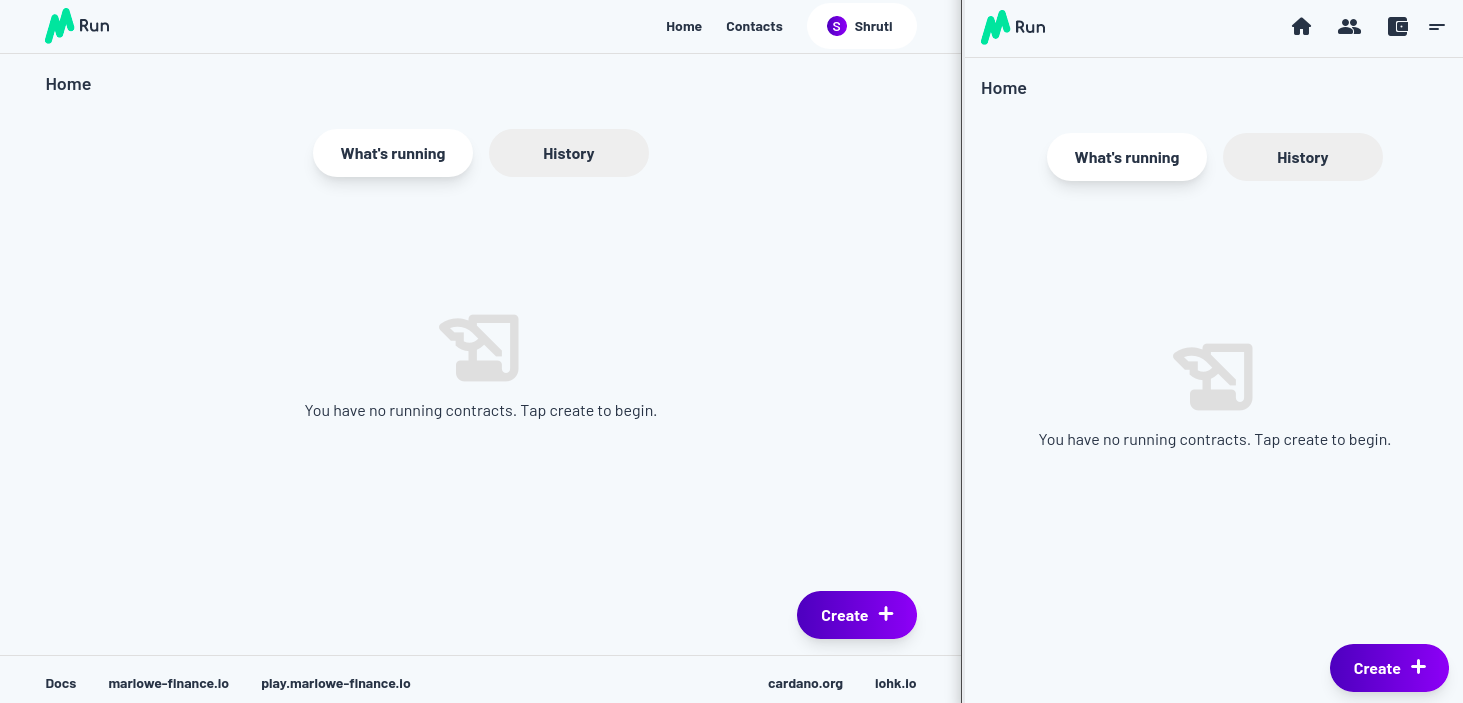
At the moment neither of them has any contracts running. They have a blank space, but let\'s start a contract up. Let\'s set up a zero coupon bond which is a fancy name for a loan. You can do this by clicking Create and selecting the Zero Coupon Bond option.
Let\'s suppose that Shruti is making a loan to Charles. She\'s the investor he\'s the issuer of the bond.
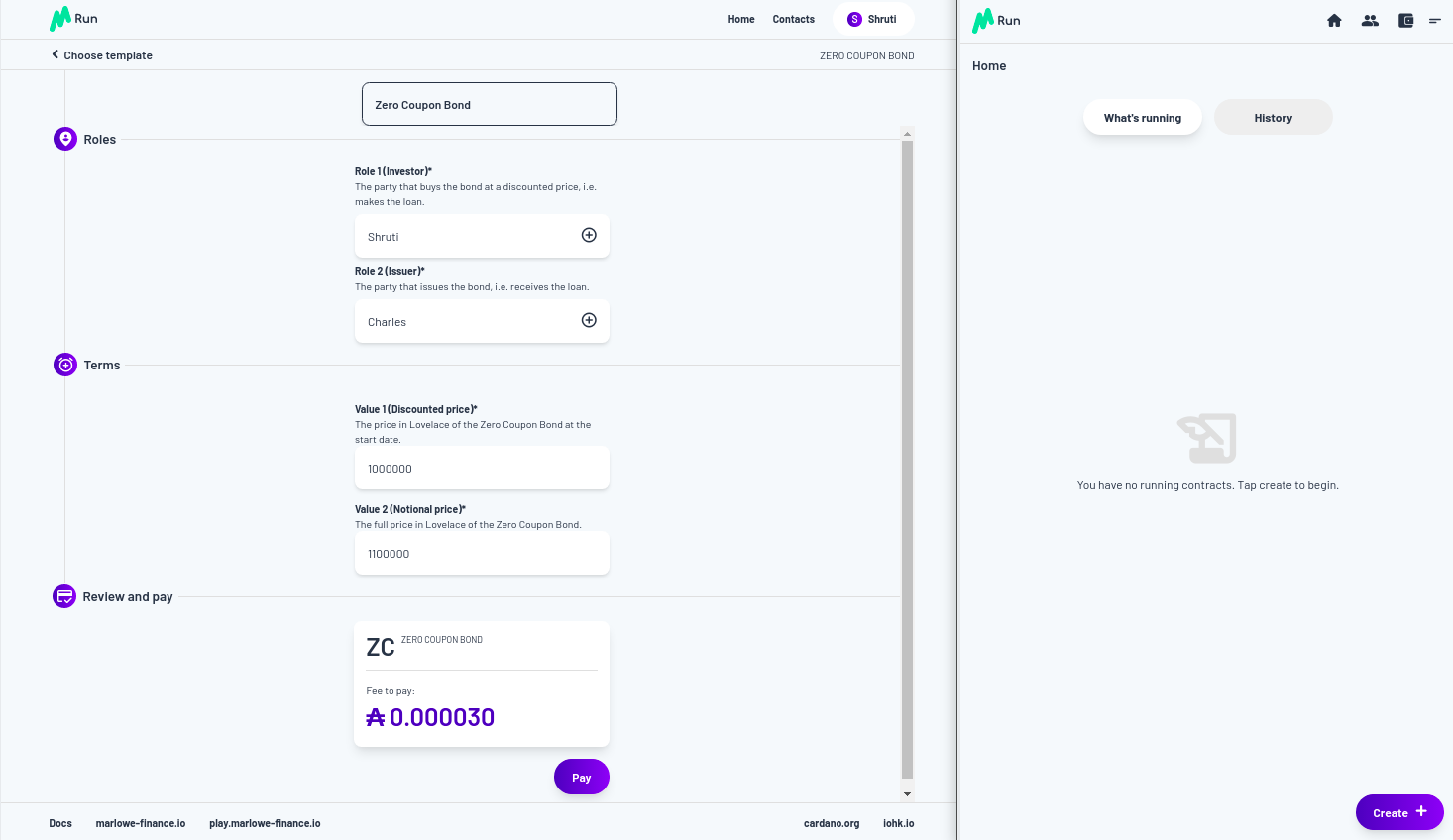
Charles wants to borrow one Ada from Shruti and he\'s promised to pay back 1.1 Ada. So we\'ve said who the issuer and investor are we said what the price and the eventual value will be and we\'re now going to create the contract. In order to do that we have to make a payment of 30 lovelace to get the contract started.
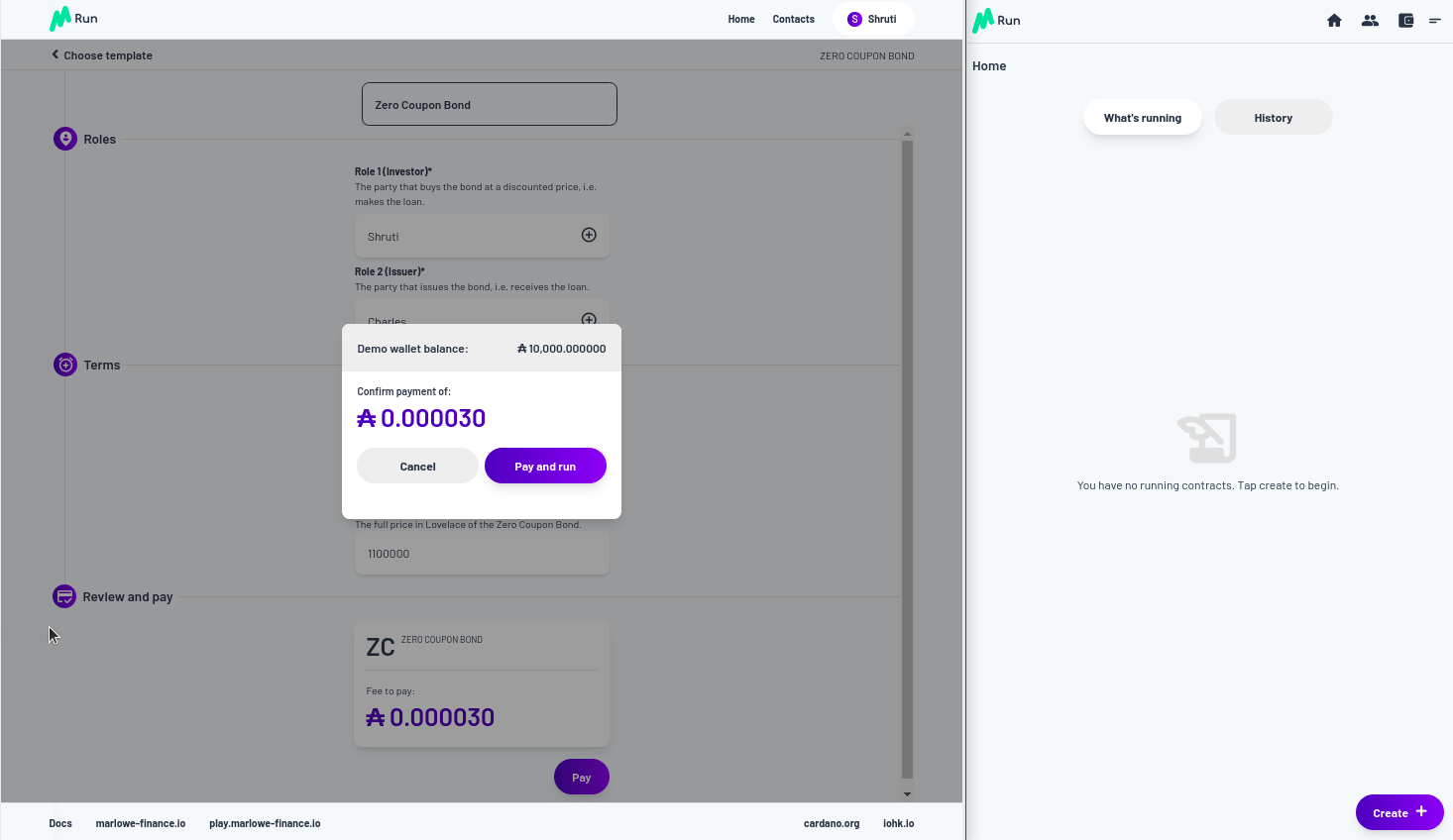
So let\'s pay. We are asked to approve and the payment goes through. You can see now in Shruti\'s Marlowe Run we\'ve got the Zero Coupon Bond running, but also, if you look at Charles\'s view of the world, it\'s running there too for him.
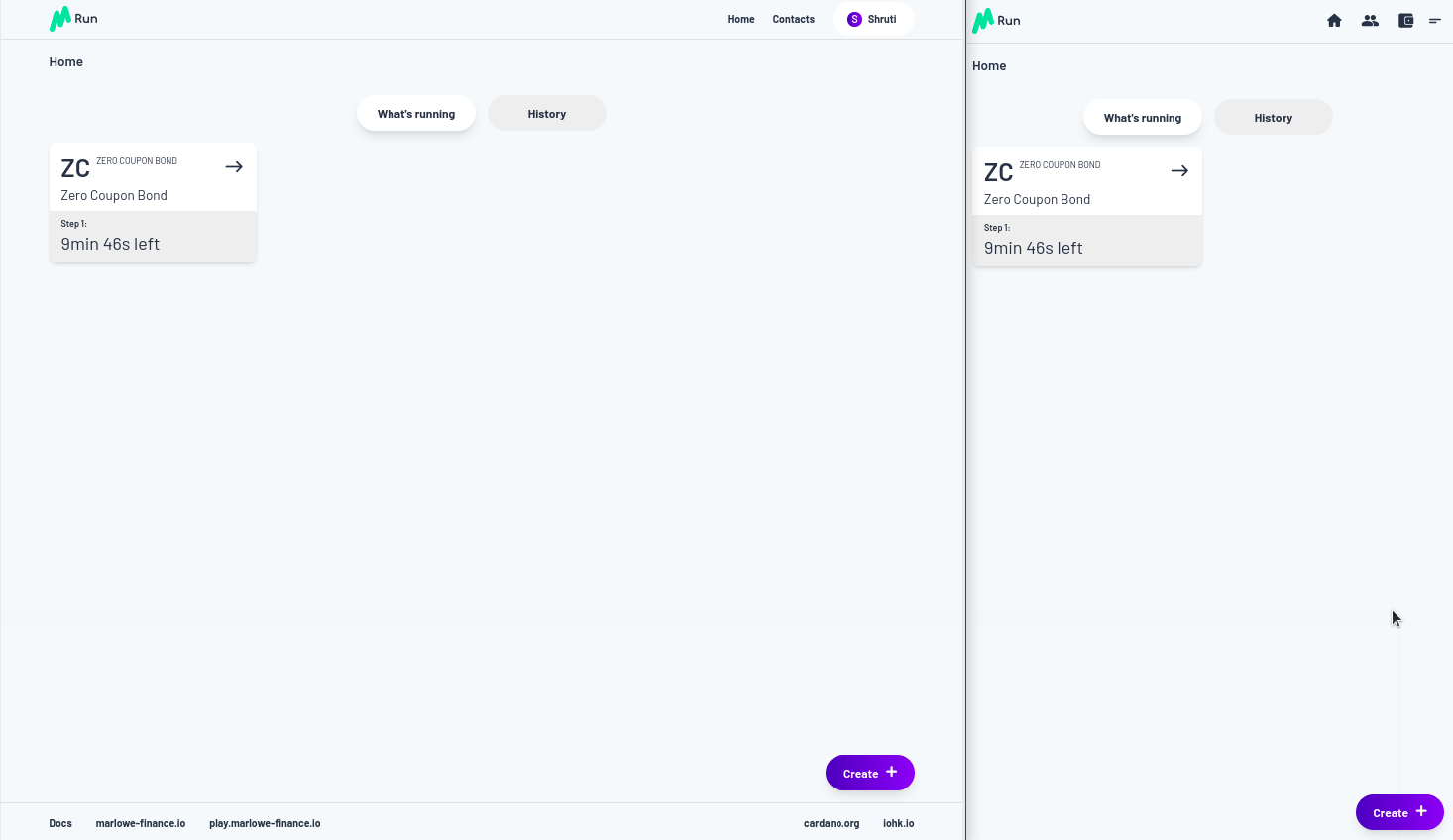
We\'re at the first step. If we click through on Charles\'s contract, it\'s saying that it\'s waiting for something from the investor, who is Shruti.
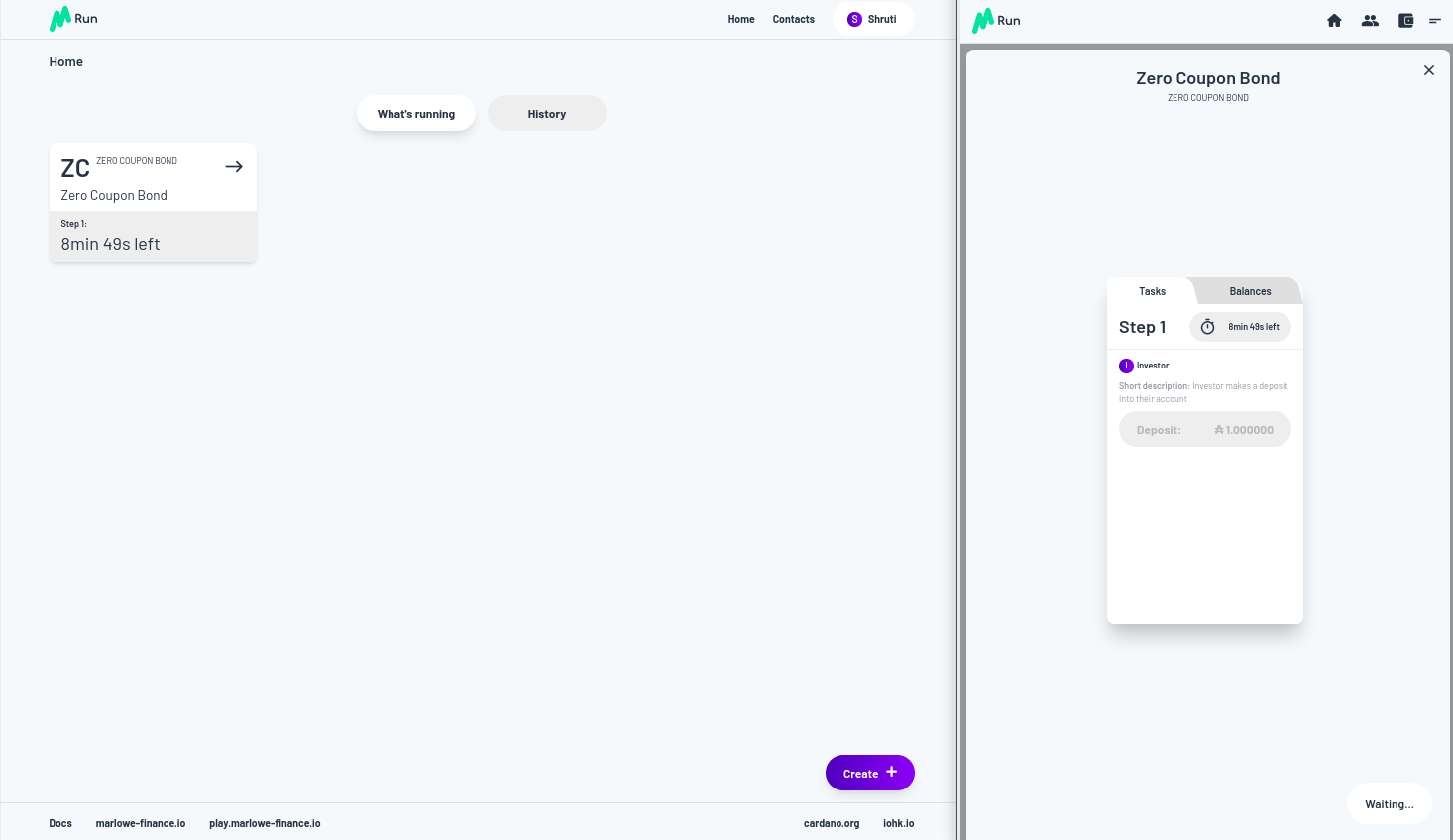
So let\'s see what\'s happening in her view.
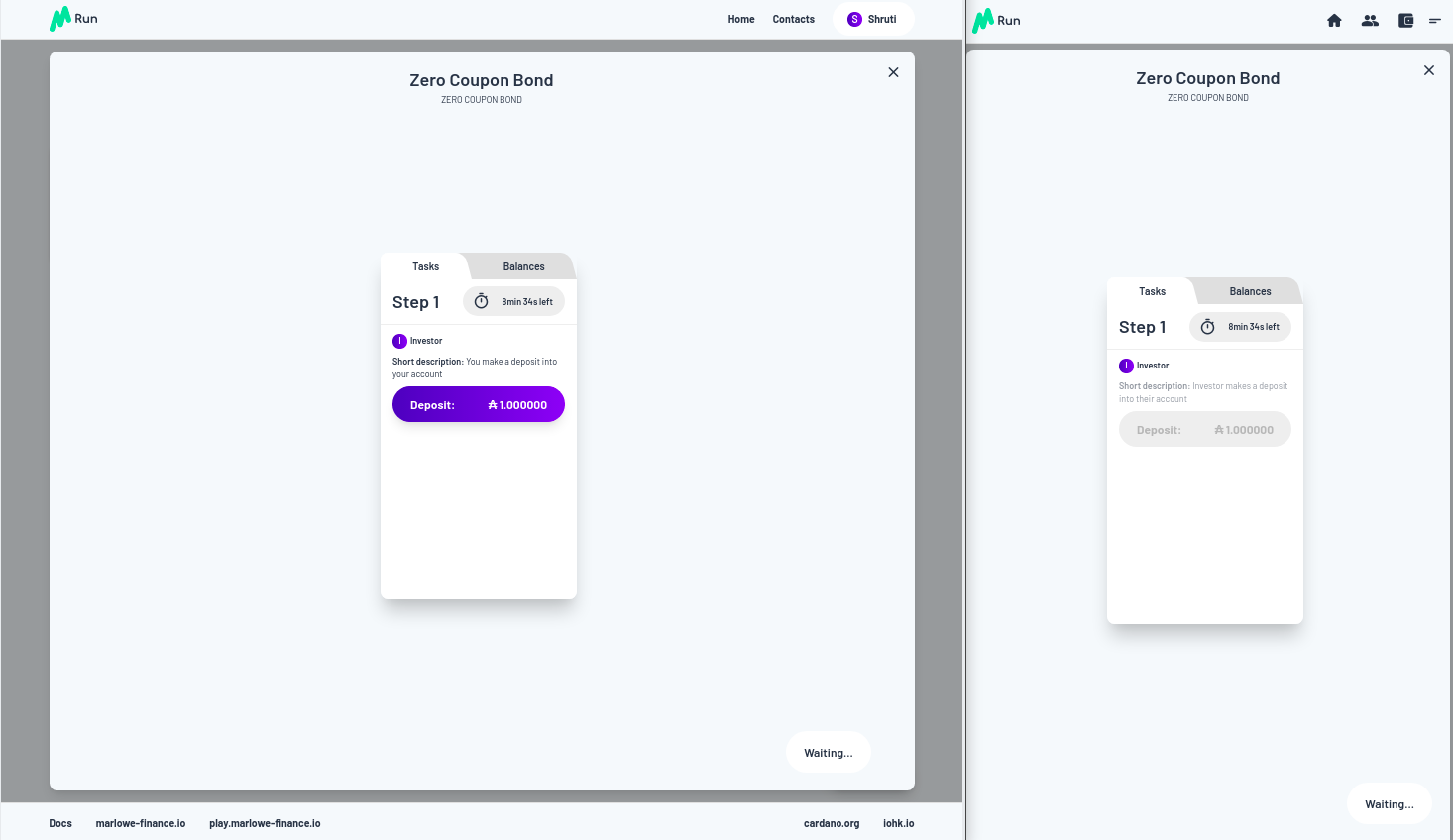
She\'s being asked to make a deposit so let\'s click on that to make the deposit.
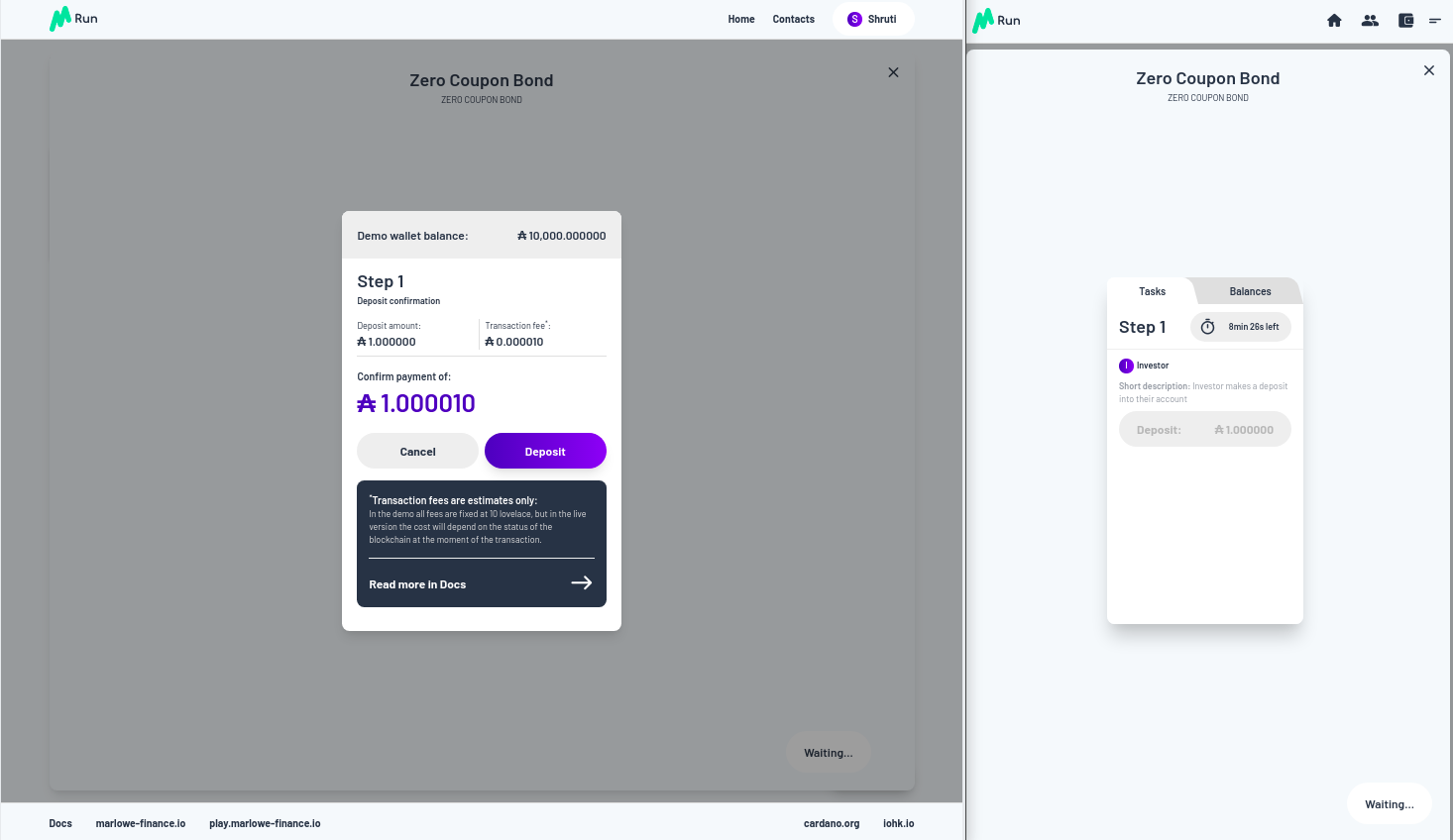
And click to confirm with a fee of 10 lovelace.
Then you can see her view has changed now she\'s waiting for the issuer to pay her back.
We look in Charles\'s view, which is incidentally the mobile view, of Marlowe Run, and he\'s asked to pay his 1 Ada.
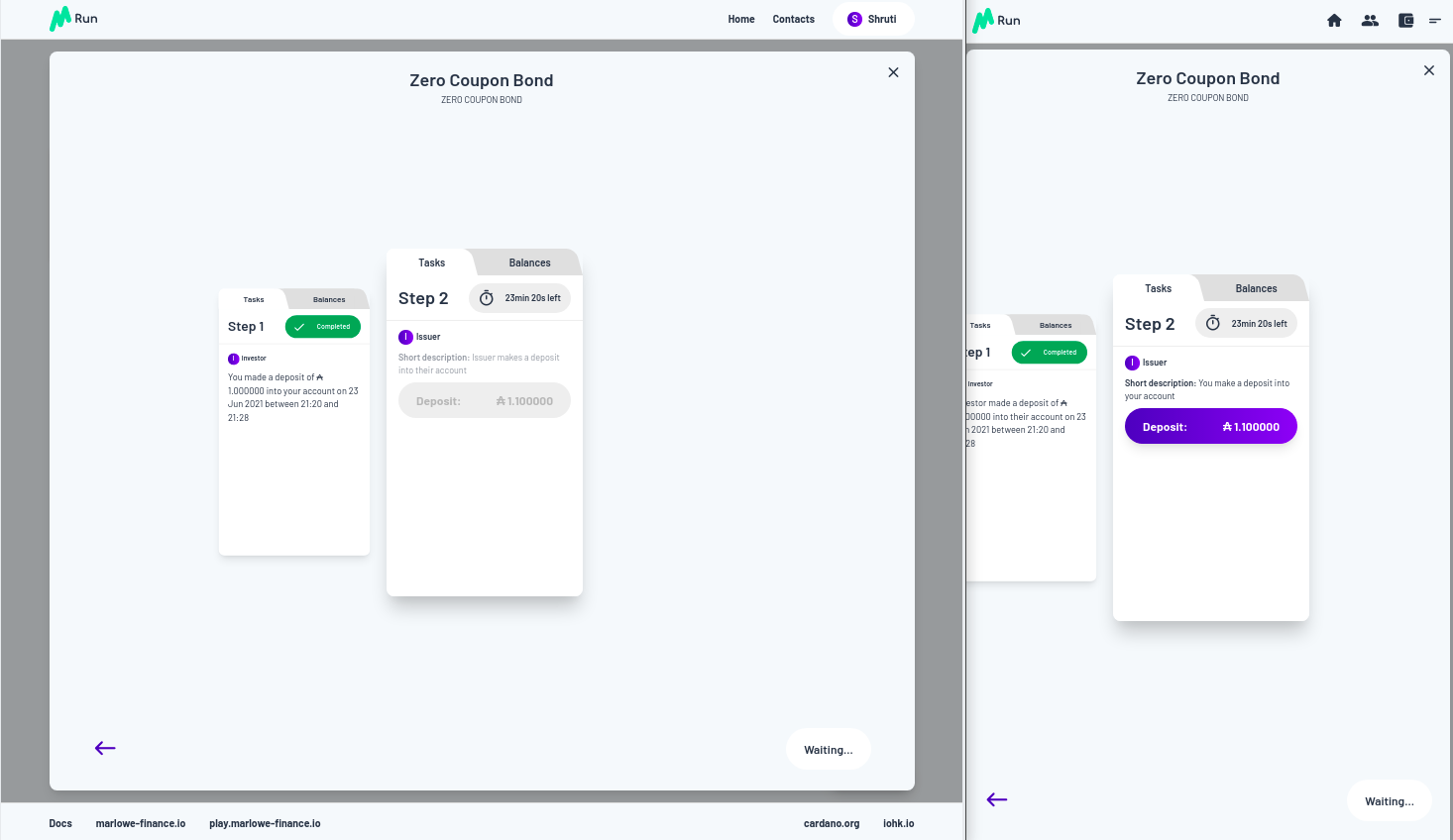
Let\'s make him do that now. He\'ll also have to pay a 10 lovelace transaction fee.
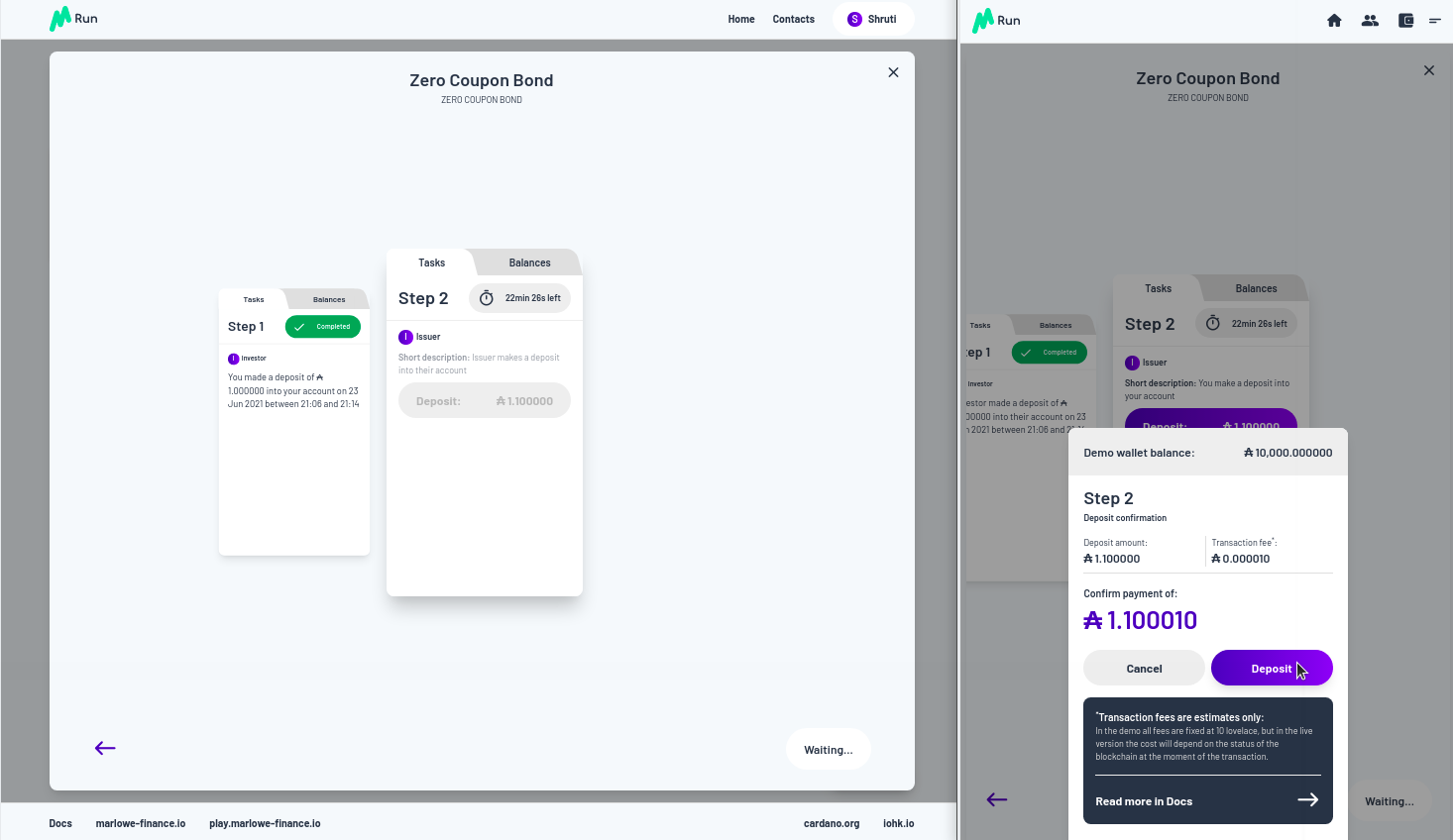
Let\'s make that deposit.

And you see now from both their perspectives that loan is completed you can see the history of what\'s gone on. You can see, at particular points, the balances that the contract holds.
If we close that and select History, we can see the history of all the contracts that Shruti has taken part in.
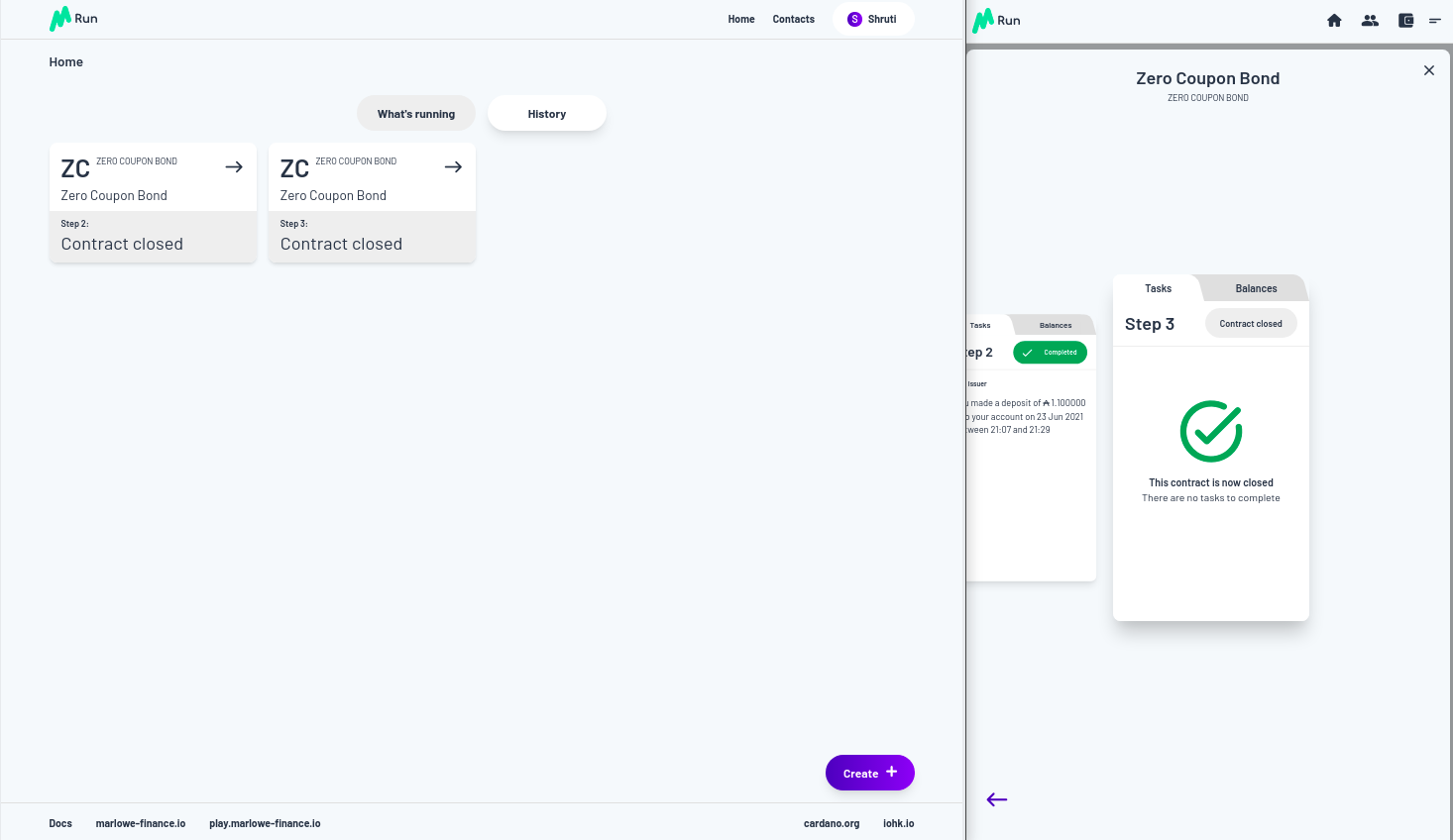
That pretty much covers the basics of what you get from Marlowe Run. It\'s an intuitive interface to a contract running on the blockchain. You see that each participant in the contract gets their view of the contract in real time, updated from what is, in this case in the browser, but eventually what\'s on the blockchain.
Engineering
Let\'s now take a look under the hood and see how Marlowe will be executed on Cardano.
Here\'s a diagram just to give you the context. You\'ll understand most parts of this diagram already. We a Cardano root node on which Plutus is running, and as you know, Plutus is a dialect of haskell, more or less.
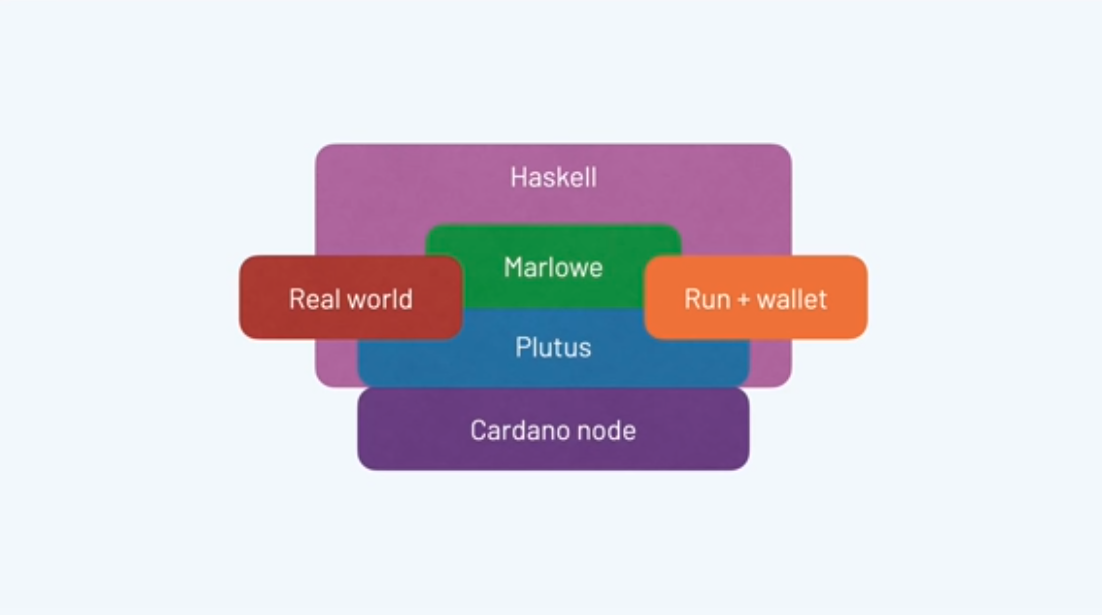
Marlowe is embedded in Haskell and Marlowe is executed using Plutus. So Marlowe sits on top of Plutus, but it\'s also linked to Marlowe Run and has an attachment to a wallet you\'ll be able to interact with as an end user with a running Marlowe contract.
Also it gets linked to Oracles and so on sitting out there in the real world.
Now, what does it mean to to execute a Marlowe contract?
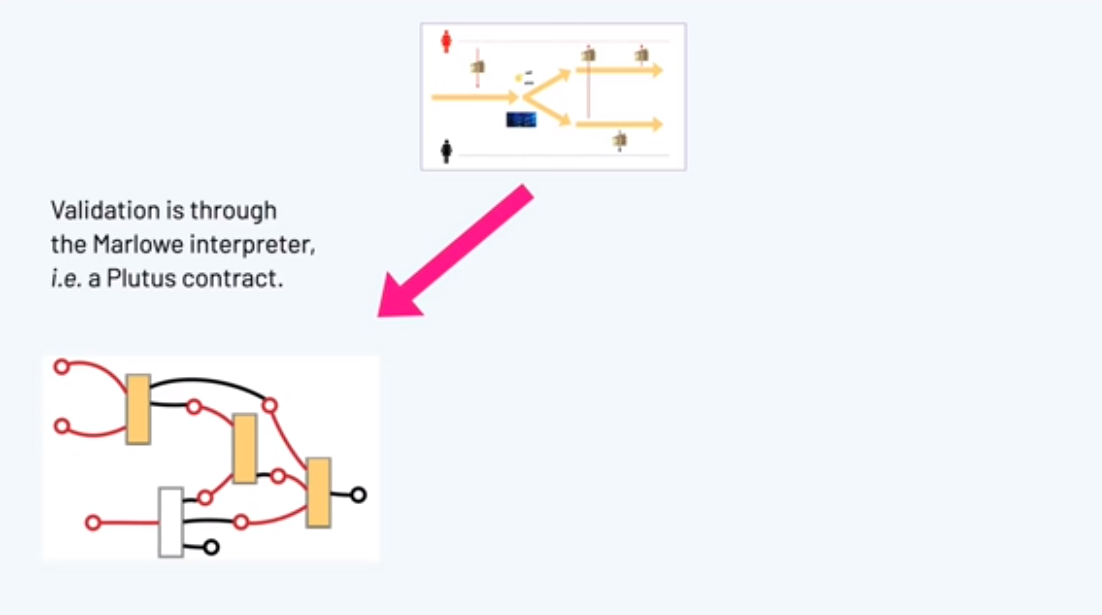
Again this will be familiar to you from Plutus but let\'s just talk through precisely how it works.
Executing a Marlowe contract will produce a series of transactions on the blockchain. Obviously Plutus running on Cardano checks the validity of transactions. We have a validation function.
The validation function for these Marlowe transactions is essentially a Marlowe interpreter. It checks that the transactions indeed conform to the steps of the Marlowe contract. That\'s done using the (E)UTxO model, so we pass the current state of the contract and some other information through as datum.
The Marlowe interpreter uses that to ensure that the the transactions that are submitted meet the criteria for the particular Marlowe contract.
So that\'s the on chain part.
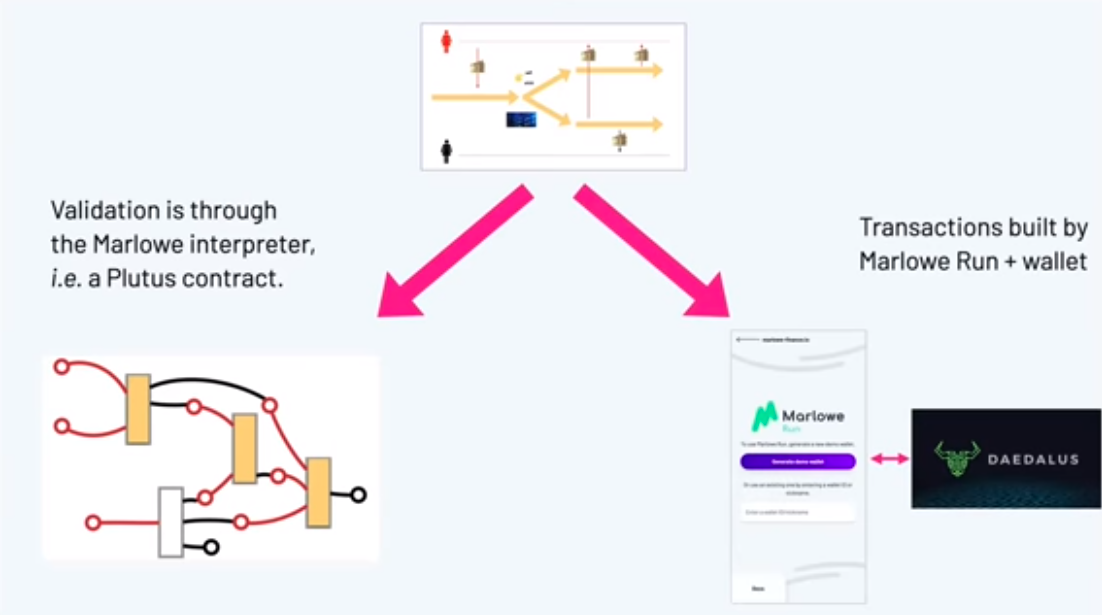
Obviously off chain there\'s a component as well. So we have to have Marlowe Run and we\'ll have to build the transactions that meet the the validation step on chain.
And, if and when the contract requires crypto assets it will have off chain code to ensure that transactions are appropriately signed so that we will have authorization for spending crypto assets.
Using Marlowe run and an associated wallet, we construct the transactions.
We get a flow of information in both directions. Marlowe run will submit transactions to the blockchain that then can be validated by the Marlowe interpreter, which is itself a Plutus contract. It\'s one of the largest Plutus contracts that exists.
But there\'s also information flow another way because suppose that the transaction I\'ve submitted is a deposit of money into a running contract, and suppose the contract also involves Charles Hoskinson, so my instance of Marlowe Run has submitted that transaction, but Charles also has to be notified about that.
The information flows in the other direction using the companion contract to ensure that every instance of Marlowe Run gets informed about activity in that contract.
Alex will talk some more about the details of the implementation but here you\'re seeing an outline of how it all how it all works.
Transactions are validated on chain through the interpreter, but they have to be built off chain and in some cases have to be authorized. Essentially the blockchain is the central synchronization point for the distributed system that is the collection of instances of Marlowe Run that are interacting to execute the contract/
You saw in the demo that, in two separate windows, we were sharing information. That was simulating it locally but in production this will be information that\'s stored on the blockchain.
System Design
Let\'s talk a little bit about how the system is designed in in a high-level way.
Here\'s a piece of the semantics of Marlowe, and as you can see it\'s a Haskell function.

We take an environment, the current state and a contract we executed, and based on what contract that is - a close perhaps, or a pay, we can reduce we can take some steps of computing the results of that contract.
We do that in a way that uses uses Haskell in a quite straightforward way to advance the contract. This specification in Haskell is an executable specification of the semantics and this gives us some very nice consequences.
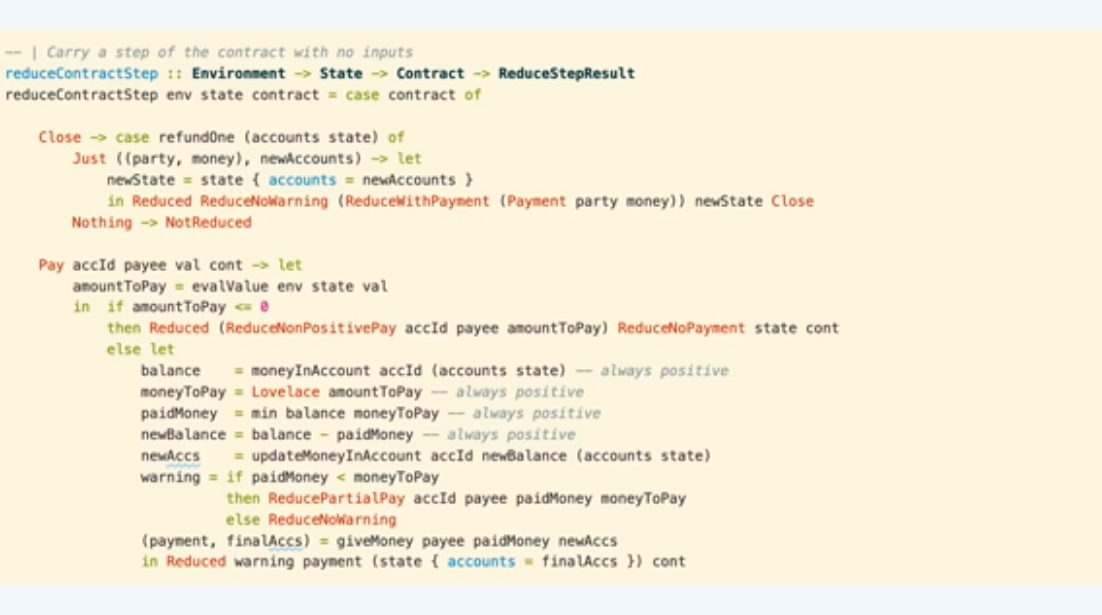
We\'ve got al we\'ve got a high level description of what the semantics are, and we\'re doing that through something that is effectively an interpreter. So we\'re defining at a high level this interpreter in Haskell for Marlowe contracts.
One really nice thing about writing it in this sort of way is that we can be sure we cover all cases because it\'s a it will be obvious if we\'re missing some cases. Writing it as an interpreter ensures that we will hit cases we need to in describing the semantics.
Also it really helps us to understand the semantics. When you\'re designing a language you have an abstract idea about what it\'s going to mean, but there\'s nothing like having a an implementation of it so you can actually run the semantics.
What would it mean if we were to add this construct? What would it mean if we were to modify the semantics in this way?
If we\'d written it in a purely purely logical format, it\'s difficult to unscramble just from the rules as they\'re laid out what, precisely, a change in rule might mean.
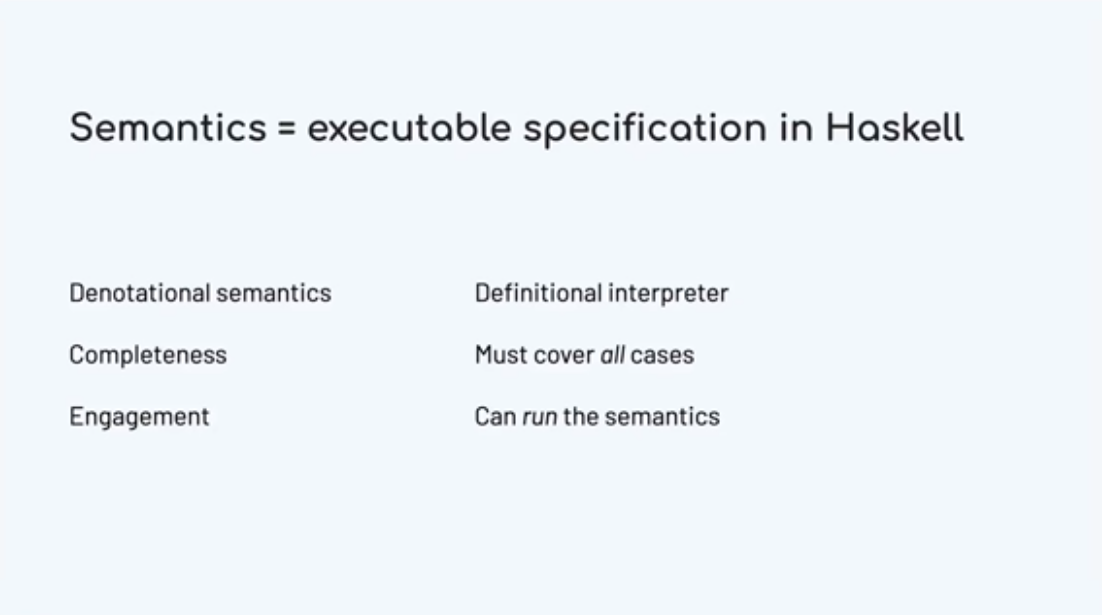
What\'s even nicer is that we can reuse the semantics in a number of different ways.
In the theorem prover Isabelle, we can use the semantics for reasoning and proof and we use pretty much the same semantics because Isabelle uses a functional language as is as its subject.
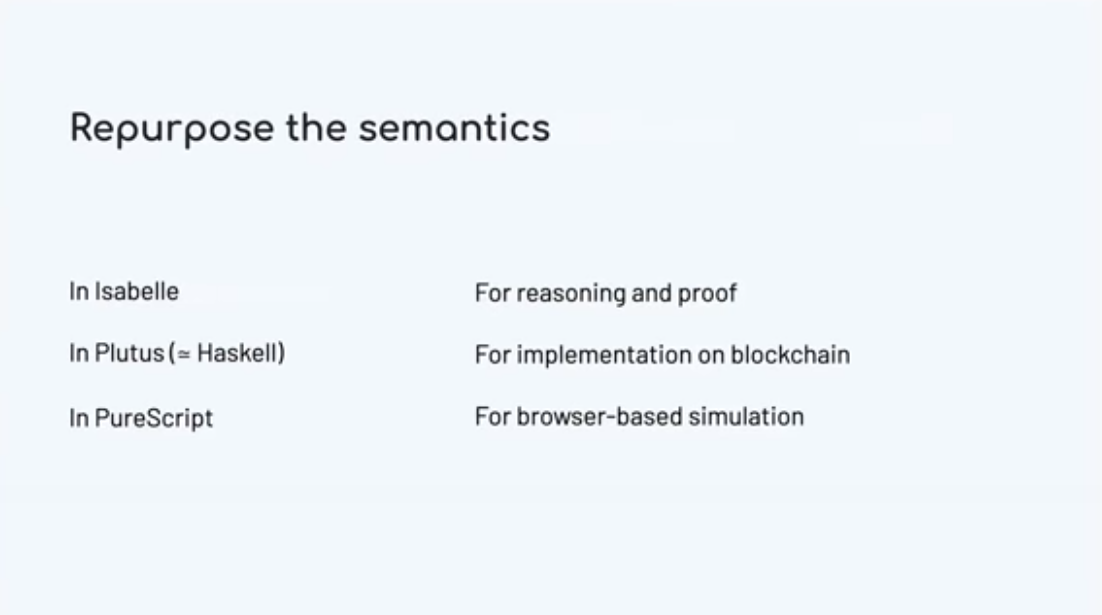
We can run the semantics in Plutus. Plutus is more or less Haskell, perhaps not with all the libraries, but we can, in principle at least, build our implementation on blockchain from our semantics, and also we can translate the semantics into PureScript for simulation in the browser.
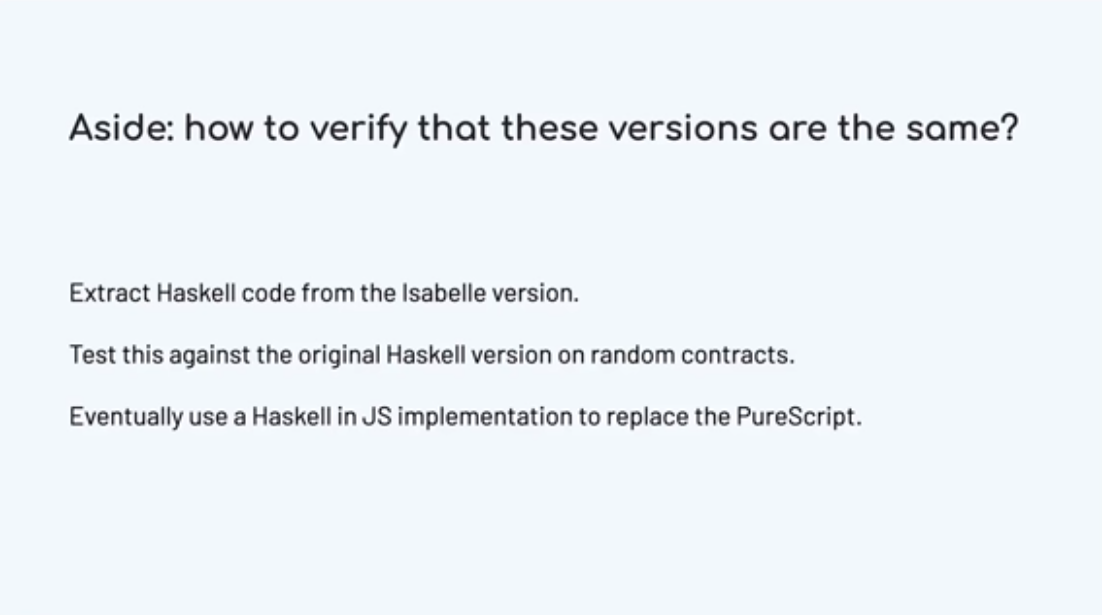
Now pure script is not the same exactly the same as Haskell. Isabelle\'s language is not exactly the same as Haskell. How can we be sure that all these versions are the same?
One way of doing it is to extract Haskell code from Isabelle and test the original against um this extracted code. We do that on random contracts and that gives us a pretty high level of assurance that the two are the same.
Down down the line in our road map we certainly expect to be using a Haskell and Javascript implementation at some point to replace PureScript in the front end so we don\'t have to write a PureScript version of the semantics when we\'re doing the off chain interpretation building the transactions to be submitted. We can use the real haskell implementation by compiling it into Javascript and running that in Marlowe Run in the client code.
So, building the language in Haskell means that though we use various different versions of the semantics, we can get a high level of assurance that these are the same and indeed we can in some situations replace things like the PureScript by Javascript.
Usability
That gives us a picture about how how the system is put together. Let\'s go to another aspect of Marlowe. We we talked about it being a special purpose language, and that being a DSL promoted usability.
Let\'s say a bit more about that.
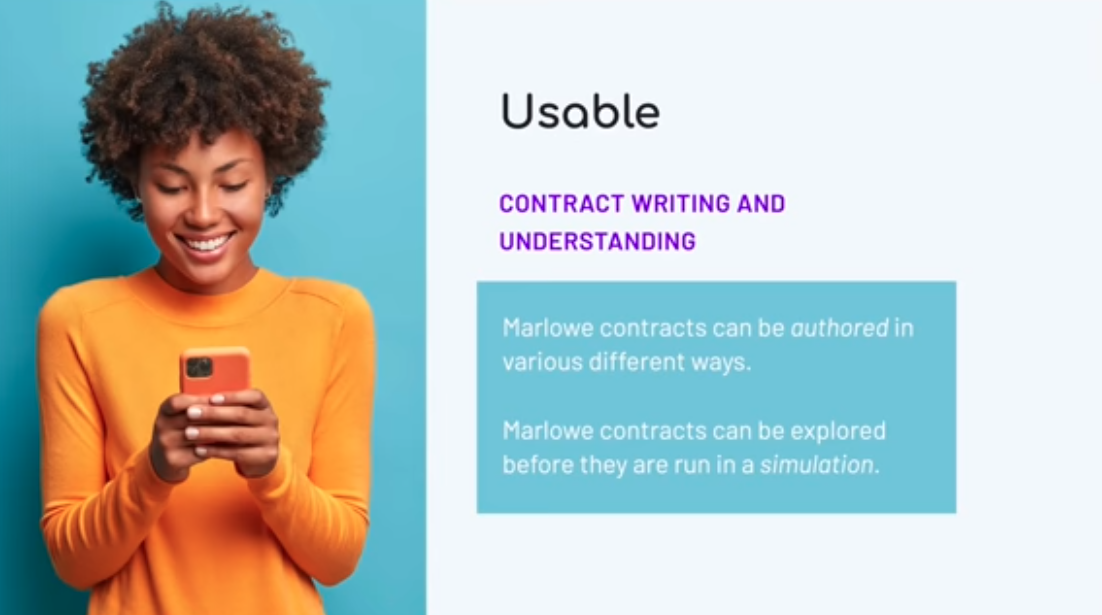
One way we we promote usability is that we provide different ways of writing contracts. Another way we promote usability is to allow people to explore interactively how contracts behave before they\'re actually run in the simulation.
So let\'s talk about those now.
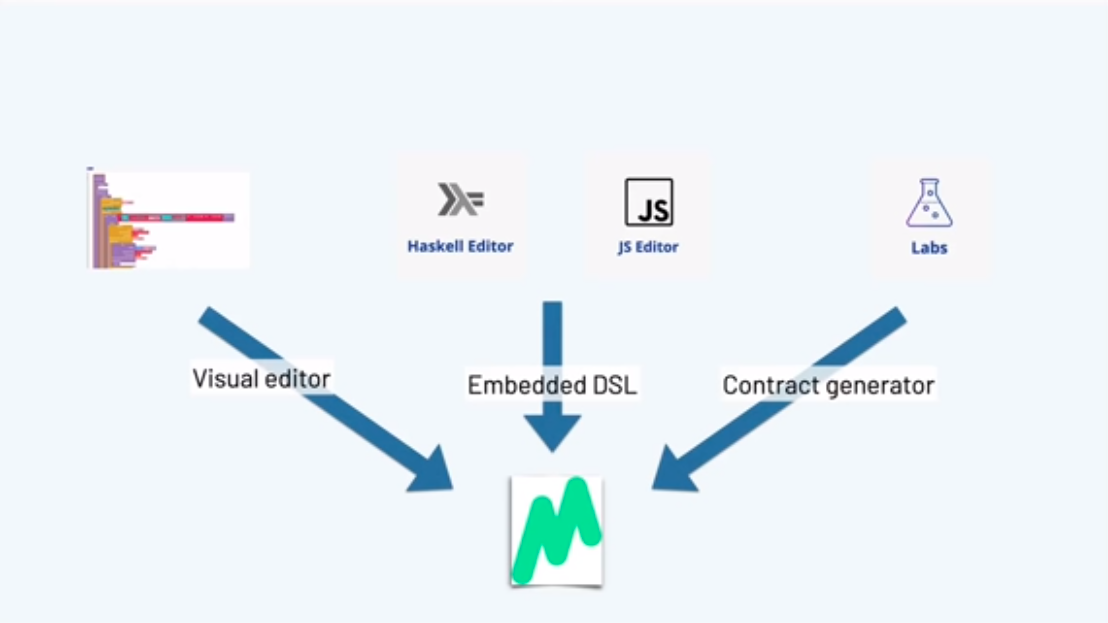
We want to write a Marlowe contract, how can we do it? Well, we can write Haskell using the Marlowe data type as text. That\'s one way we can do it and that\'s fine. We have an editor for that inside the playground that supports code completion and will make suggestions and and so on.
So we can build the contracts as pure Marlowe, but there are other routes as well.
We have a visual editor for Marlowe so that you can produce Marlowe contracts visually, putting together blocks in a way that doesn\'t require you to be a confident programmer. You can start off by using the visual version as a way of learning to engage with Marlowe if you are a coder.
Marlowe is embedded in Haskell and in Javascript so we can use facilities like recursion to describe Marlowe contracts. We can say, in Haskell, let\'s do this particular pattern of behavior a certain number of times. We can write that in Haskell and then for a particular contract we convert the Haskell into Marlowe, and we can also do that for Javascript.
Finally, something we\'re not going to talk about anymore in this talk is that we can generate contracts from initial conditions. We\'ve been looking at that for the actor standard of financial contracts. On the basis of the contract terms we generate code in Marlowe. We write functions whose output is Marlowe code.
We provide users with a variety of different approaches, leveraging knowledge of Javascript, for example, or leveraging a non-code-based approach for describing the contracts
We also allow people to simulate the behavior of contracts. This is something that you can see in the current version of the Marlowe Playground.
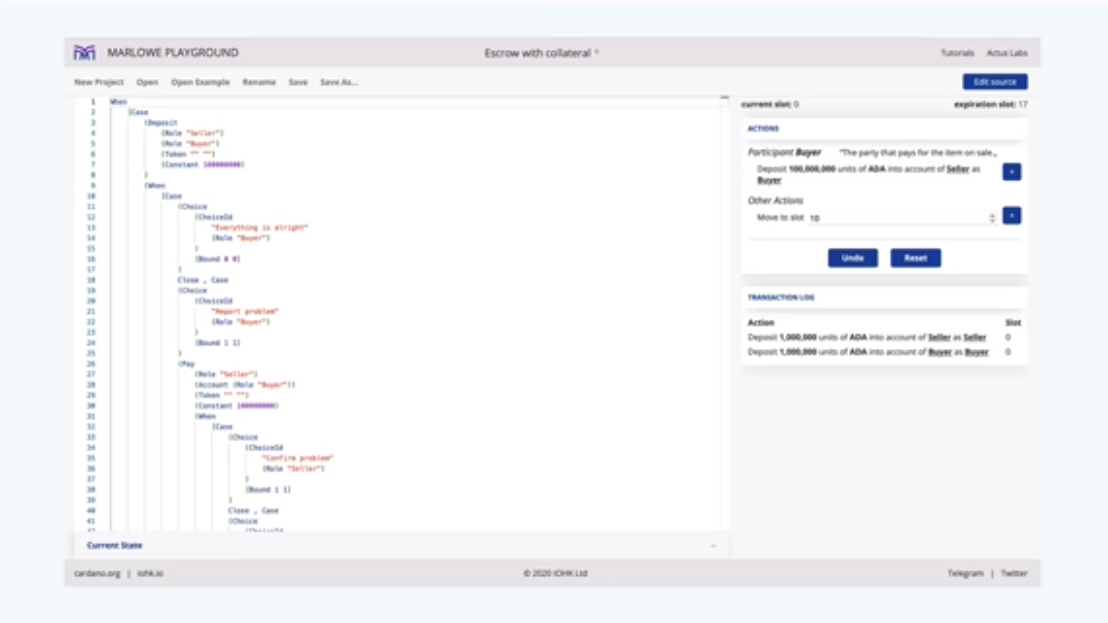
That\'s something you can play with yourselves. We are looking at different ways of describing the results of a simulation. So at the moment we have a transaction log. We are allowed to choose an next action to perform, you can undo the last step to take you back and then try another path so you can step interactively backwards and forwards through the source code through the application of the contract.
What we\'re looking at is changing the user interface Marlowe Playground so that we\'ll use something rather more like the Marlowe Run run description of a running contract.
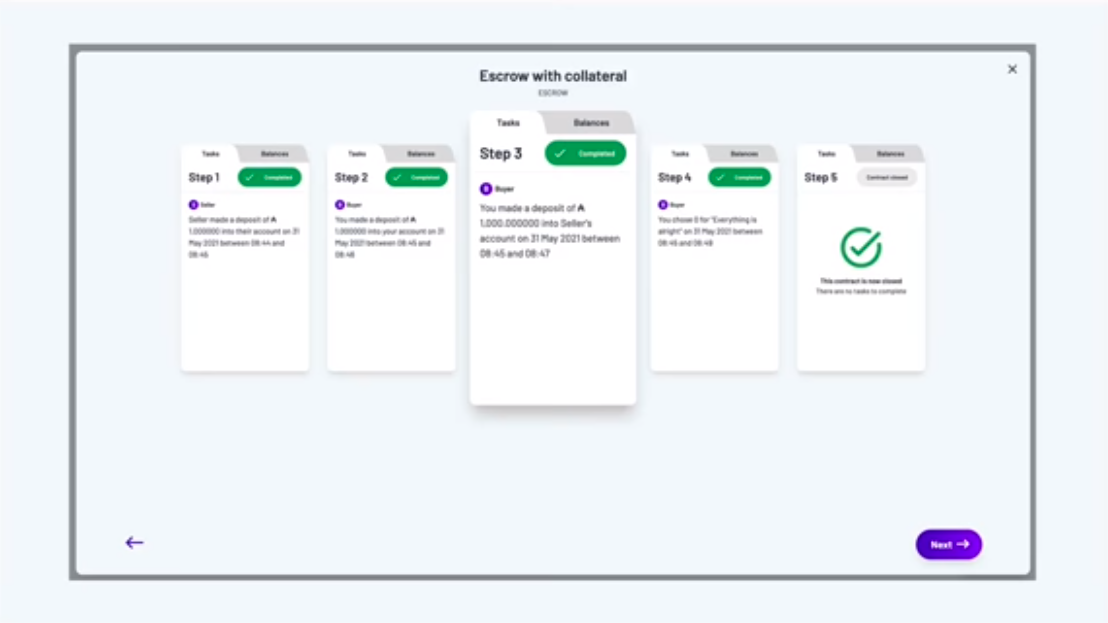
Assurance
We\'ve talked about usability. What about the sort of assurance that Marlowe can give users?
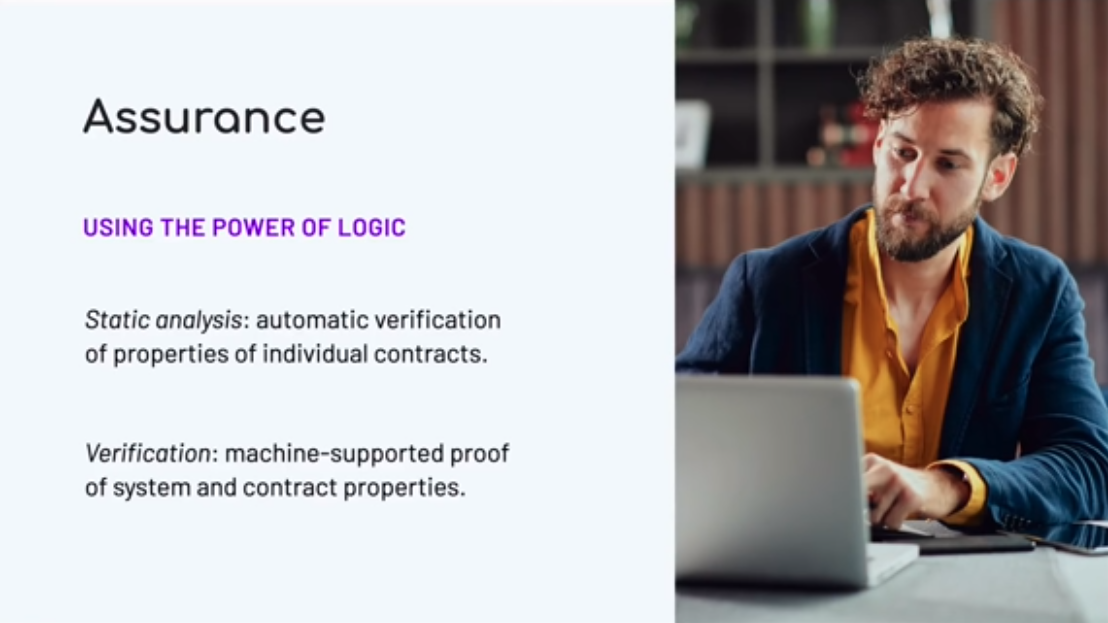
We\'ve seen we\'ve seen that making the system transparent, that making code readable is itself an advantage. We\'ve seen that there\'s simulation to give people to validate their intuition about a contract.
But rather more formally we can use the power of logic to do two things for us. We can do what\'s called static analysis so we can automatically verify properties of individual contracts. That means we can guarantee this contract will behave as it should, checking every route through the contract.
Also we can do machine-supported proof so, not automatic any longer, written by a user, but we can prove properties of the overall system.
Static Analysis
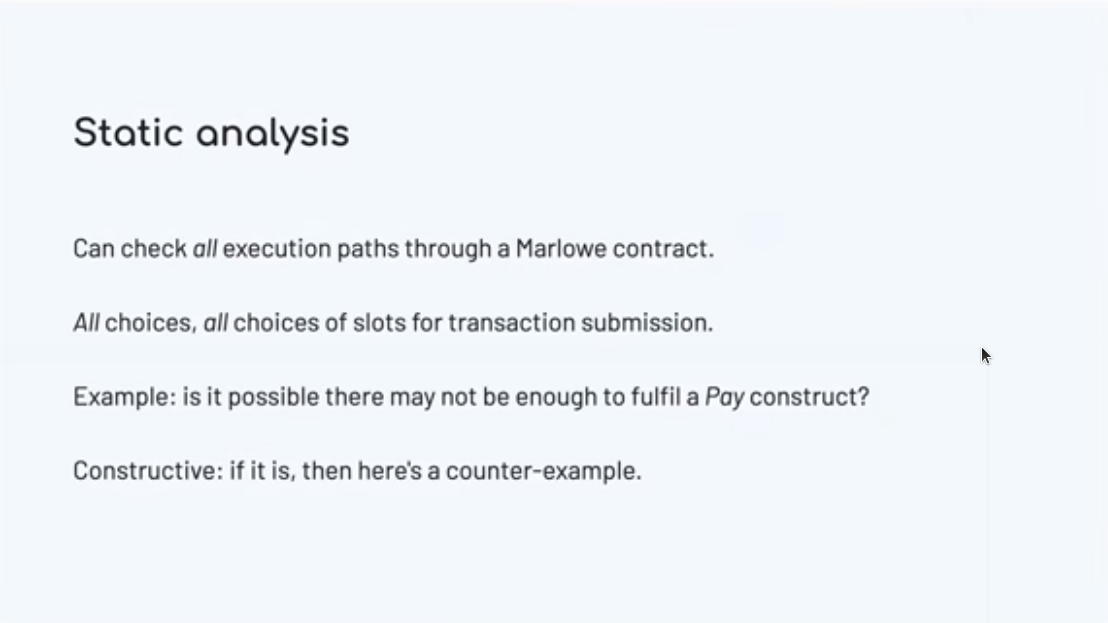
What static analysis allows us to do is check all execution paths through a Marlowe contract. All choices, all choices of slots for a submission of a transaction so we examine every possible way in which the contract might be executed.
The canonical example here is the example of whether a pay construct might fail. Is it possible a pay construct could fail? The answer is that we will use what\'s called an SMT solver An SMT is an automatic logic tool - the one we use is called Z3, although others are available. The SMT solver effectively checks all execution parts.
If a property is is satisfied that\'s fine, we get get the result. If it\'s not satisfied, we get a counter example. We get told that there\'s a way through this contract that leads to a failed payment - a payment that can\'t be fulfilled. So it gives an example of how it can go wrong, and that\'s really helpful. It means that if you really want to make sure that a failed payment can\'t happen, then this gives you a mechanism to understand and to debug how that eventuality can happen, and so gives you a chance to think about how to avoid it.
So, very powerful and entirely push button. You push a button and you get the results.
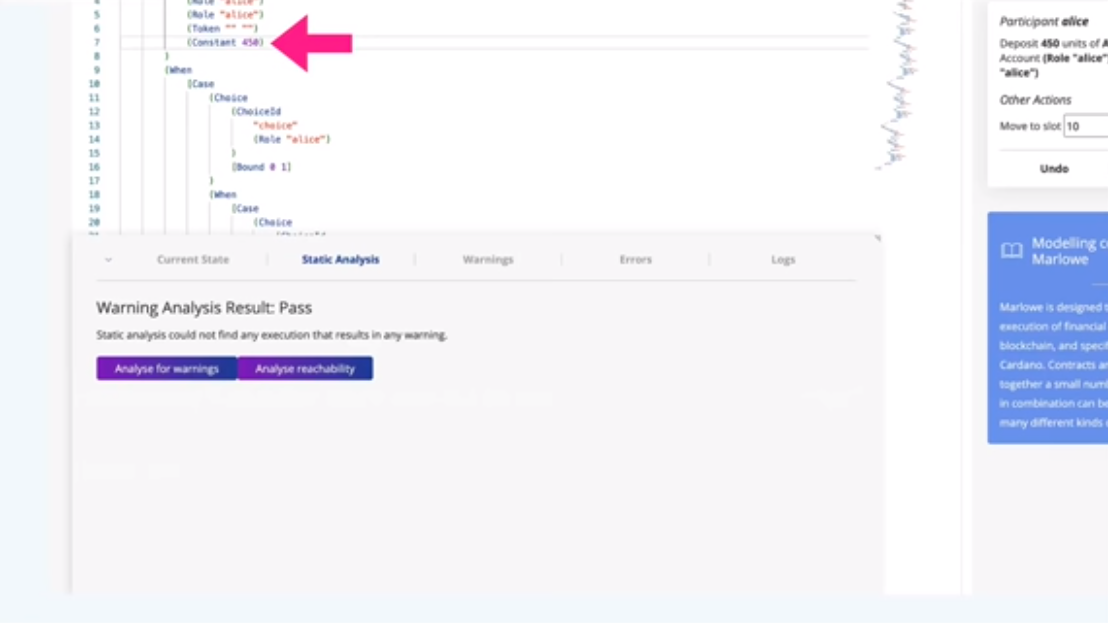
Here you see a fragment of a Marlowe contract. It\'s an escrow contract where the contract starts with a deposit of 450 lovelace.
Checking the analysis in the playground, we\'ve got the results. Static analysis could not find any any execution that results in any warning, so that\'s saying that you\'re okay - it\'s not going to give you a warning whatever you do.
But if we change that deposit of 450 lovelace to a deposit of 40 and analyze we then get this warning.
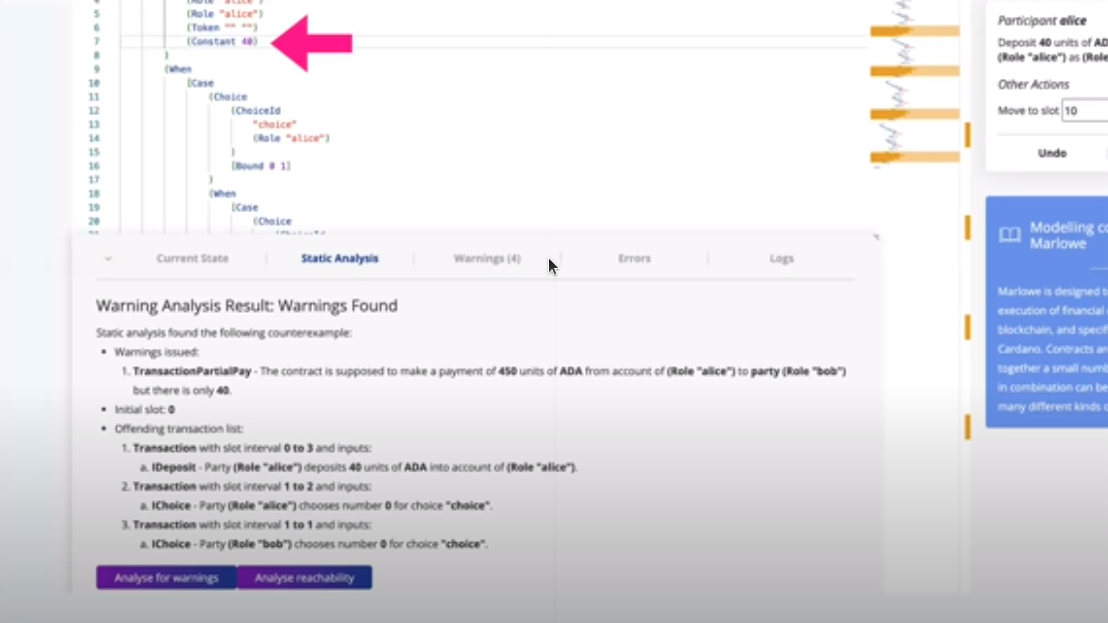
We get a transaction partial payment. We\'re told that we get to a payment where we\'re meant to pay 450 units of lovelace but there are only 40 available, and we get given a list of transactions that take us there.
So we\'re able to see from that how we got to that point, and the problem is that we didn\'t put enough money in and then we reached a place where we needed to make a payment of 450 lovelace.
So it\'s easy for us to see that we need to either make the payment smaller or make the initial deposit bigger. As it\'s entirely push button, we get that sort of assurance for free, as it were.
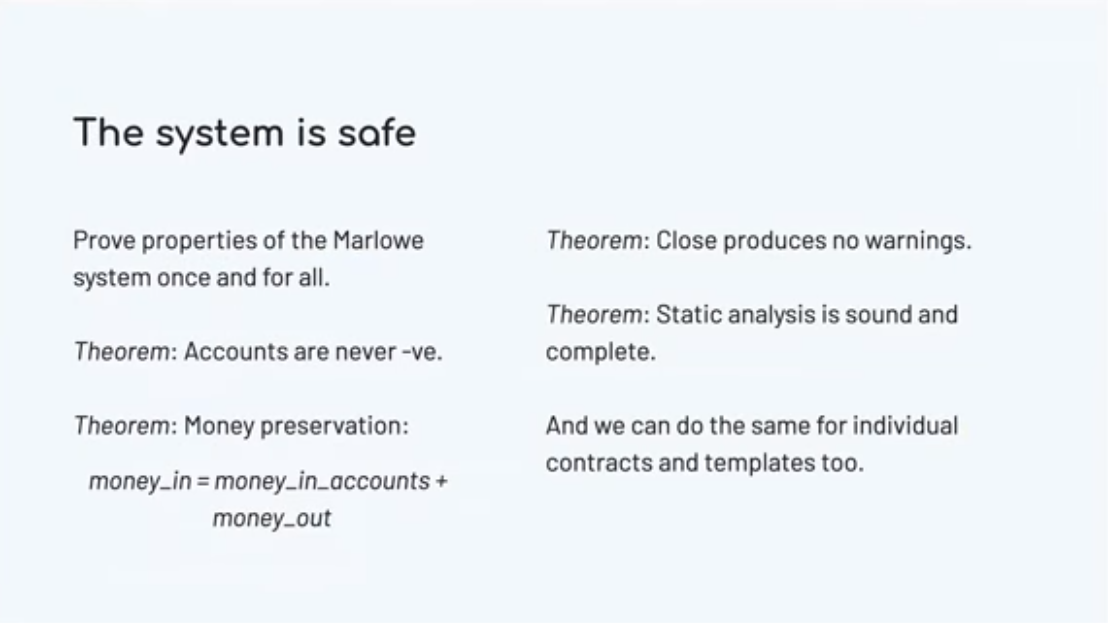
But thinking about verification, we can do rather more than that. We can prove properties of the system once and for all.
So, for example, we can prove from the semantics that accounts inside a Marlowe contract never go negative. You can\'t ever overdraw an account in a Marlowe contract.
We can also prove this theorem of money preservation. We can prove that if we look at all the money that\'s gone into the contract so far, that\'s equal to the sum of two things - the amount of money that\'s held inside the contract plus the amount of money that has been paid out. That gives a clear picture of money preservation.
We\'re also able to to prove other more technical things about the system. For example, that a Close construct will never produce any warnings. So, if we\'re analyzing for warnings, we don\'t need to worry about Close constructs. That allows us to optimize the static analysis.
We\'re also able to prove that the static analysis, which makes a number of simplifications to speed things up, is sound and complete. That means the static analysis will give us an error warning when the real contract can generate an error warning and it won\'t give us an error warning if the real contract can\'t do that.
One thing that we haven\'t done but is on our road map is to do these sorts of proofs for individual contracts or individual contract templates. Things that we can\'t necessarily prove with static analysis, we can prove by proving them by hand.
The system is amenable to having these proofs written about it, and they give us the highest level of assurance about how it works.
We\'ve said enough for the moment about Marlowe. Where can you go to find out more?
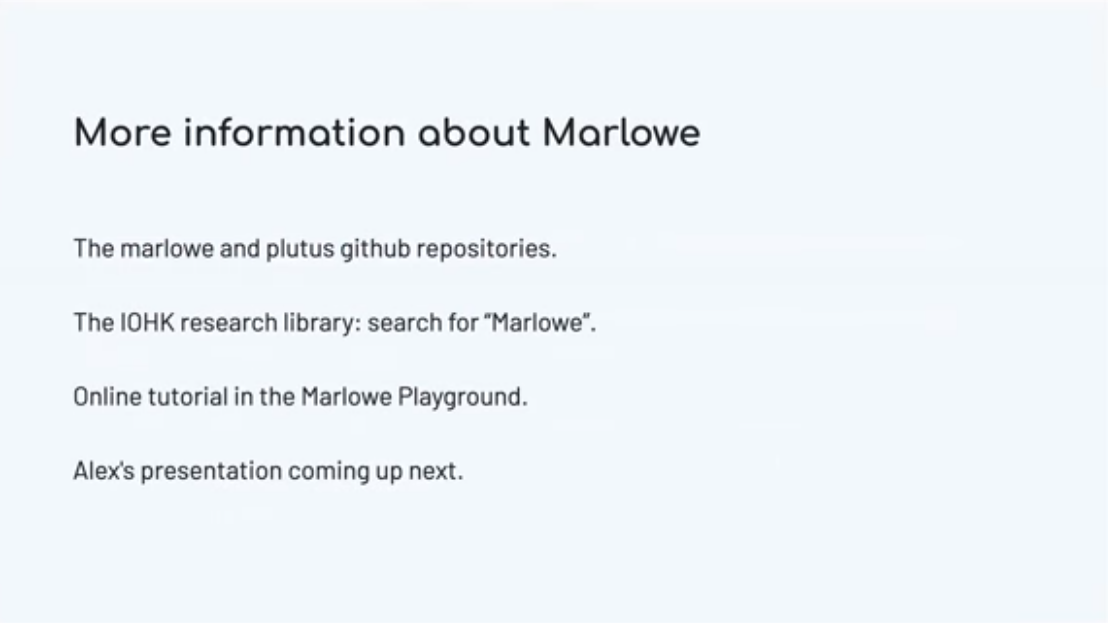
There\'s a Marlowe GitHub repository that has the semantics and the basics about Marlowe.
Quite a lot of the implementation of the tools from Marlowe is in the Plutus repository because it has that repository as a dependency.
If you look in the IOHK online research library and search for Marlowe you\'ll find a number of research papers we\'ve written about how the system works.
You\'ll also find an online tutorial in the Marlowe Playground.
Finally, Alex is going to give some more information in his presentation coming up next.
Summary

Just to summarize, what we have in Marlowe is a DSL, a special-purpose language for financial contracts, running on top of Plutus. Because it\'s a DSL it allows us to give assurance that is harder to give for a general purpose language. And we get assurance of they way contracts should and shouldn\'t behave.
It also allows us to to orient its design around users as well as developers. The language is simple and therefore we get readability.
We also get simulatability and we get these stronger assurances of static analysis and verification.
Lecture by Alex Nemish
Alex Nemish is one of the Marlowe developers and in this presentation, he shows us a bit of Marlowe semantics and Marlowe PAB (Plutus Application Backend) contracts.
We\'ll start with a brief description of Marlowe Semantics that\'s implemented in the Semantics.hs file. Then we\'ll look at the PAB contracts.
Here are the main data types for Marlowe.
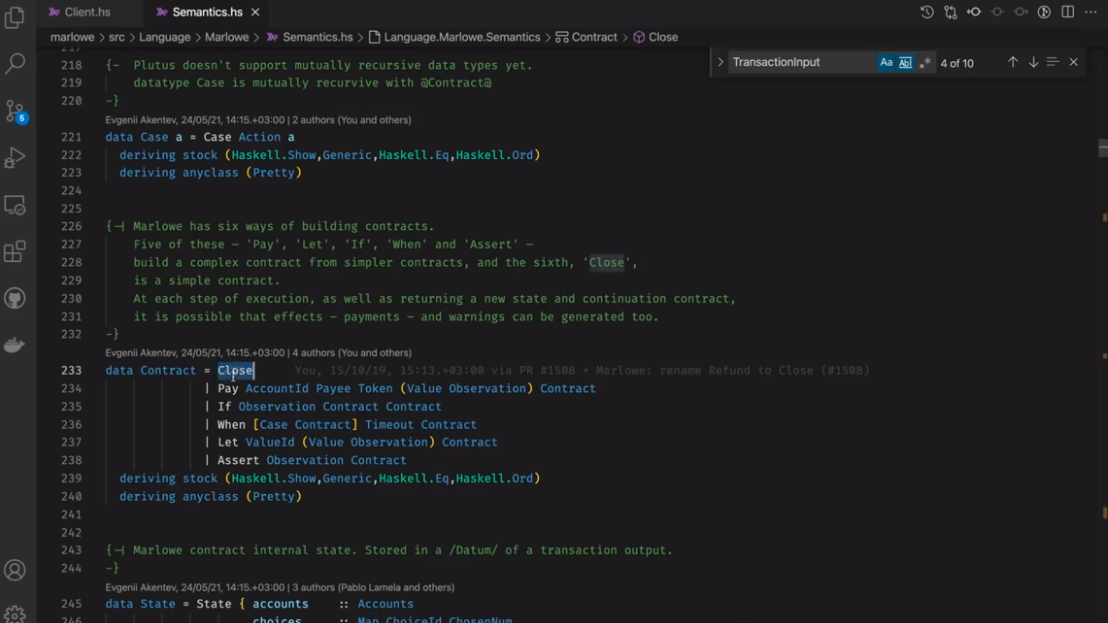
It\'s a contract. Essentially those are six constructors that you can start to model a contract with and here\'s the state that is going to be stored on a blockchain.
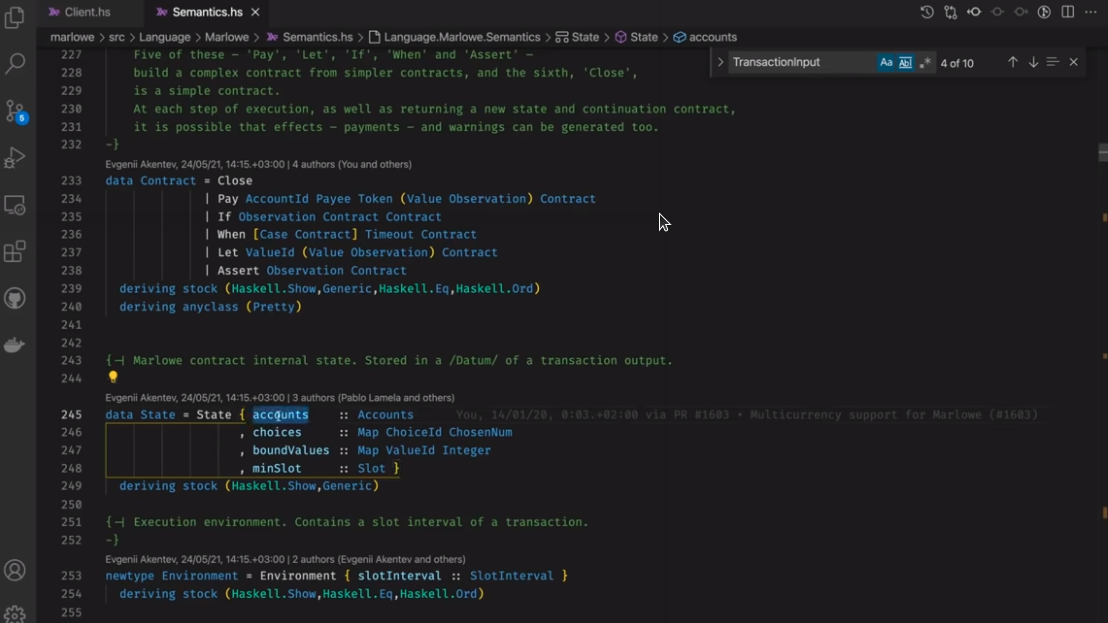
So we have a state of balances of accounts by party, we have a map of choices, we have bound values which come from the Let constructor, and a minSlot which is the first slot that the contract sees.
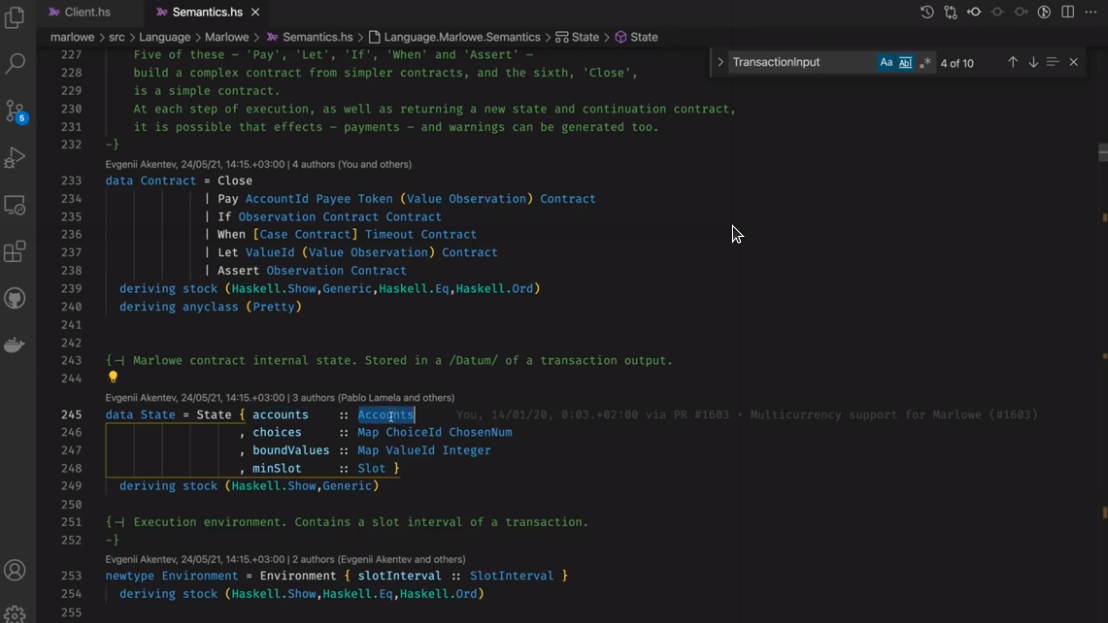
The Input data type essentially contains actions for a Marlowe contract. It is either a deposit, a choice, or a notification.
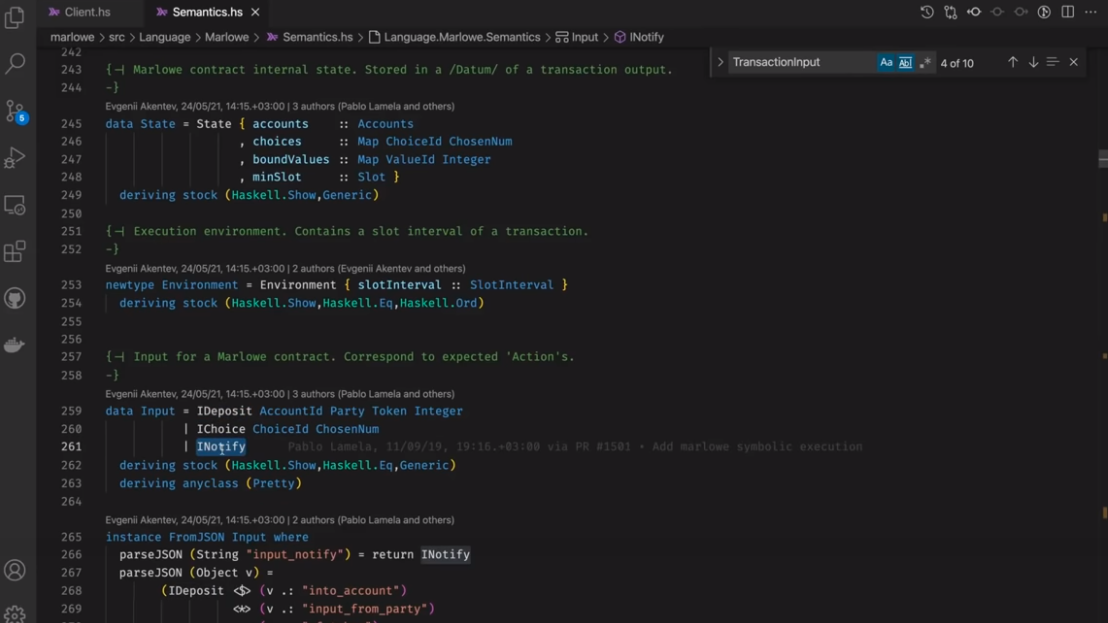
Here is the TransactionInput datatype. This is what we give as an input. Every transaction has a defined slot interval and a list of inputs.
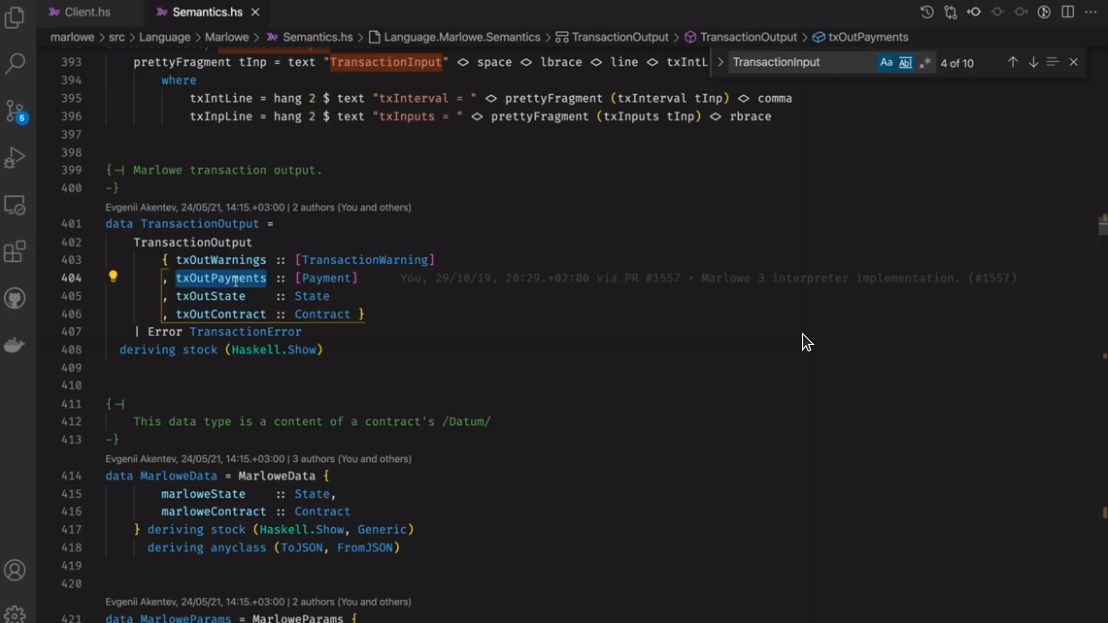
And we have TransactionOutput which contains the payments that we expect to happen, the output state and the output contract.
We also see MarloweData which is essentially what is going to be stored on the blockchain. It\'s the current state of a contract as well as the actual contract.
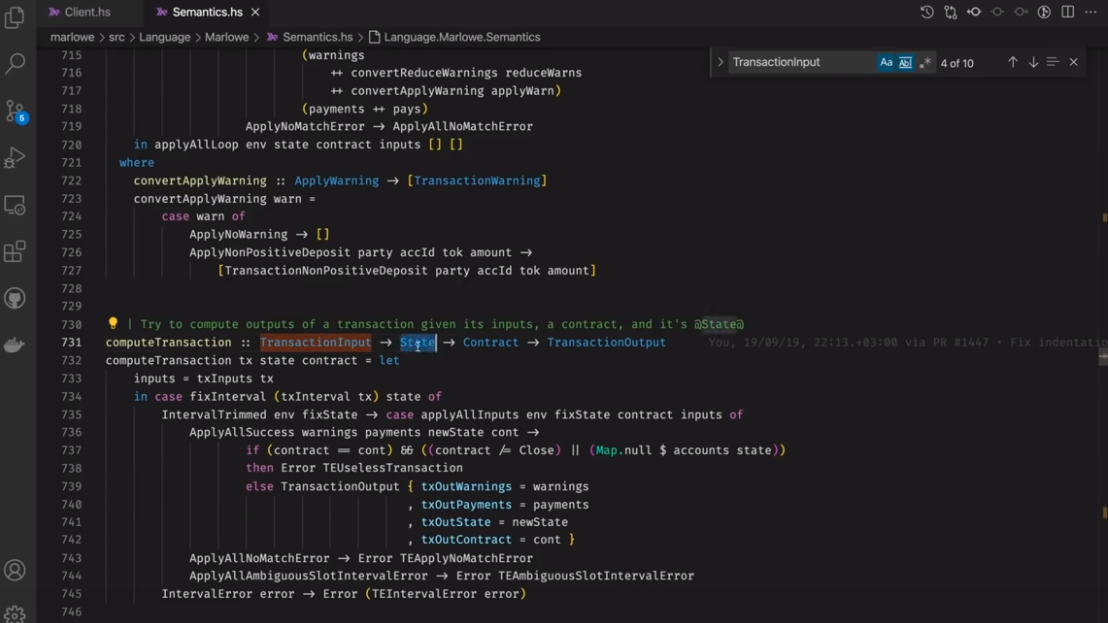
The entrance to the semantics is the computeTransaction function. It gets the transaction input, the current state and the current contract and returns the transaction output.
First of all we check the slot interval for errors. For example, we do not allow the slot interval to contain any timeouts. If you have a contract with a When construct of 10, you cannot produce a contract with a slot interval of 5..15 because it will contain a timeout.
Then we apply all inputs and if this is successful we return the transaction output with any warnings we have found, the payments we expect, the new state and the continuation contract.

So what happens in applyAllInputs?
First of all, it\'s a loop. It uses the reduceContractUntilQuiescent function which reduces the contract until it reaches a quiescent state. Once we reach a quiescent state, we take the first input and try to apply it, and then continue with the loop, until we get an empty input list. Then we return the current state and the continuation contract.
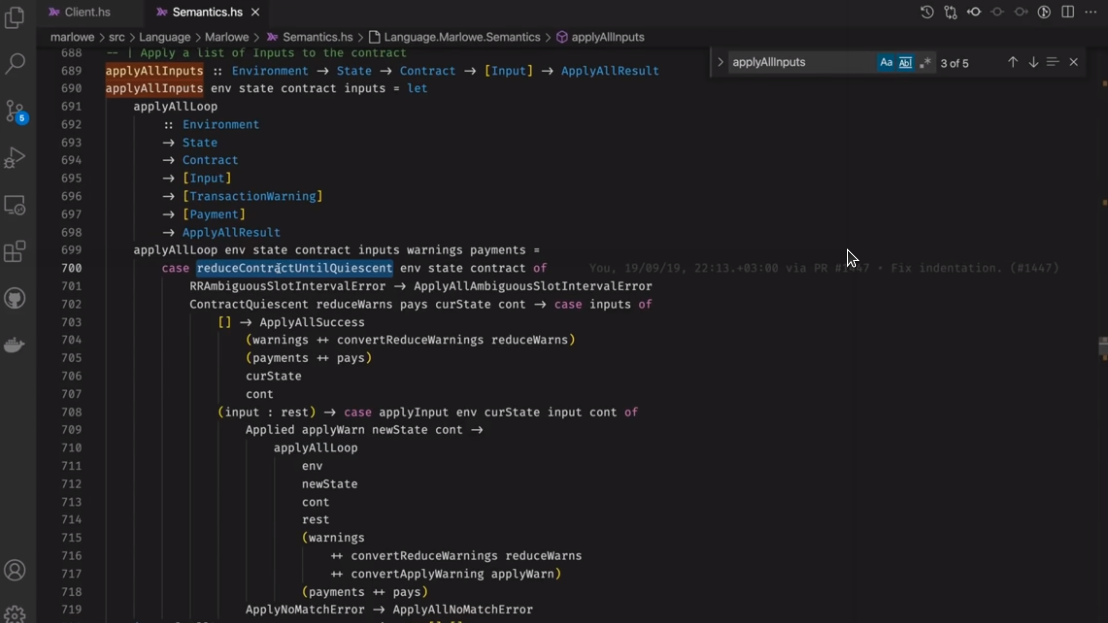
The reduceContractUntilQuiescent function goes through a loop and tries to apply reduceContractStep which essentially evaluates a contract.

If we get a Close then we are in a quiescent state. If we get a payment, then we evaluate it, update the balances and then return the reduced contract.
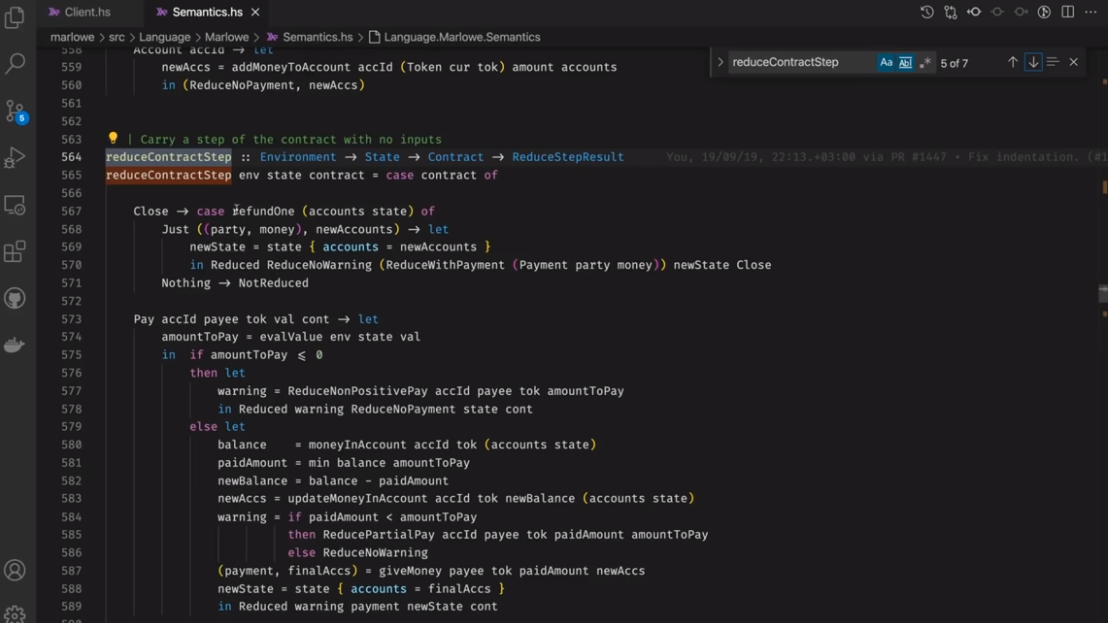
We do the same for If, Let and Assert. But for When, we only evaluate it if it\'s timed out, otherwise we say that it\'s not reduced, and that the contract is quiescent.
In a nutshell, Marlowe contract evaluation consists of two steps.
- We reduce the contract until it is quiescent - it\'s either closed or we get to a When that\'s not timed out yet.
- We try to apply inputs and evaluate the contract further.
Let\'s see how it works from the client side.
As you may have noticed, the Marlowe semantics code is quite abstract and it doesn\'t depend on the Cardano system\'s actions. So let\'s take a look at the actual Marlowe validator that\'s being executed on-chain.
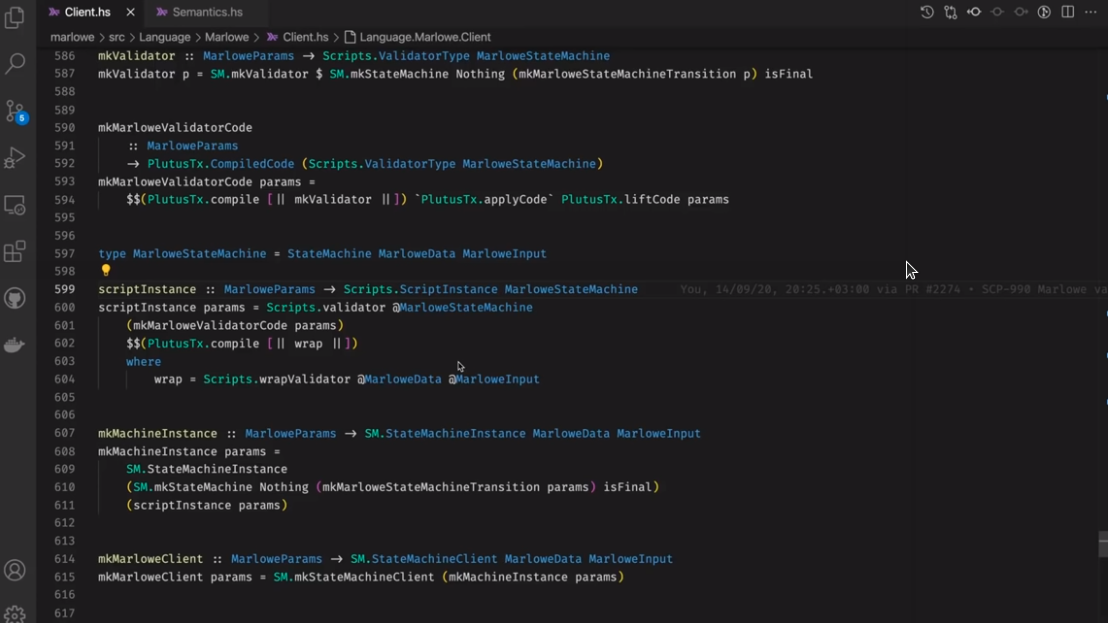
Here\'s the scriptInstance which calls the mkMarloweValidator code, which in turn calls mkValidator, which uses a state machine library function mkStateMachine to which is provides two functions - a transition function and a finality check.
The finality check is very simple - we just check the the contract contract is constructed with Close.
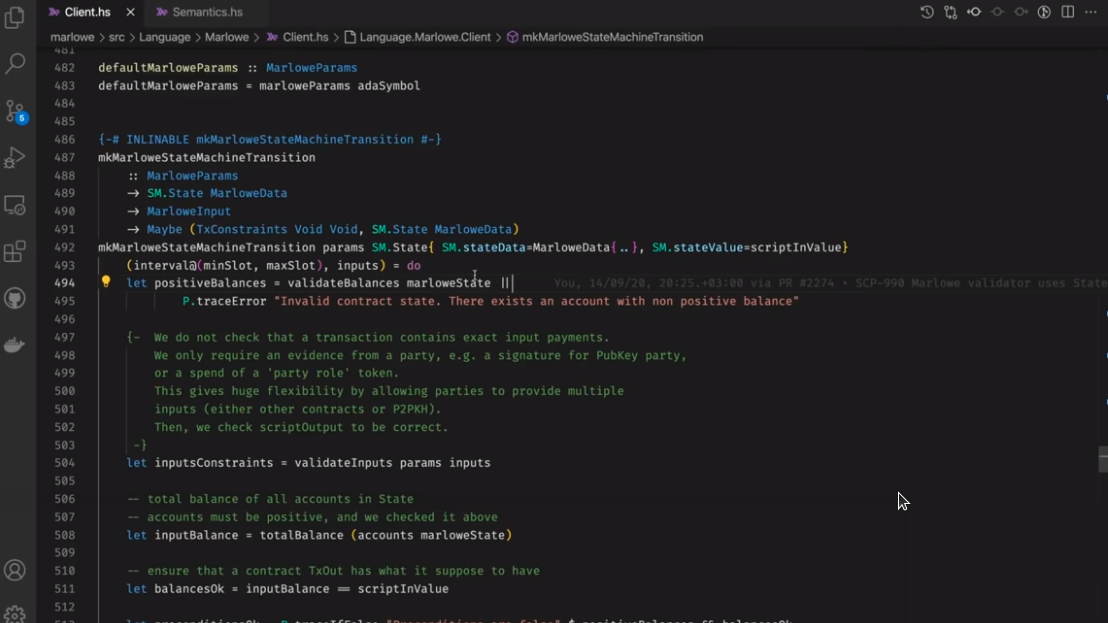
The transition function is the meat of the validator.
It takes MarloweParams - which we\'ll talk about later, it takes the state of the state machine MarloweData, it takes MarloweInput which is essentially transaction input expressed in Cardano types. It will then return either Nothing in the case of error, or a new state along with zero or more constraints.
We check that the balances are valid - we require balances to be positive.
Then we create input constraints based on the inputs. So, in the case of deposits we expect that money will go into a contract. In the case of choices, we expect witnesses of the respective parties. We calculate that the contract contains the correct balance.
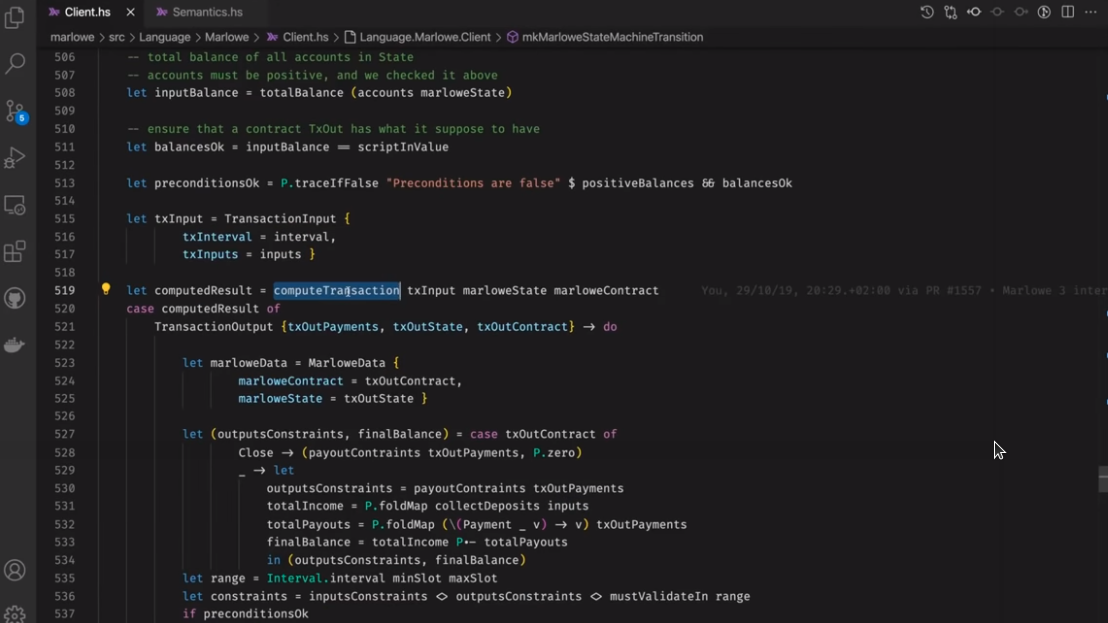
We construct a TransactionInput given the slot interval and list of inputs, and we call the computeTransaction function that we saw in semantics.hs.
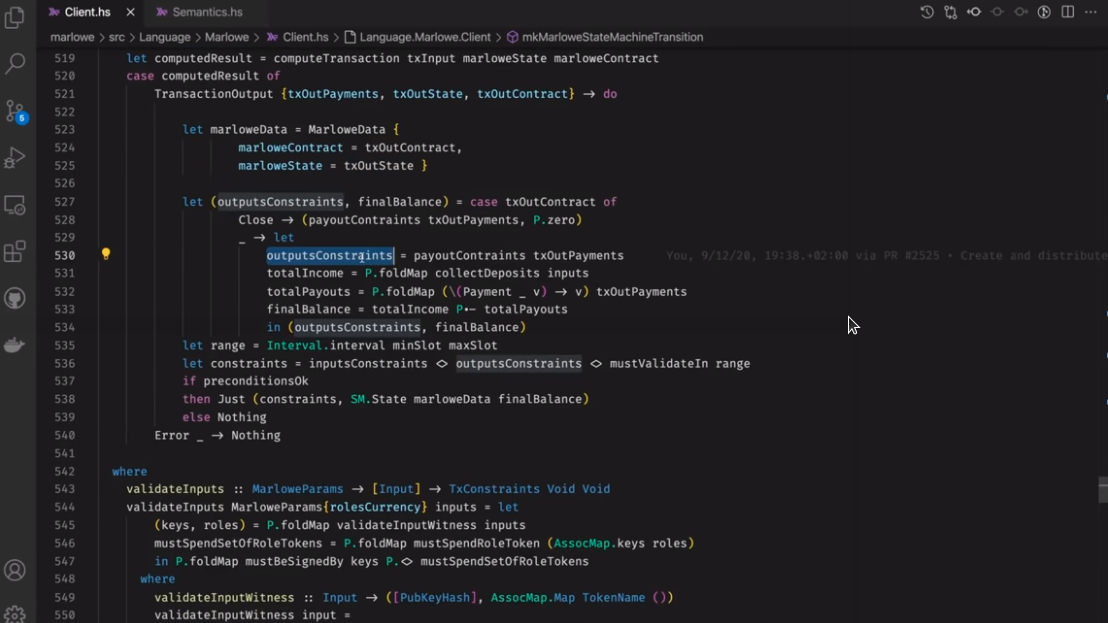
With the computed result we construct a MarloweData with a new contract continuation and updated state. We produce output constraints that produce payouts to the respective parties, and we calculate the new balance. Then we combine all the constraints with range validation.
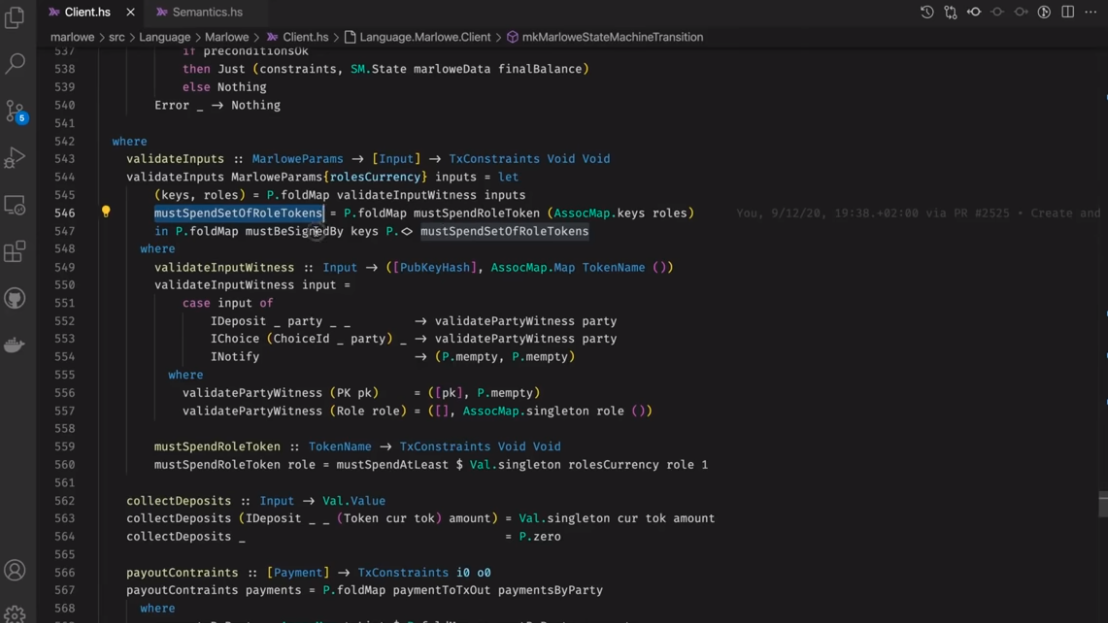
To validate inputs, we check that the required signatures and role tokens are present.
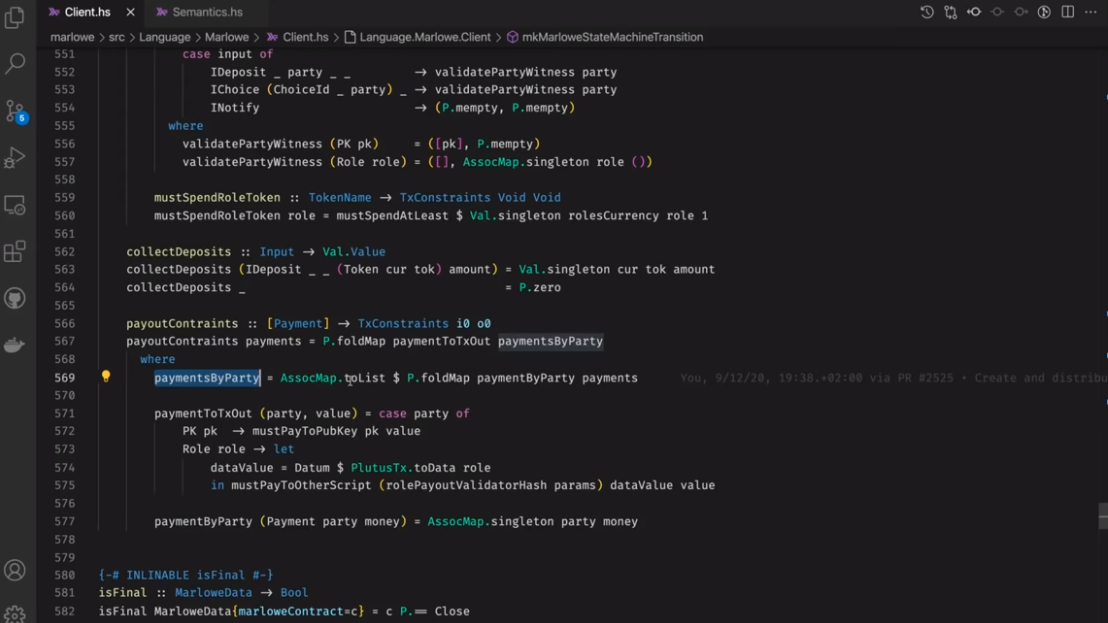
Payments to parties go either to a public key, or go to the validator rolePayoutValidatorHash, which simply checks, given a currency, that a transaction spends a role token.
For off-chain execution, we provide three Marlowe PAB contracts.
- Marlowe Follower Contract
- Marlowe Control Contract
- Marlowe Companion Contract
Follower Contract
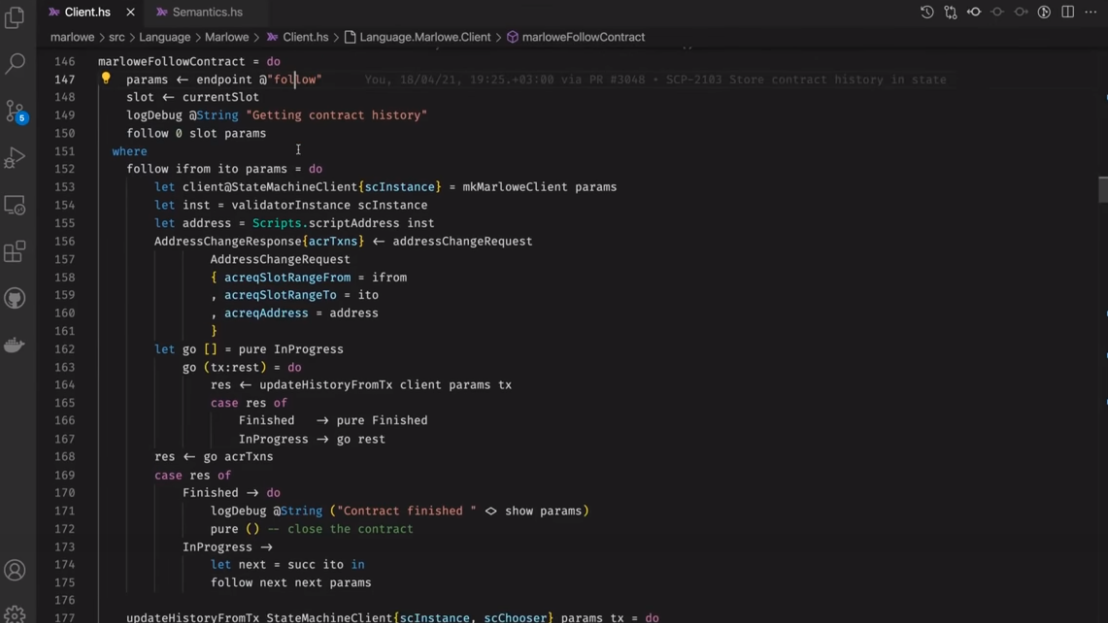
This is a very simple one - it contains only one endpoint called follow. It subscribes to all changes to a Marlowe contract validator address, so that we can store all the inputs that are applied to a Marlowe contract.
It uses the updateHistoryFromTx function which, in a nutshell, finds a Marlowe input and constructs a TransactionInput data type, and uses tell to update the PAB contract state.
If you were connected to a web socket for this contract, you would be notified about transition changes.
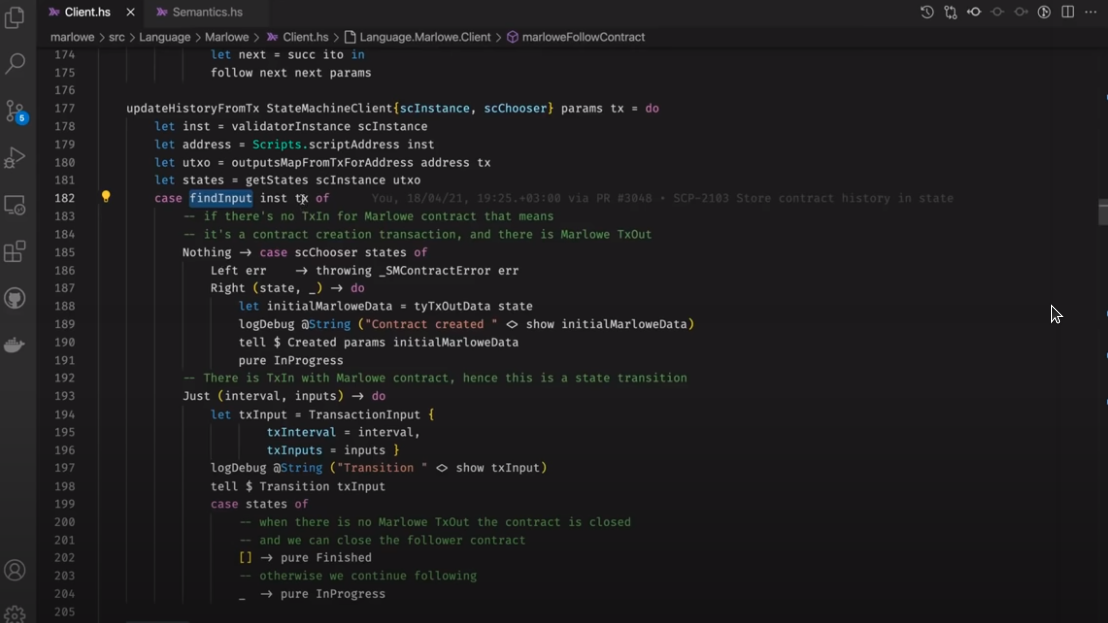
The state of the contract is stored in ContractHistory, which stores an initial MarloweParams, an initial MarloweData and a list of all TransactionInputs that were applied to this contract. You can always restore the current state by applying a list of inputs to an initial state.
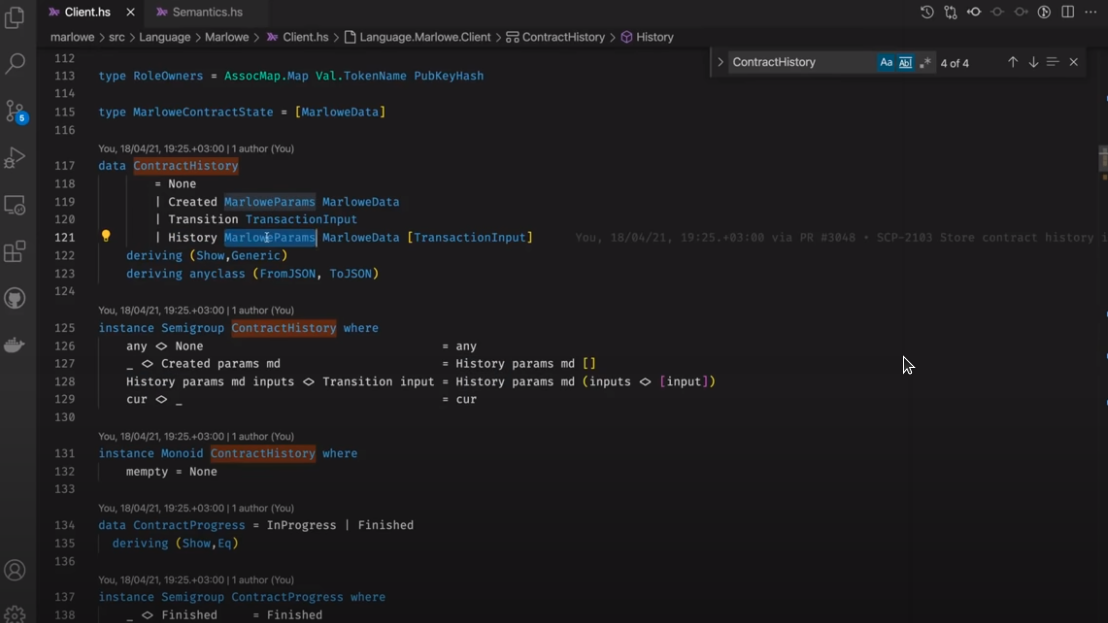
Control Contract
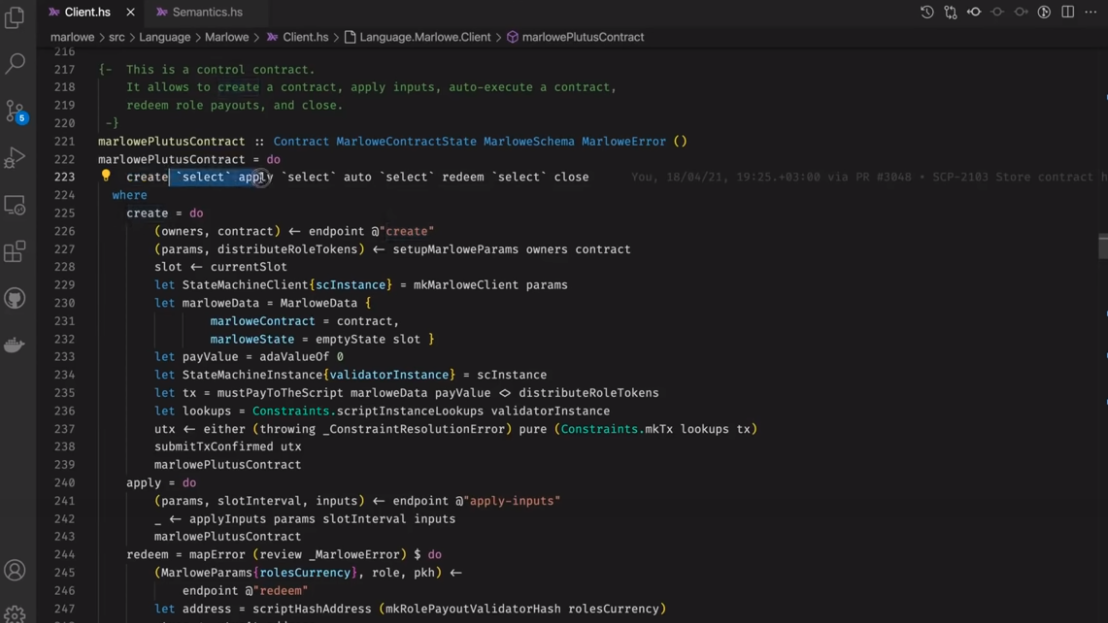
The marlowePlutusContract is a control contract. It allows you to create an instance of a Marlowe contract, apply inputs to the instance, to auto-execute the contract, if possible, to redeem tokens from payments to roles, and to close the contract.
Let\'s go through Marlowe contract creation.
Create Endpoint
When you call the create endpoint, you provide a contract and a map of roles to public keys. We then setup a MarloweParams.
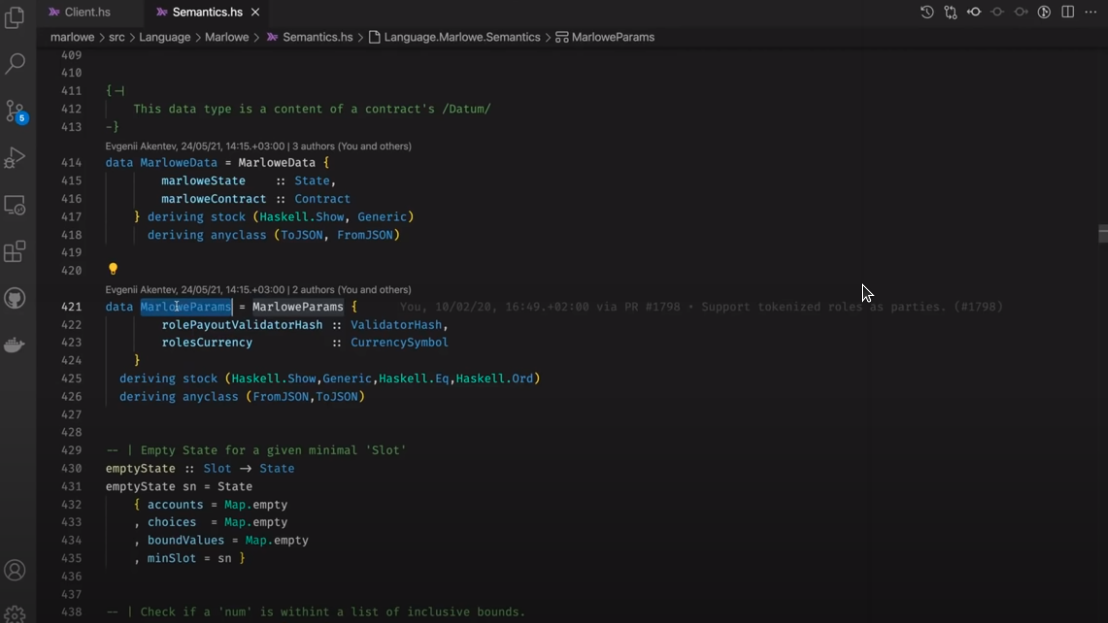
MarloweParams is a way to parameterise a Marlowe contract. You can specify your own role payout validator by providing its hash. There is a default one that checks that the role token is spent within the transaction but you can do whatever you like.
When your contract uses roles, we need to know the currency symbol for the role. When the contract uses roles, we need to create role tokens and distribute them to their owners.
In the setupMarloweParams function we get the roles that are used within the contract. If we have owners for these roles, we create tokens with role names. By default we create one token per role. We use the Contract.forgeContract function to create the tokens and then assign them to the creator. Then, in the same transaction, we distribute the role tokens to their owners.
Next in the control contract, we use the state machine library to create a state machine client and submit the transaction.
Apply Endpoint
The apply endpoint is very simple. We call the applyInputs function.
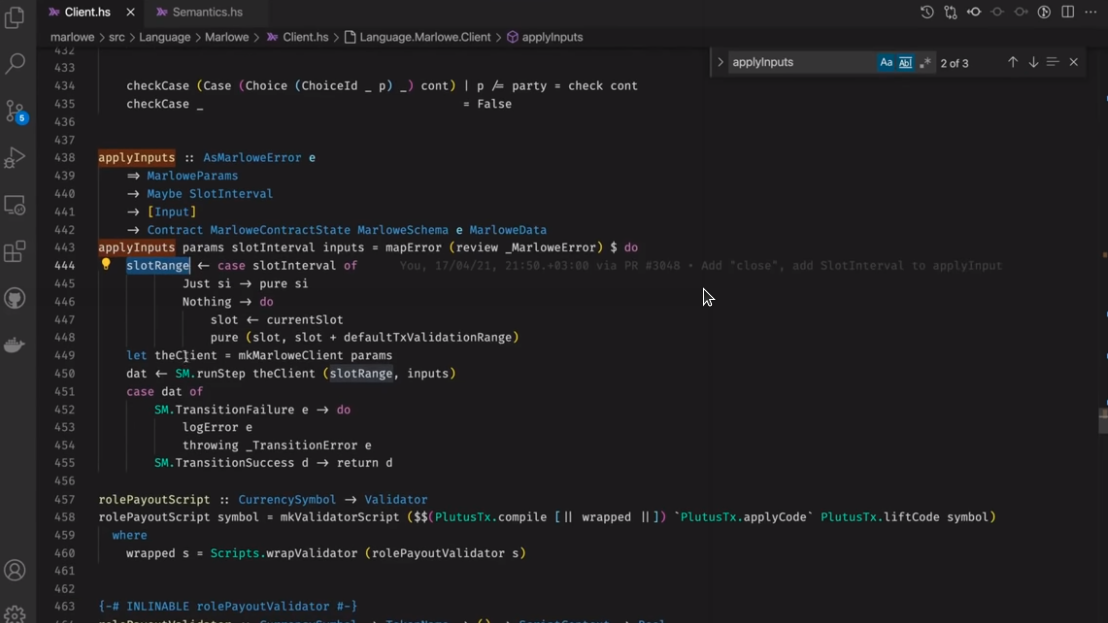
We construct a slot range and we use the runStep function which takes a slot range and a list of inputs.
Redeem Endpoint
The redeem endpoint allows you to get money that has been paid to a role payout script.
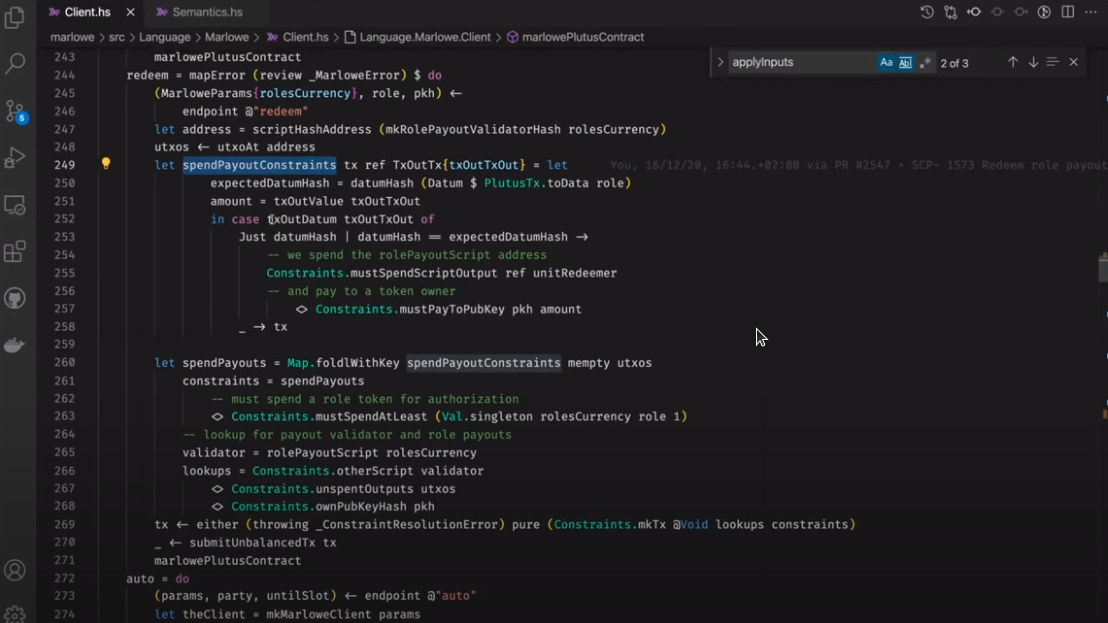
We get the address of the script and then send all the outputs to the token owner.
Auto Endpoint
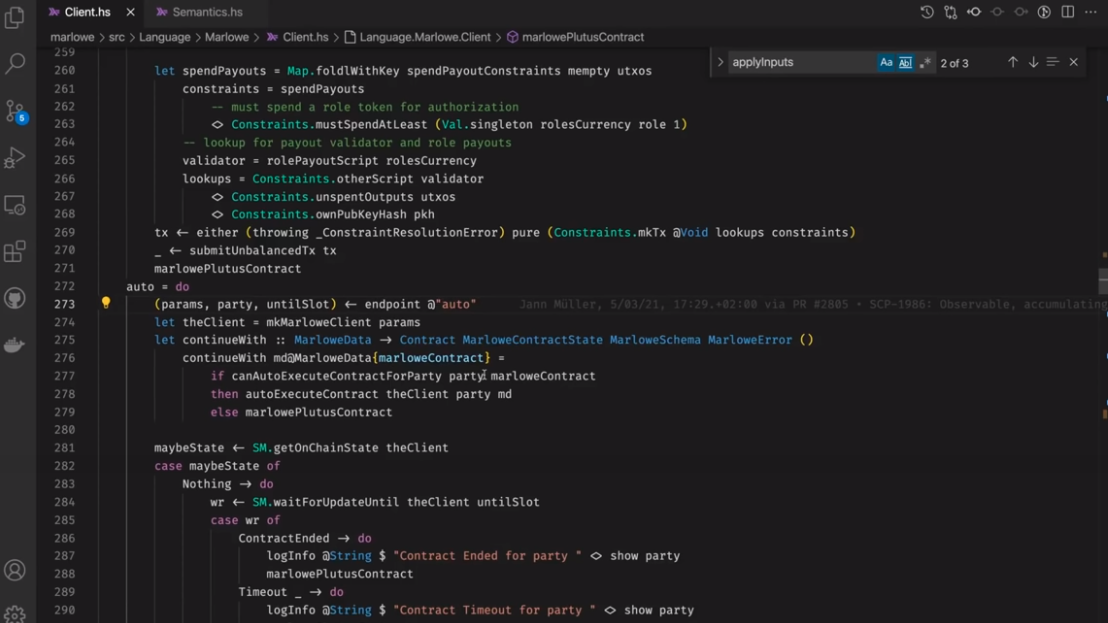
The auto endpoint is quite interesting and quite complicated. There is a set of contracts that can be executed automatically.
Imagine a contract that contains only deposits and payouts. No participant needs to provide choices or any interactive stuff. There are only scheduled payments. Such a contract can be executed automatically, and the auto endpoint allows exactly that.
So, if a contract can be executed automatically, it calls autoExecuteContract.
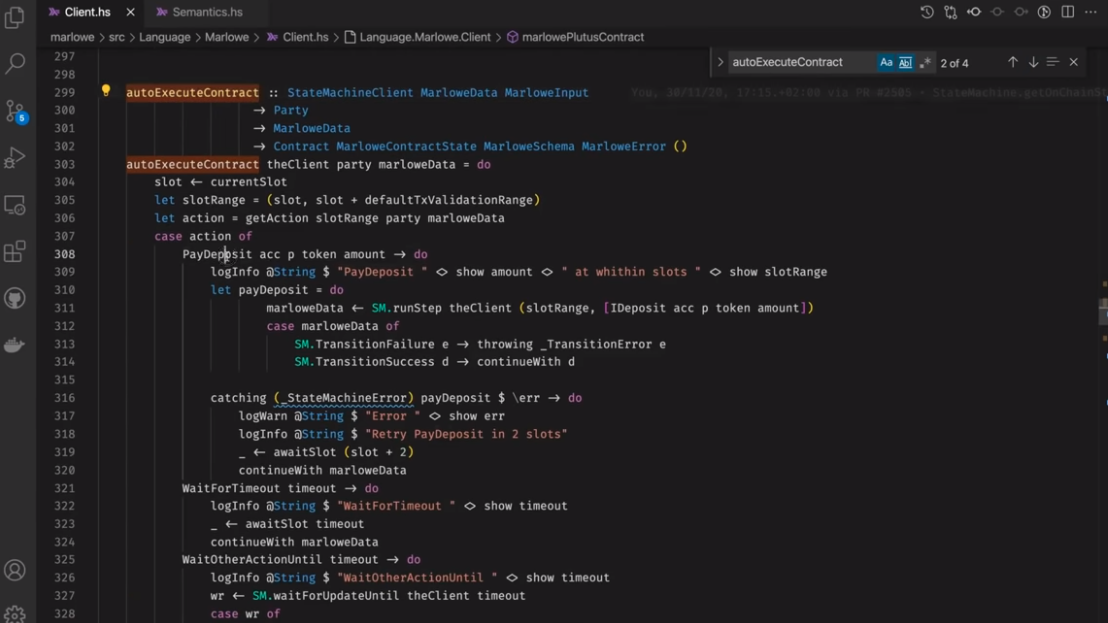
This is a state machine that pays a deposit or waits for other parties to do their part.
Companion Contract
The last interesting contract is the Marlowe Companion Contract.
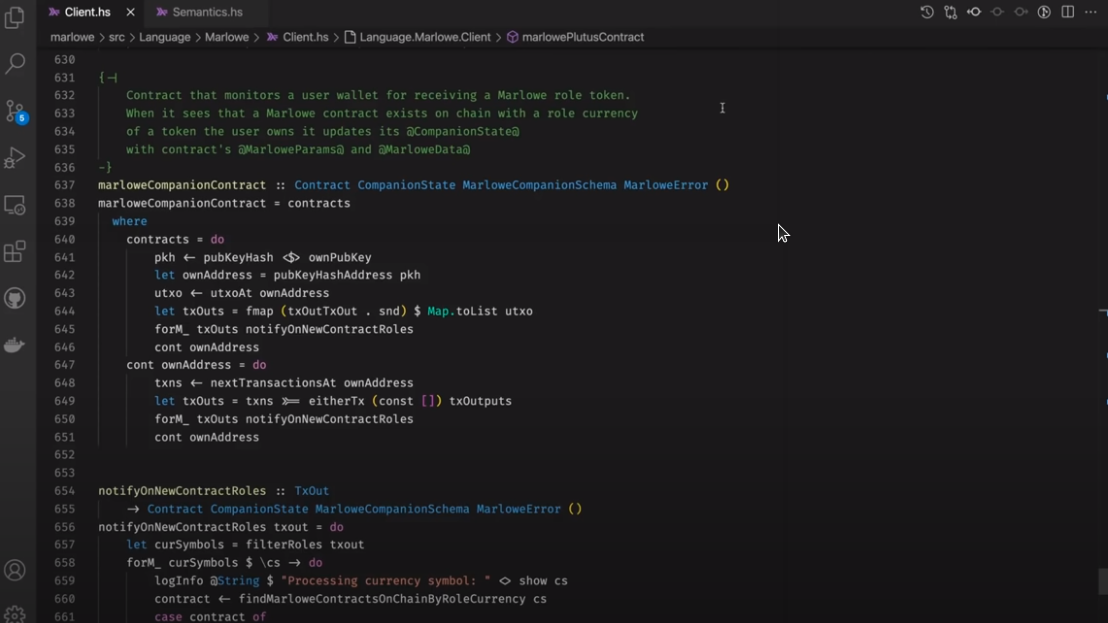
This is a contract that monitors a participant wallet and notifies when a role token arrives.
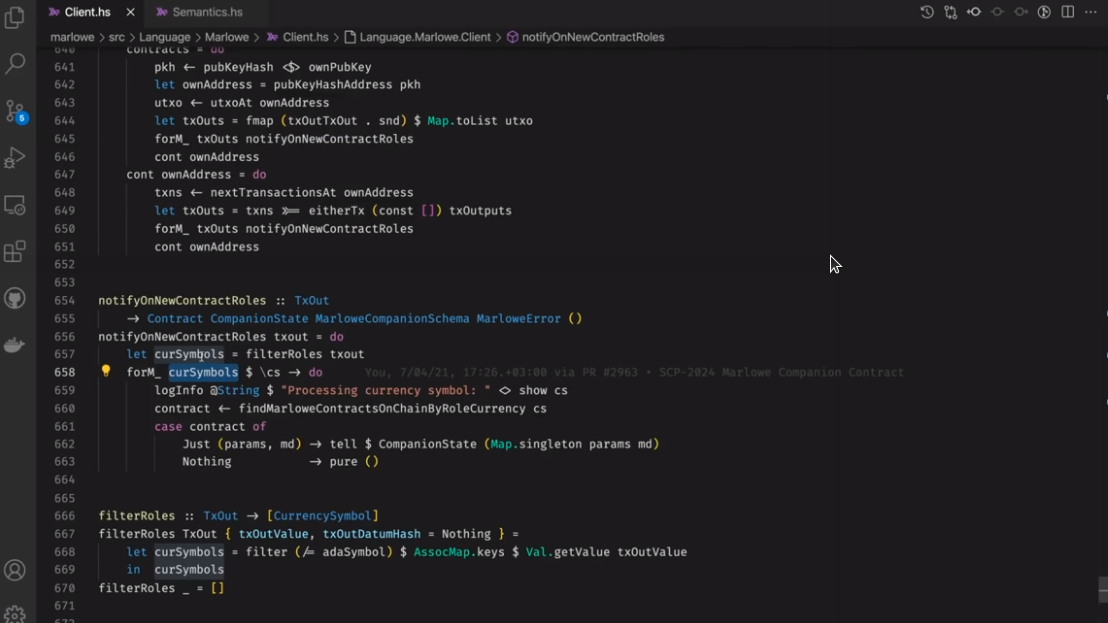
It listens to transactions that go to your own address and if there is a token and this token is generated by Marlowe contract creation, it tries to find the Marlowe contract and, if it succeeds, it updates the state of the contract. If you are subscribed to the contract\'s web socket, you will get a notification about a role token, and you\'ll get a map of MarloweParams to MarloweData.
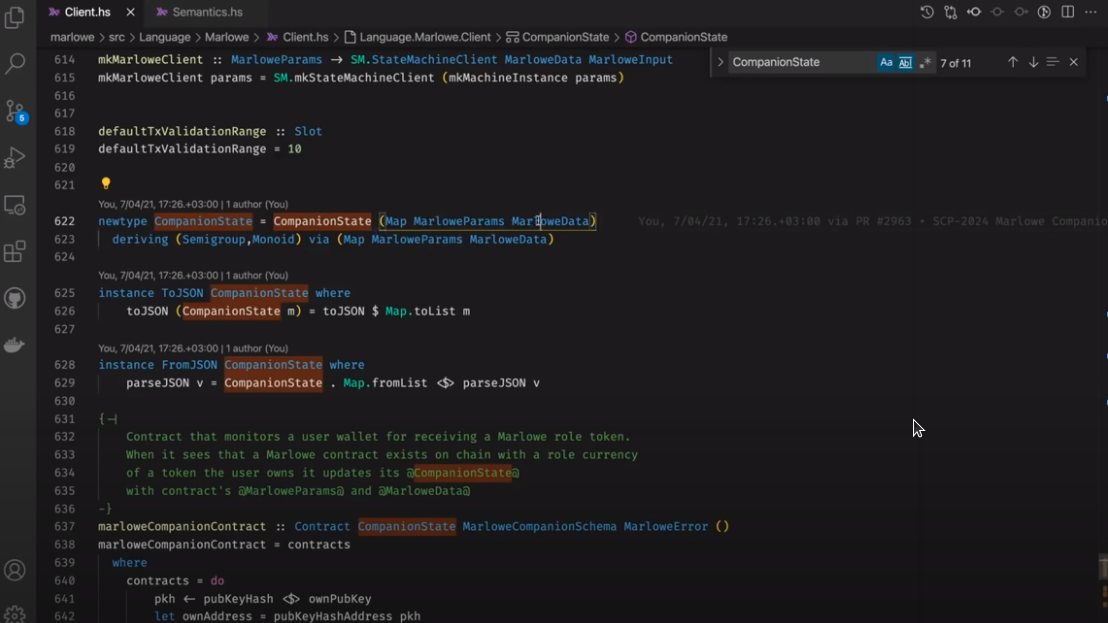
Playing in the Playground
Let\'s play around a little with Marlowe in the playground.
When you go to the playground, you first get presented with three options for you to choose in which language you want to write your Marlowe contracts.
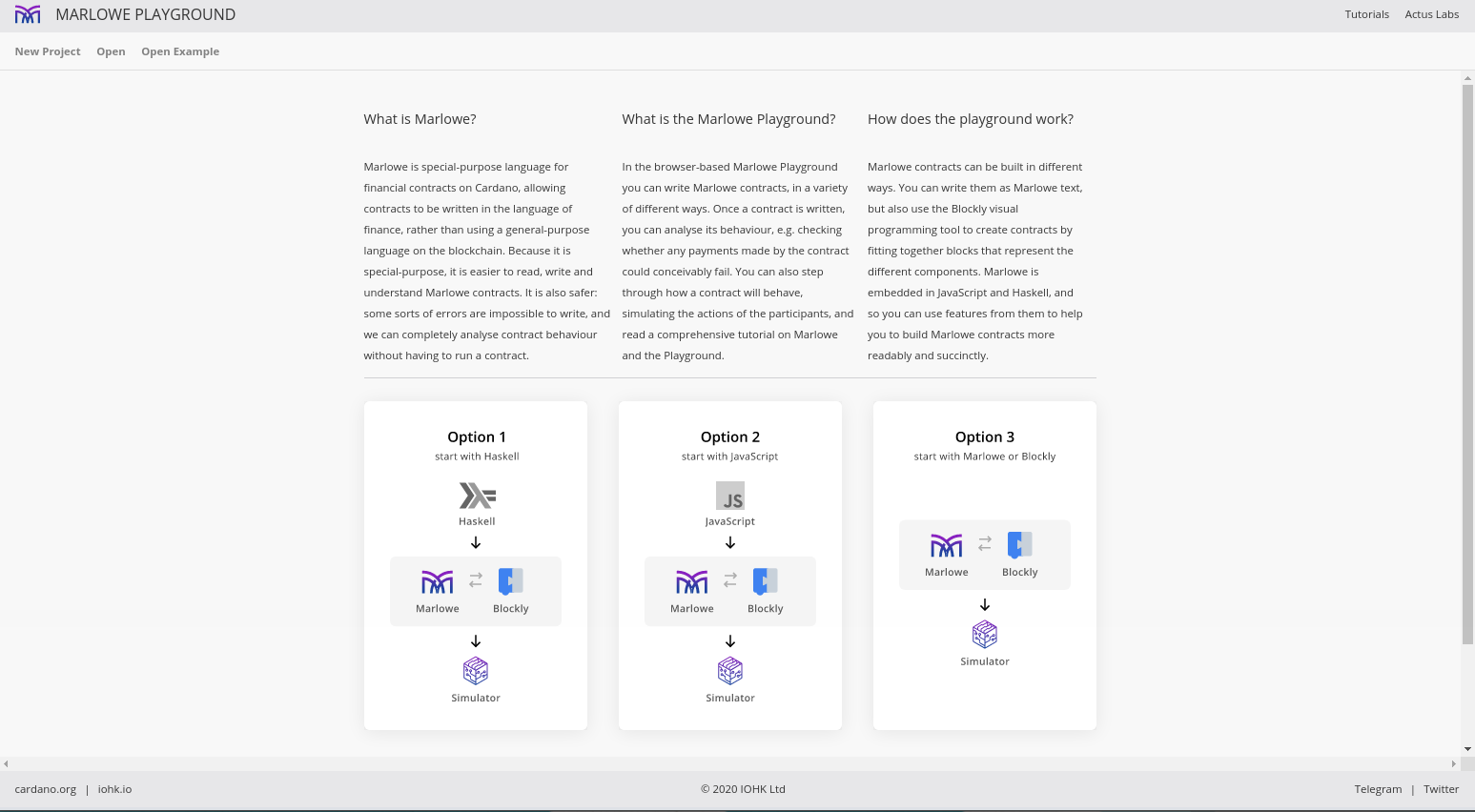
You can do it in Haskell, you can do it in Javascript, or you can do it in Blockly or directly in Marlowe.
Blockly is very nice and you don\'t need any programming experience to do this.
Blockly
Let\'s start a new project and select Blockly.
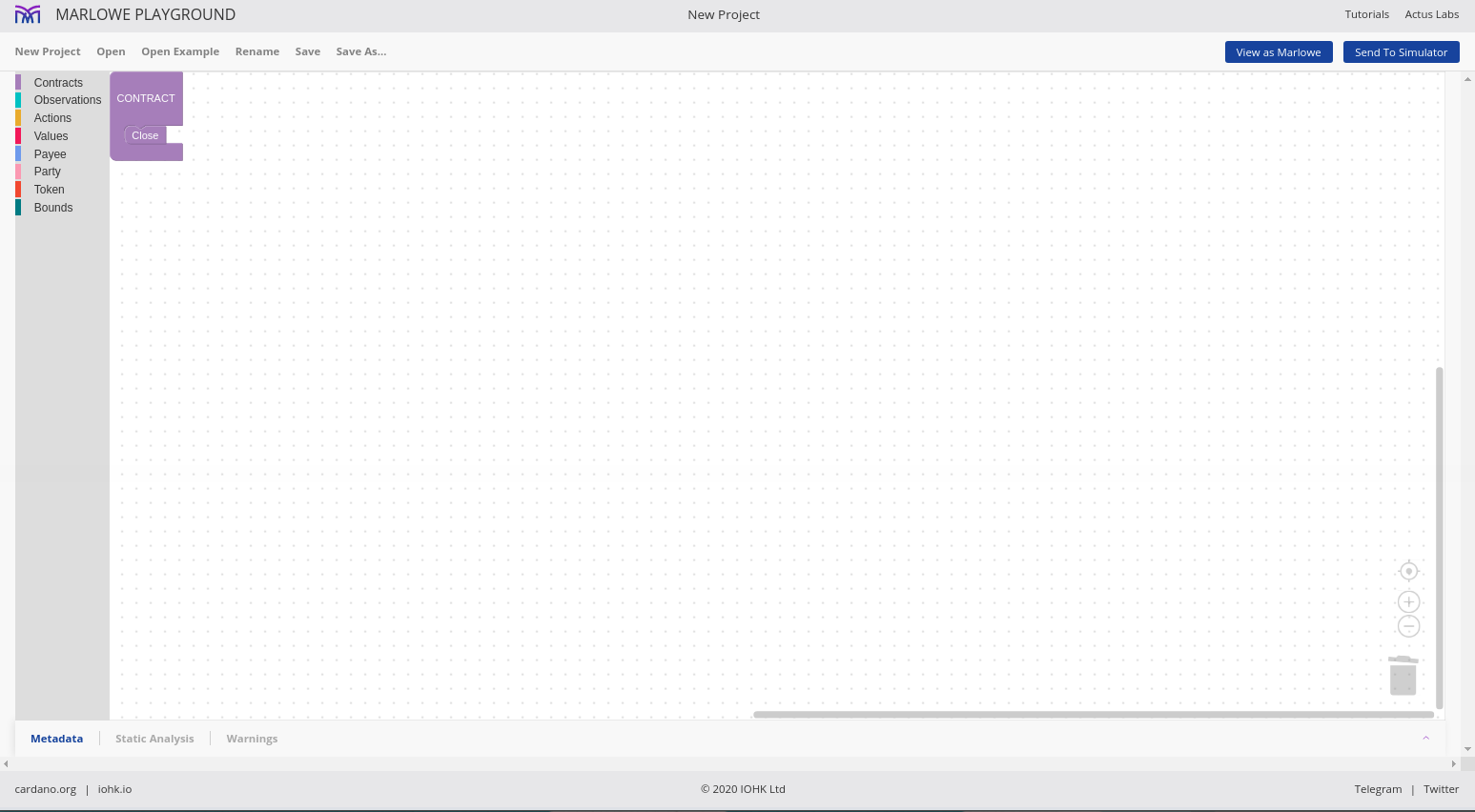
This is a graphical editor. We can just click and drop a Marlowe contract together.
As an example let\'s write a contract where there are three parties - Alice, Bob and Charlie.
The idea is that Alice and Bob deposit an amount of Ada into the contract, let\'s say 10 Ada, and then Charlie decides whether Alice or Bob gets the total amount. Depending on Charlie\'s decision either Alice gets 20 or Bob gets 20.
There\'s always the possibility that one of the three doesn\'t play along; Alice doesn\'t make her deposit, Bob doesn\'t make his deposit, or Charlie doesn\'t make his choice. In this case everybody should just get reimbursed.
When we start with Blockly, there is a contract and it\'s just a Close contract, which in this case doesn\'t do anything. If there was money in internal accounts it would pay back the money to the owners of the accounts.
We want to do something else, so let\'s first wait for a deposit by Alice.
Because that\'s an external action that\'s triggered by one of the parties, in this case Alice, we need the When construct that Simon mentioned.
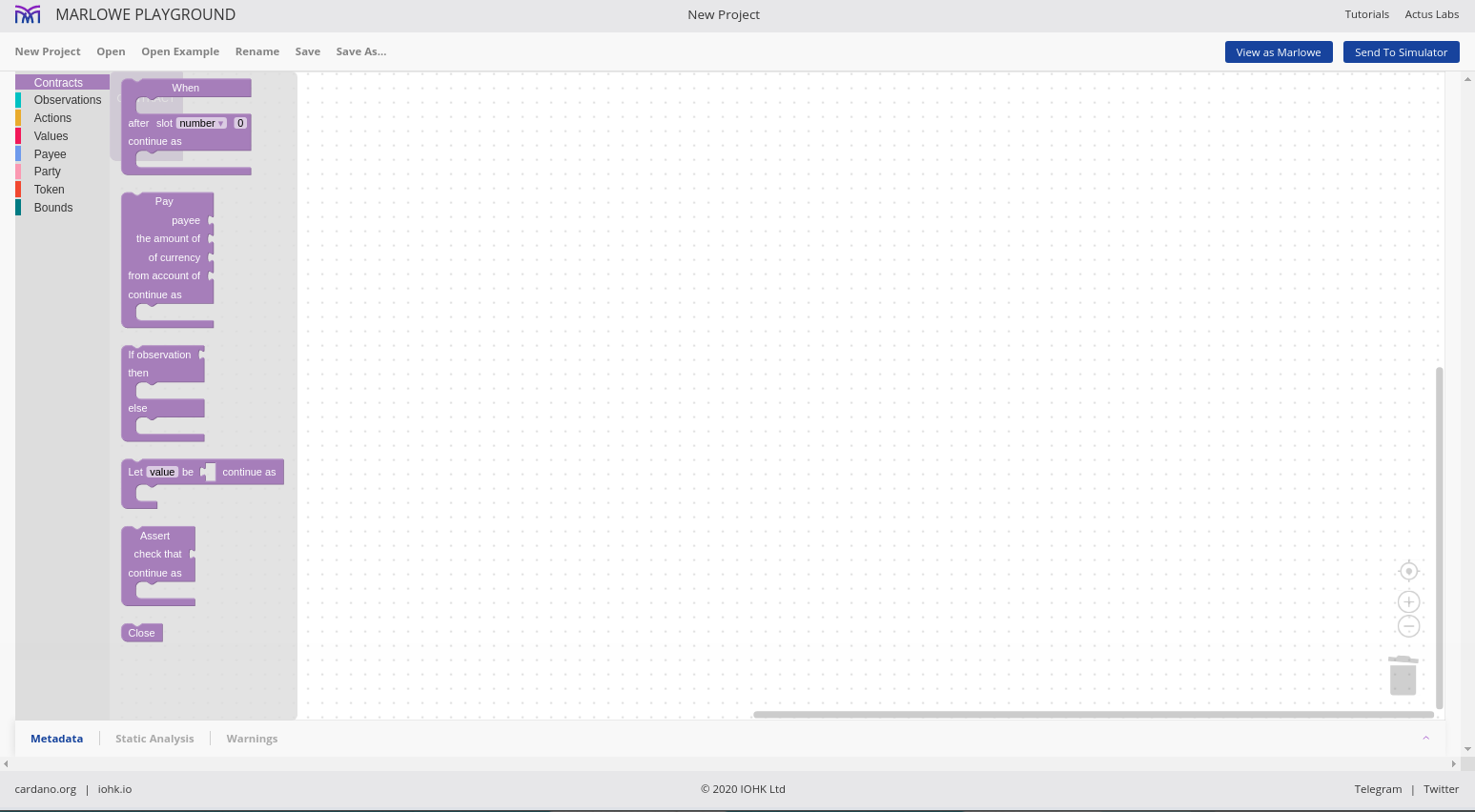
We can remove the Close contract, slide the When one into its place.
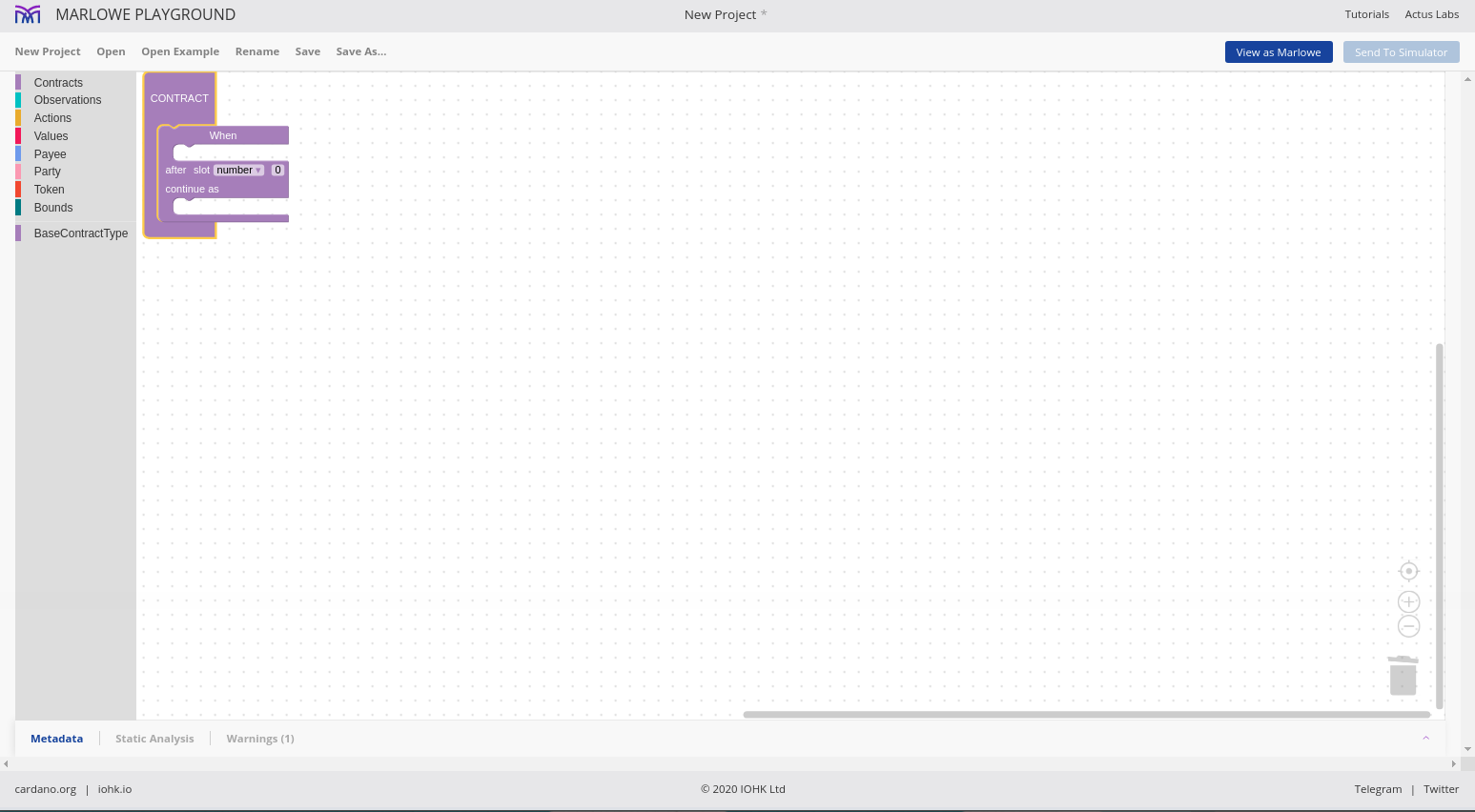
Here we see all the slots where other things need to go. We see some fields that we have to set.
We can set a timeout so let\'s say this deposit by Alice has to happen by slot 10.
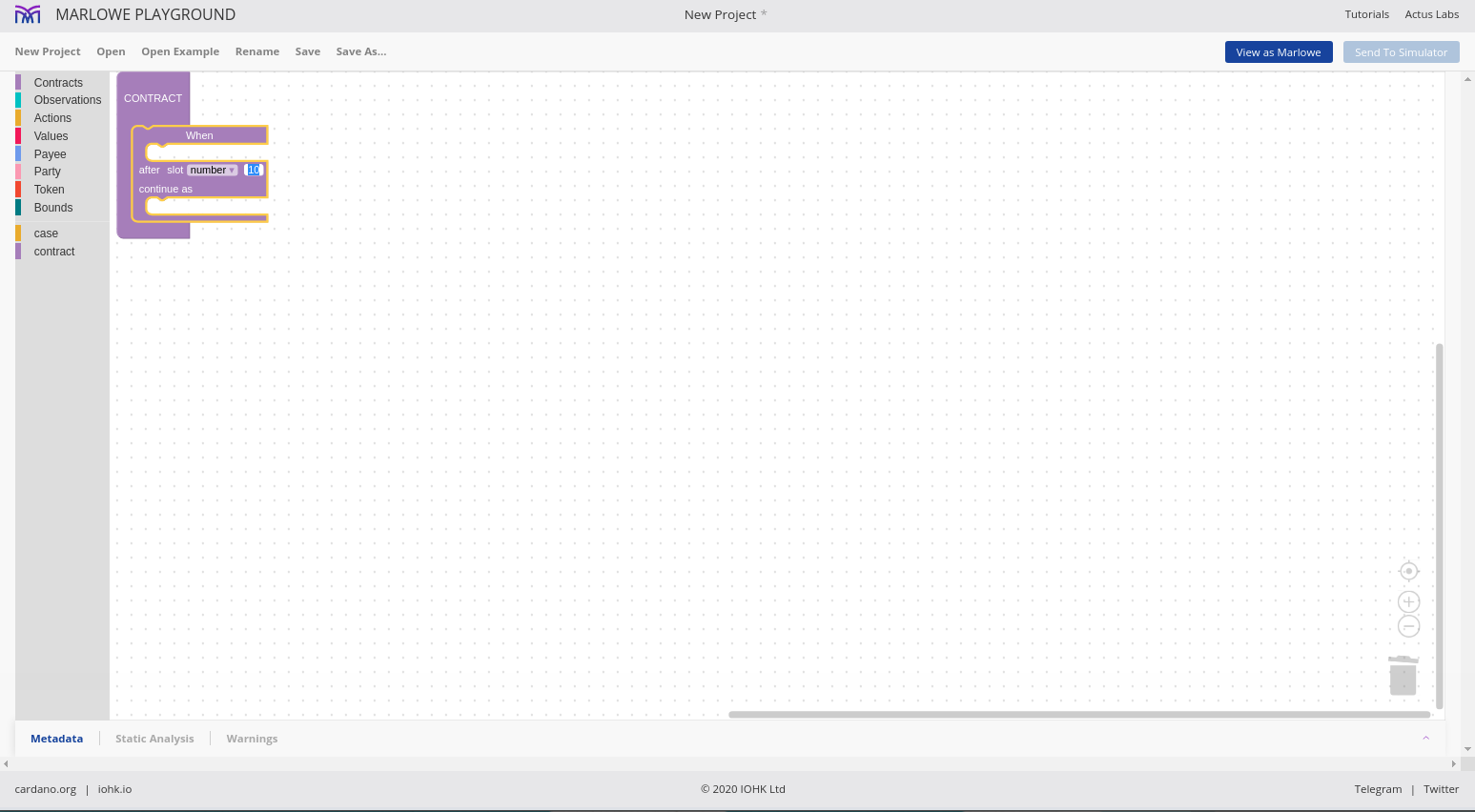
If it doesn\'t happen, we can say what should happen afterwards, and there is not really a good choice to do anything except close in that case, so in that case nothing will happen.
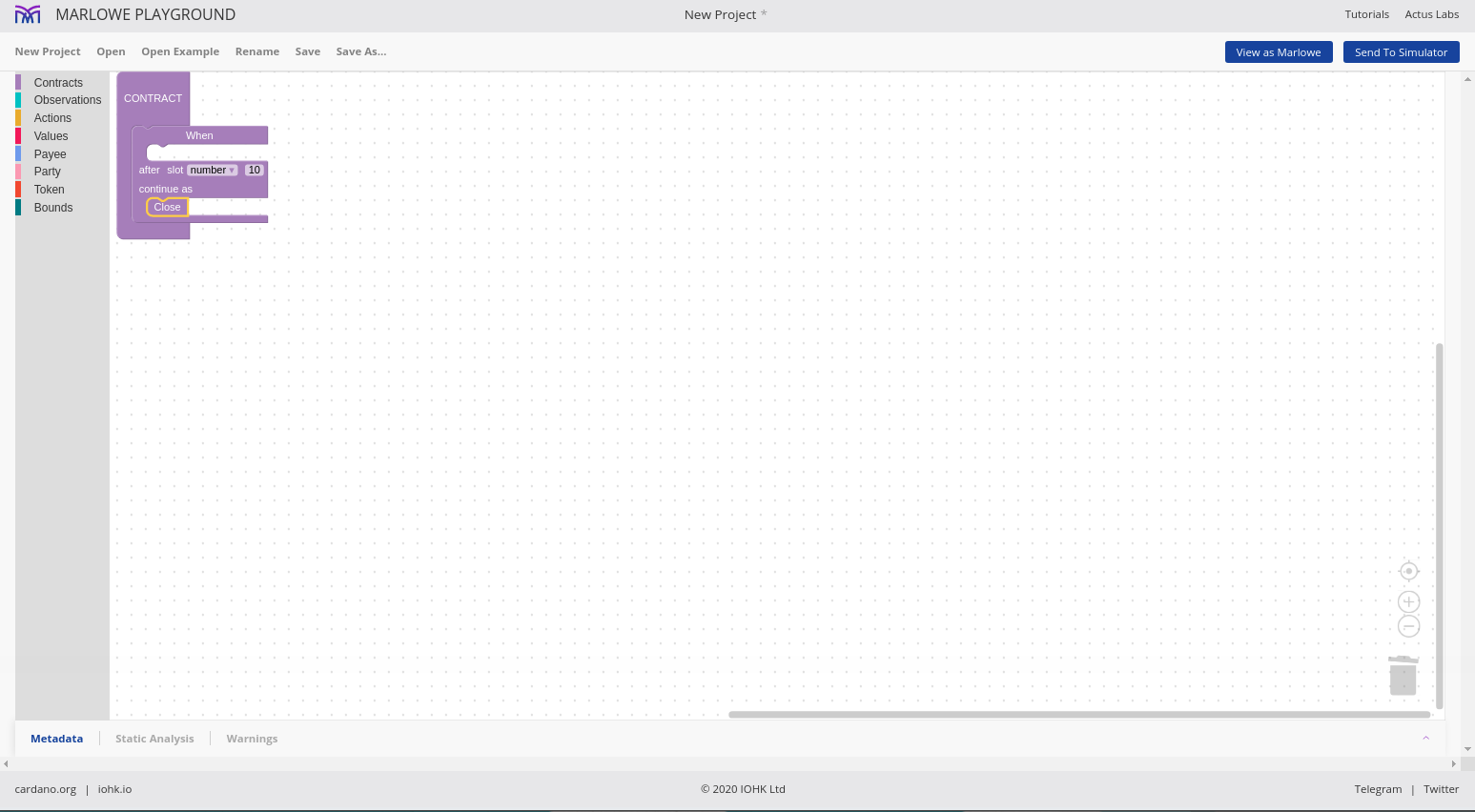
Here we say what external actions we wait for. Let\'s say we only wait for one action, namely that Alice makes a deposit.
So we can check for actions and pick the deposit one and slide it in.
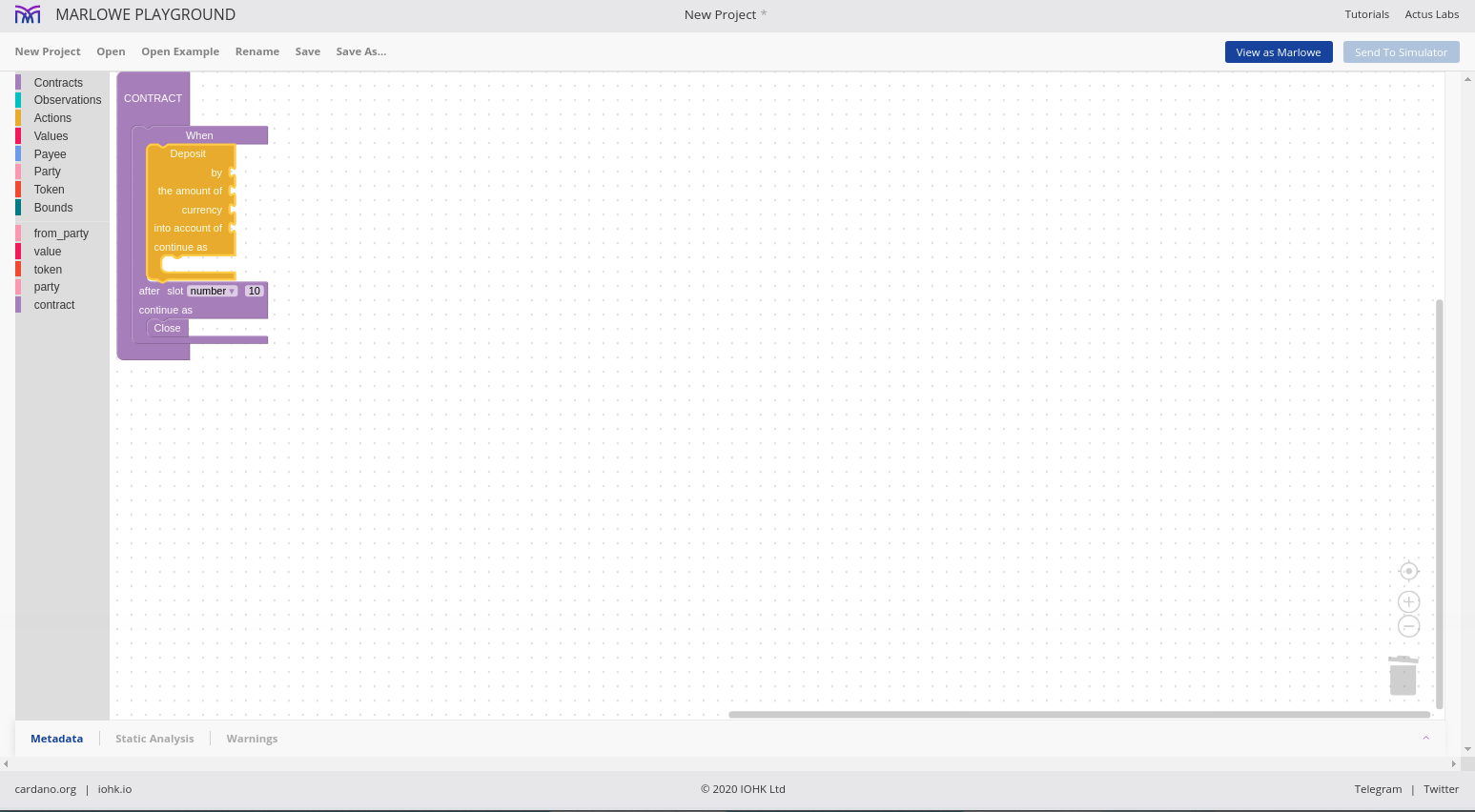
We see some slots that we have to fill. First of all, a party who has to make the deposit, and there are two choices - a public key or role.
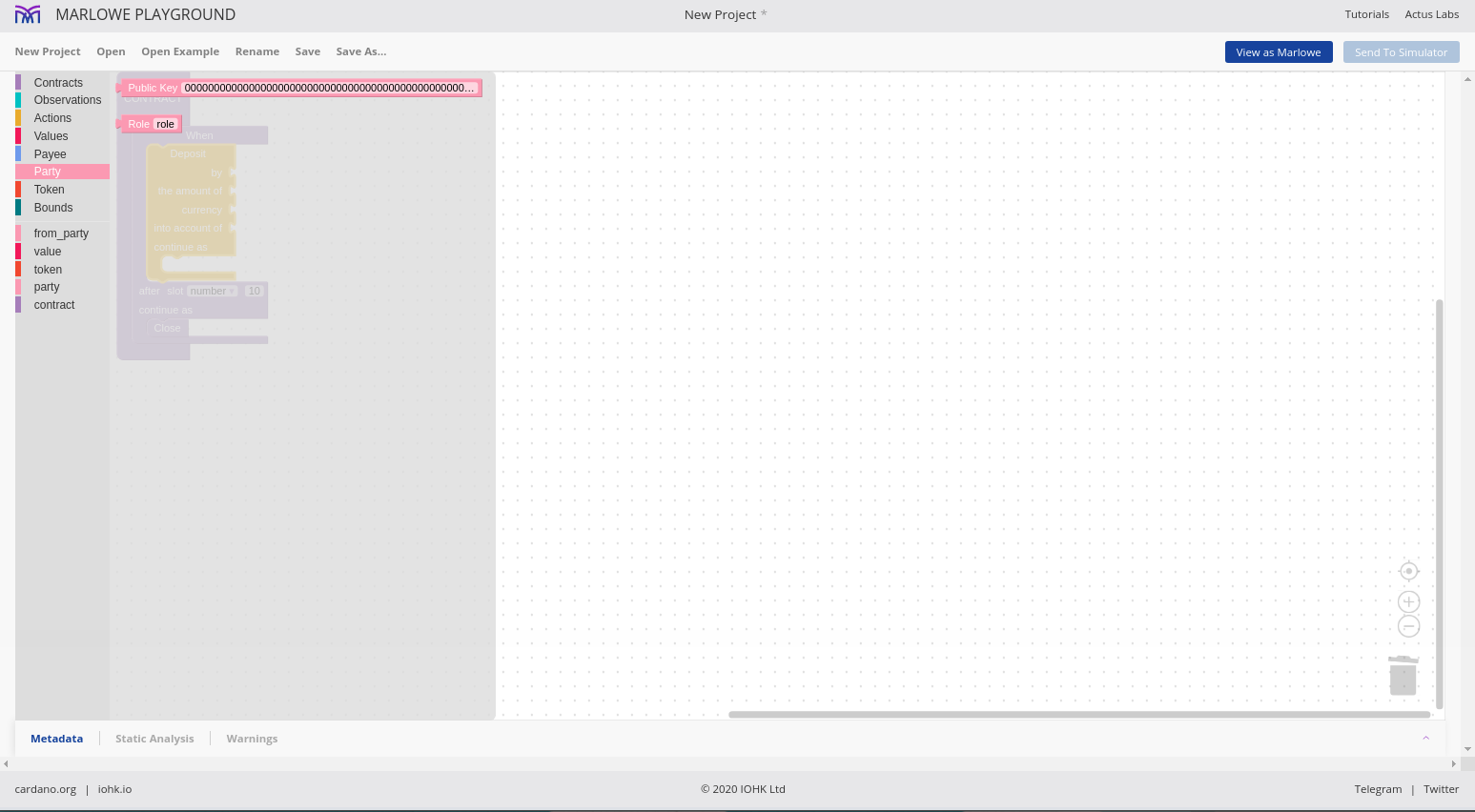
Let\'s take role because then we can just say Alice. Normally this would be the name of the role token, so whoever owns that token can incorporate that role.
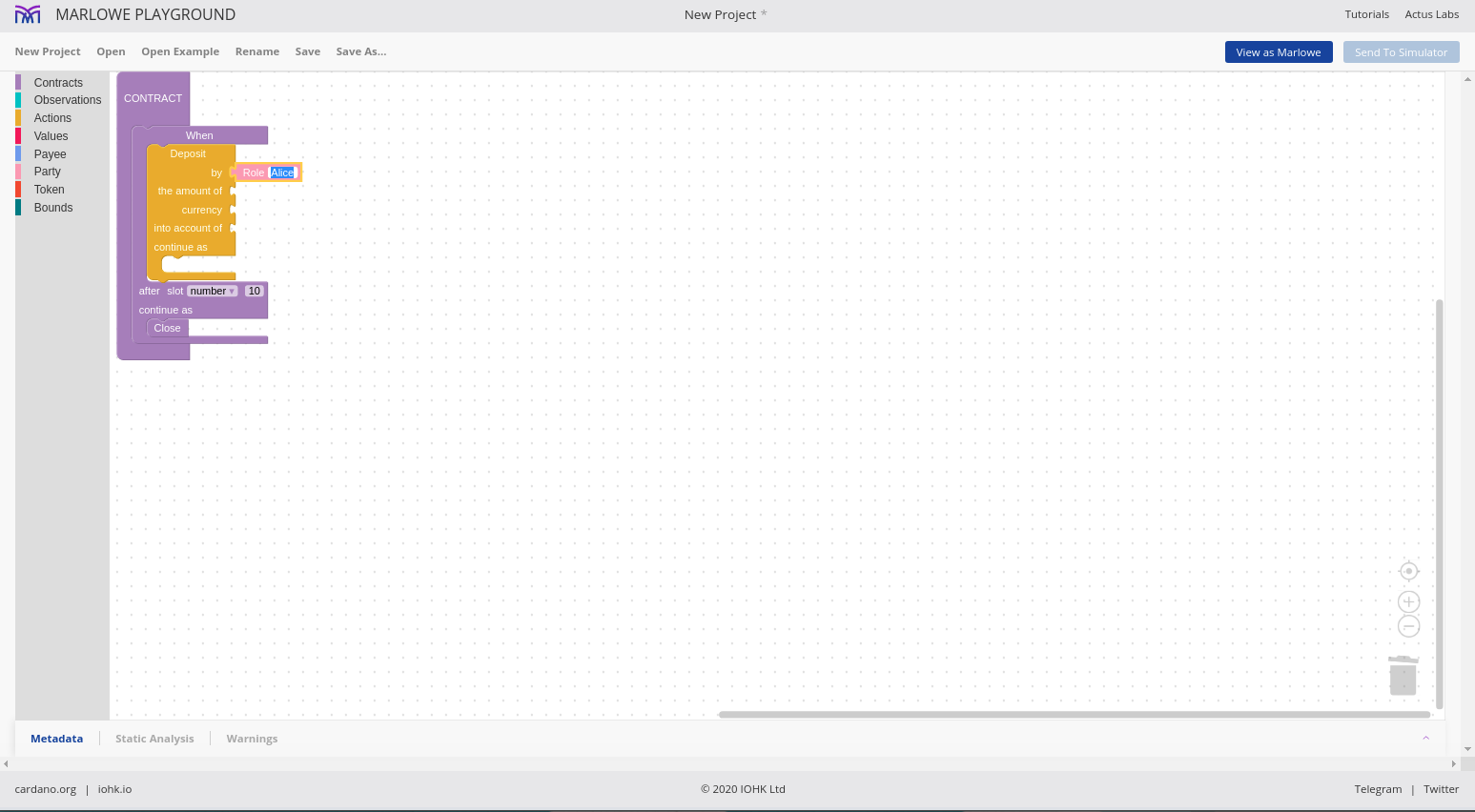
So Alice makes a deposit. Now the amount. That\'s a Value and let\'s say we just pick a constant amount of 10 Ada.
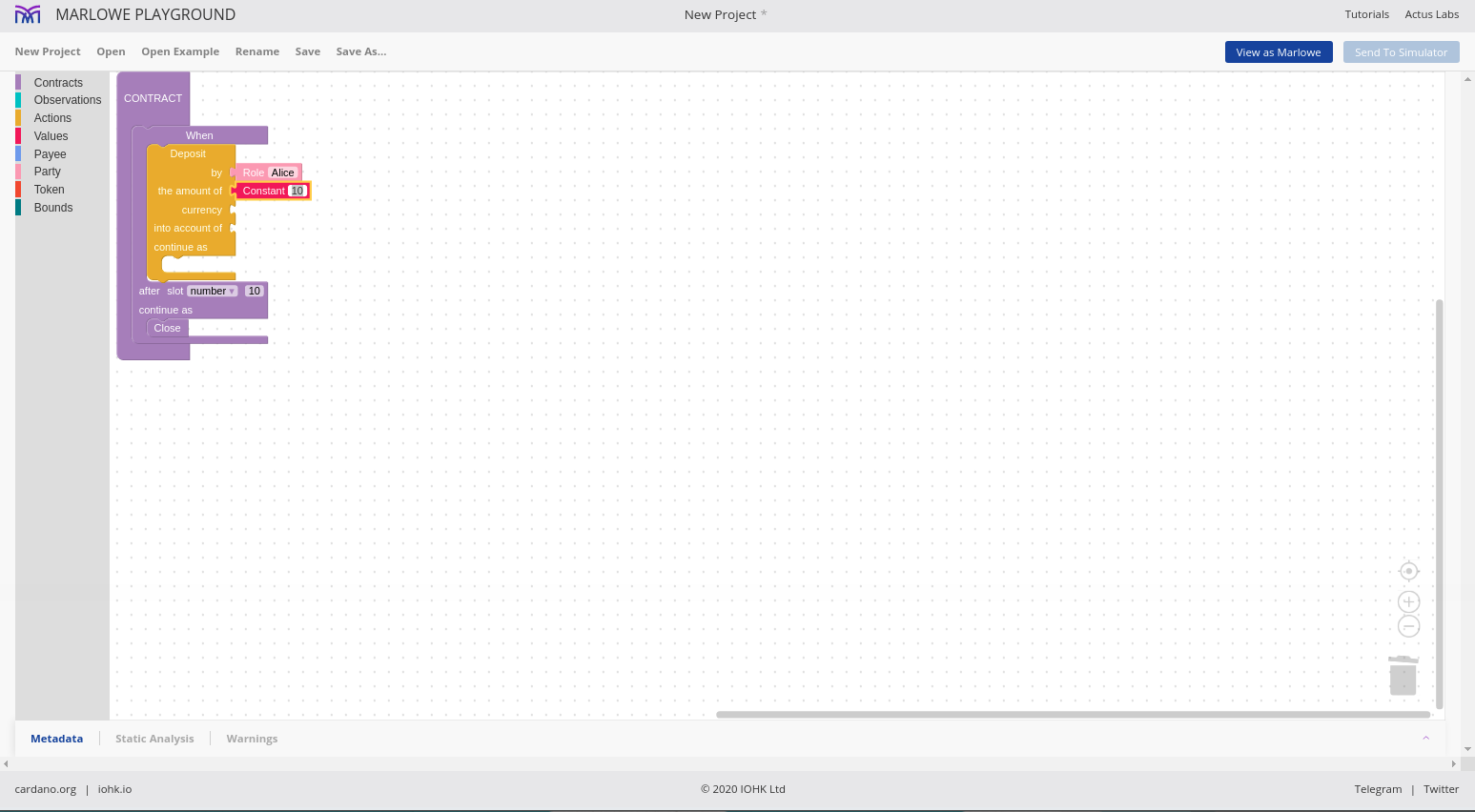
The amount is 10, and the fact that it is Ada must be specified in the currency slot.
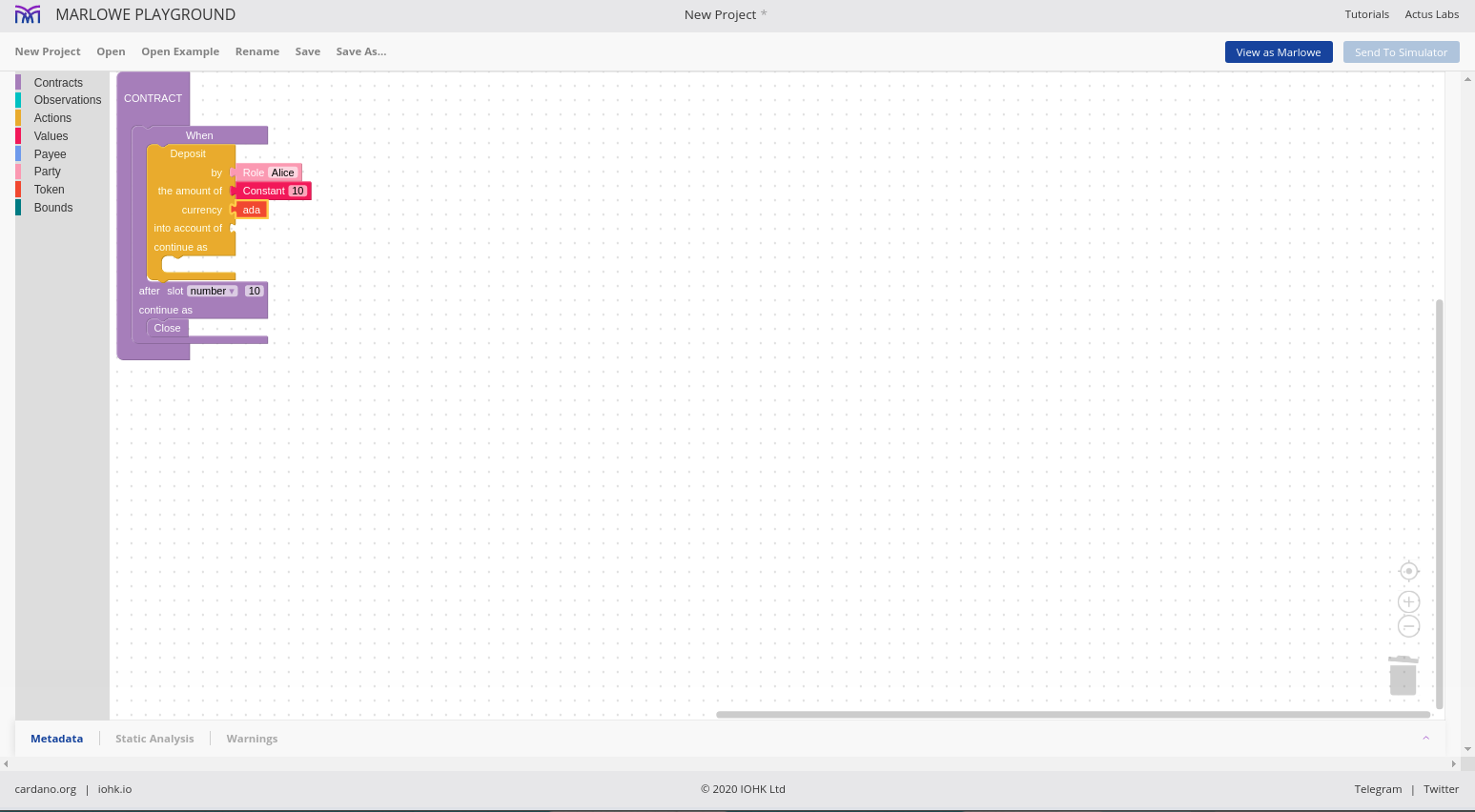
There\'s also the option to use tokens than Ada, but let\'s stick with Ada.
Now there are these internal accounts that also belong to one of the parties, so let\'s say Alice pays it into her own internal account.
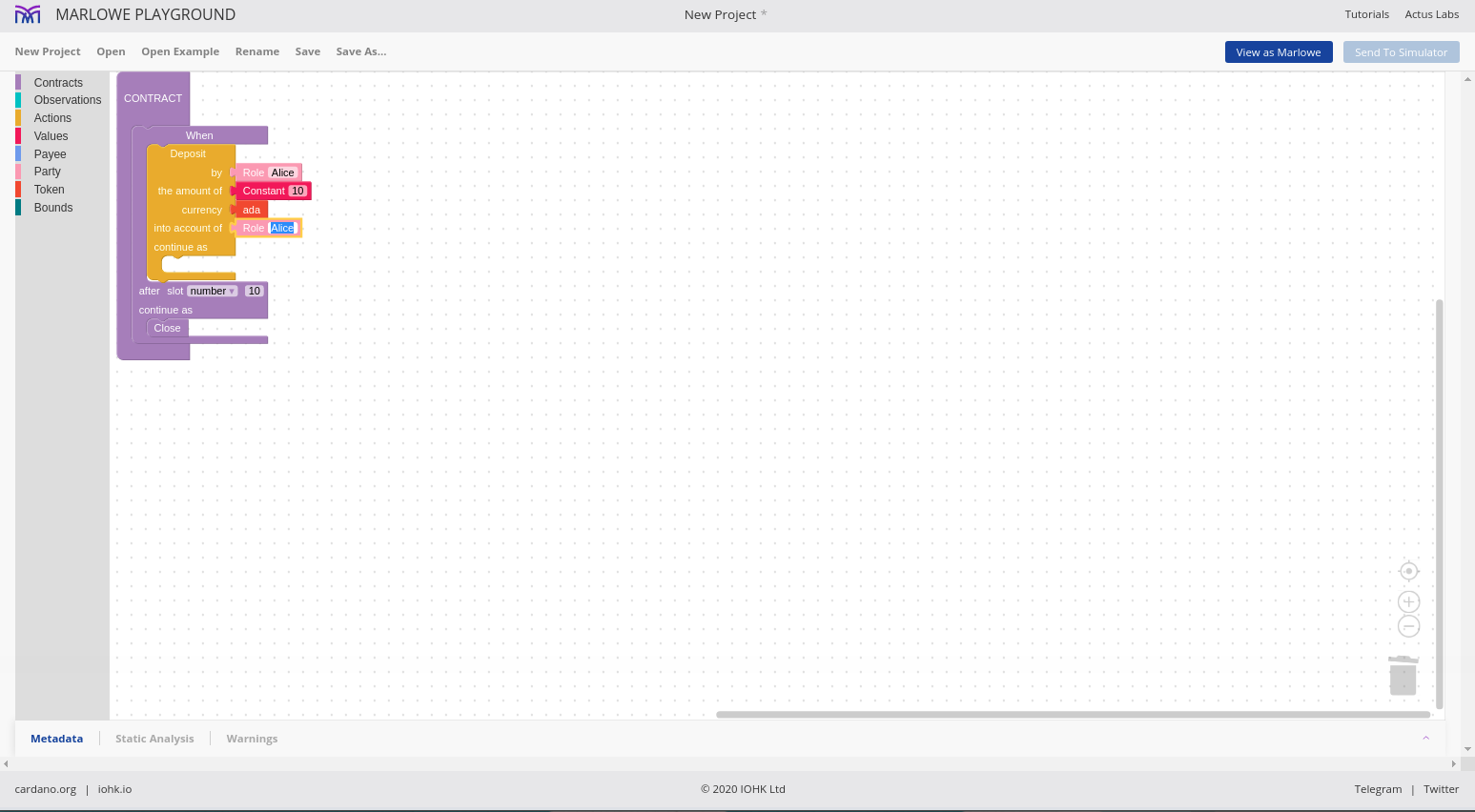
That can be copy/pasted rather than getting it from the Party menu again.
Now we must say what happens next, if Alice makes this deposit. Afterwards we want Bob to make a deposit, so we can start by just copying the whole When block.
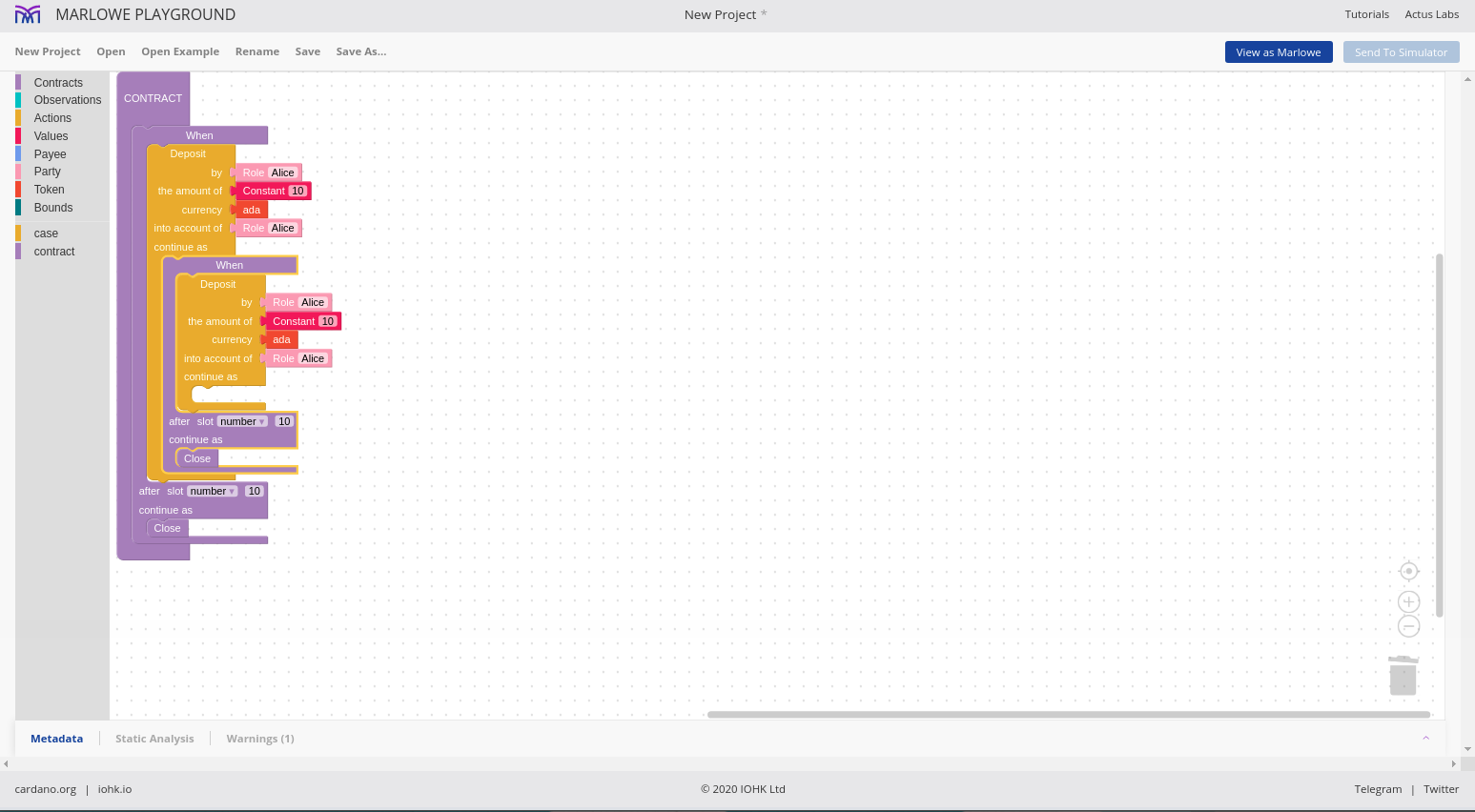
First of all we change the timeout to 20 so as to give Bob also 10 slots to do something, and then wherever we have Alice, we now put Bob.
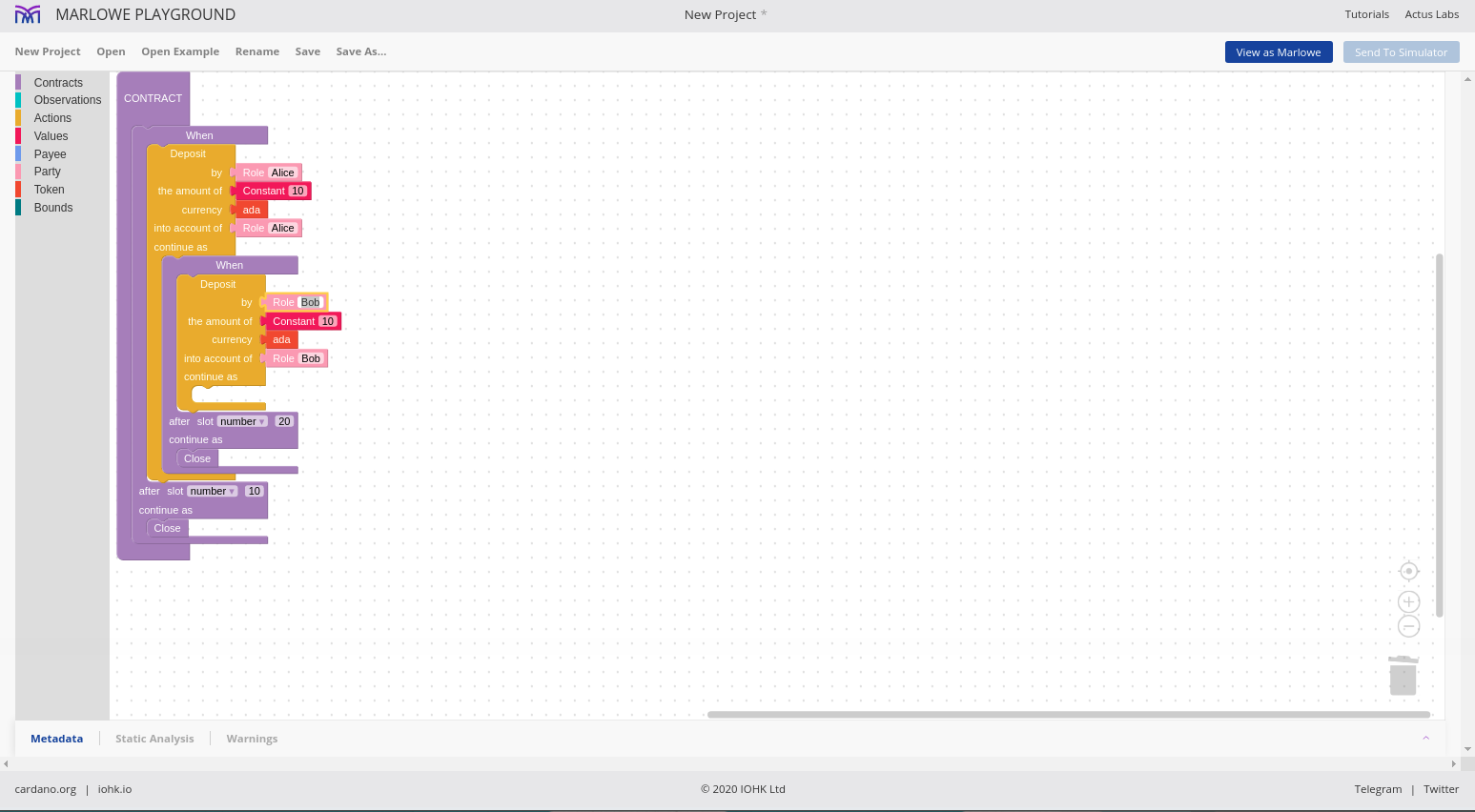
So at this point, if both these actions happen, Alice has deposited 10 into her internal account and Bob has deposited 10 into his external account.
Now we want Charlie to make a choice, and this is again an external action, so again we need a When, but this time it\'s not a deposit so let\'s delete the deposit. Then let\'s change the timeout to 30 to give Charlie 10 slots to make his choice.
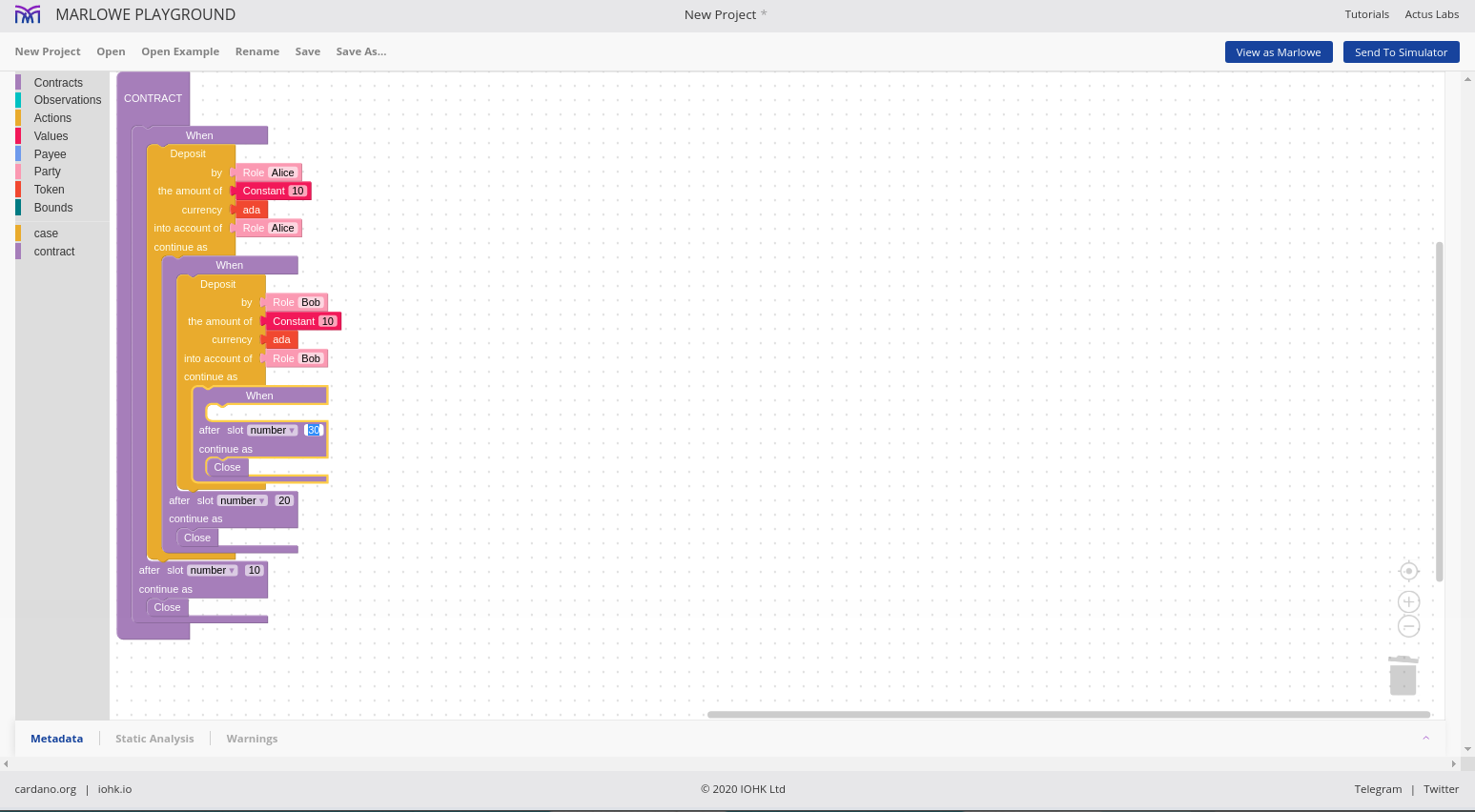
Now we need a different action. Where earlier we had Deposit, now we pick the Choice action. We can give it a name, let\'s say Winner. We must say who makes the choice, so that\'s will be Charlie, and now we must specify what values this choice can have.
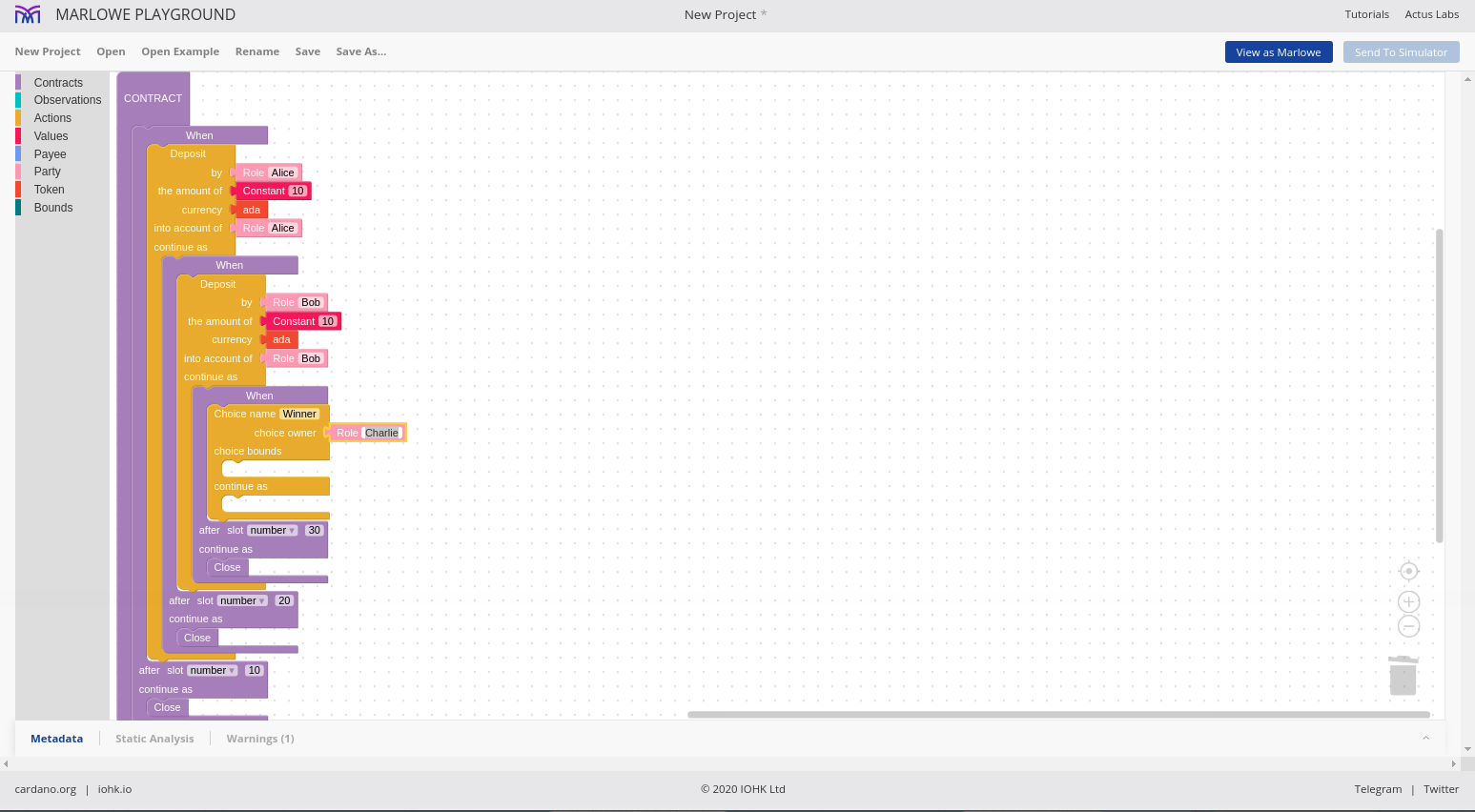
That\'s numeric so because Charlie is supposed to choose between Alice and Bobs, which is two choices, I can pick arbitrary values like one and two. One for Alice, two for Bob. That\'s already the default so that\'s fine.
This allows Charlie to choose one or two.
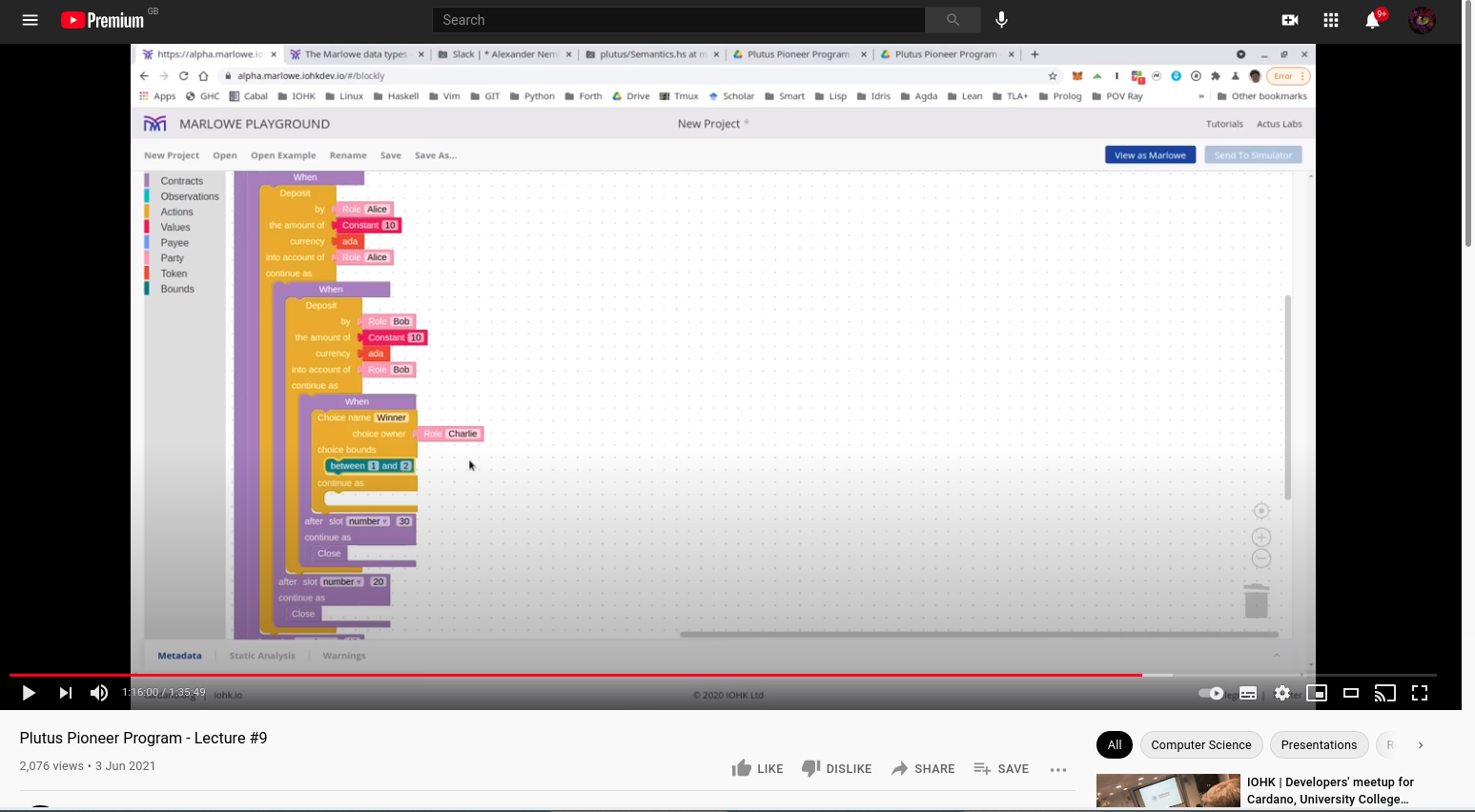
Then if and when Charlie makes a choice, we continue, and it now depends on the choice that he has made. If he chose Alice then Alice must get all the money, if he chose Bob then Bob must get all the money.
So we will add an If conditional.
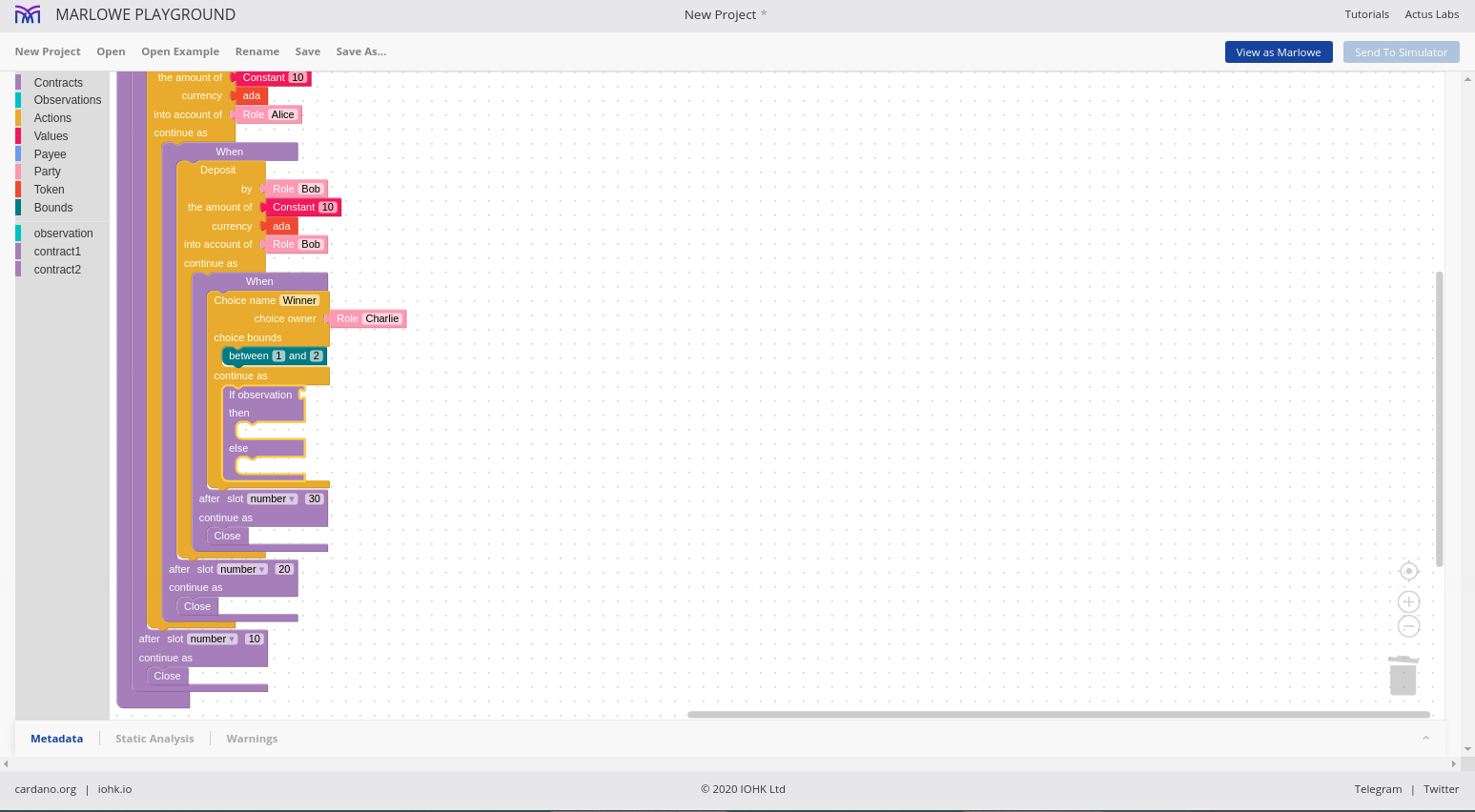
Then we will add an observation to check if Alice is the winner. The observation we add is the value is equal to observation.
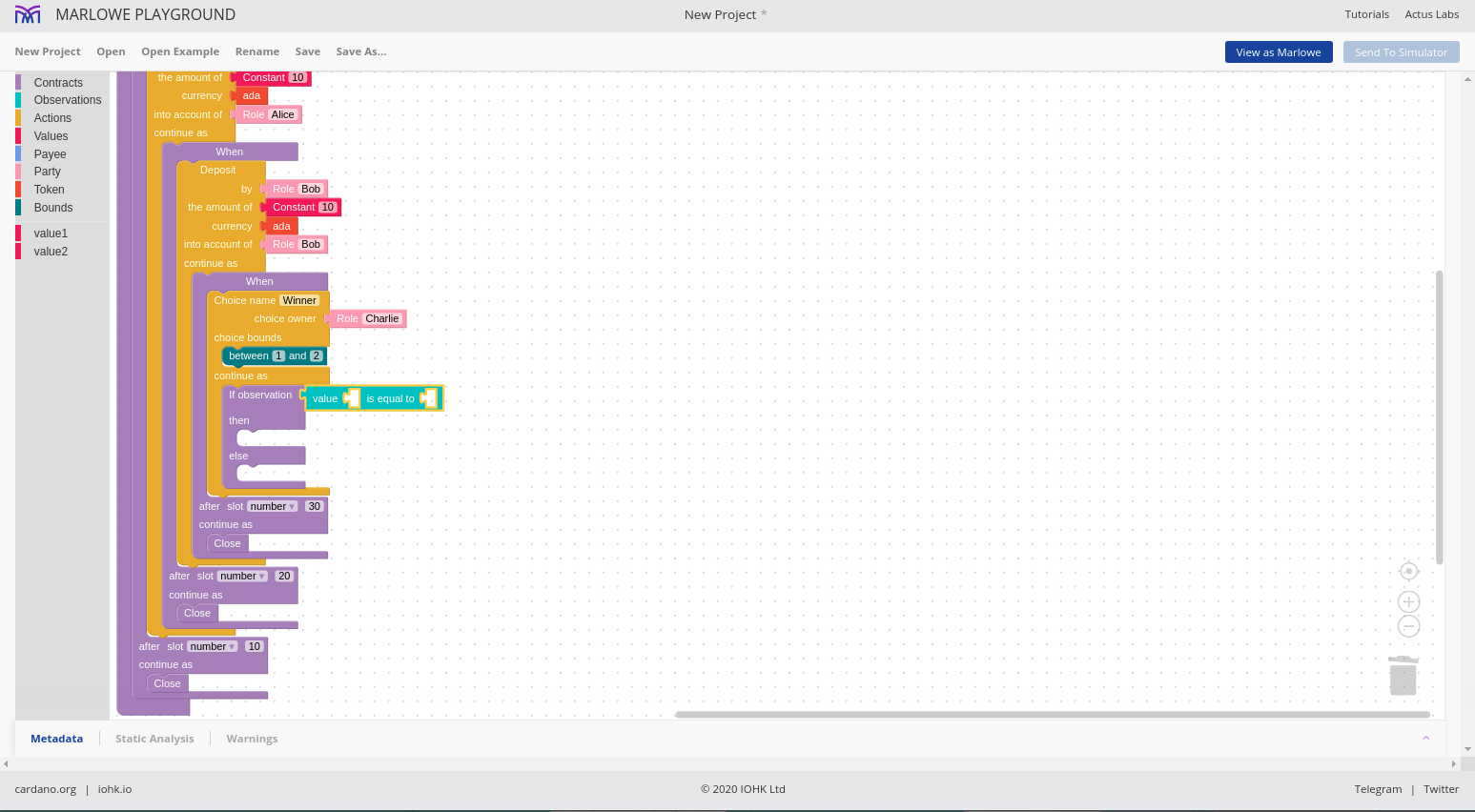
To see if it is Alice, we will use the Choice by option to ask if Charlie\'s Winner name is equal to Alice.
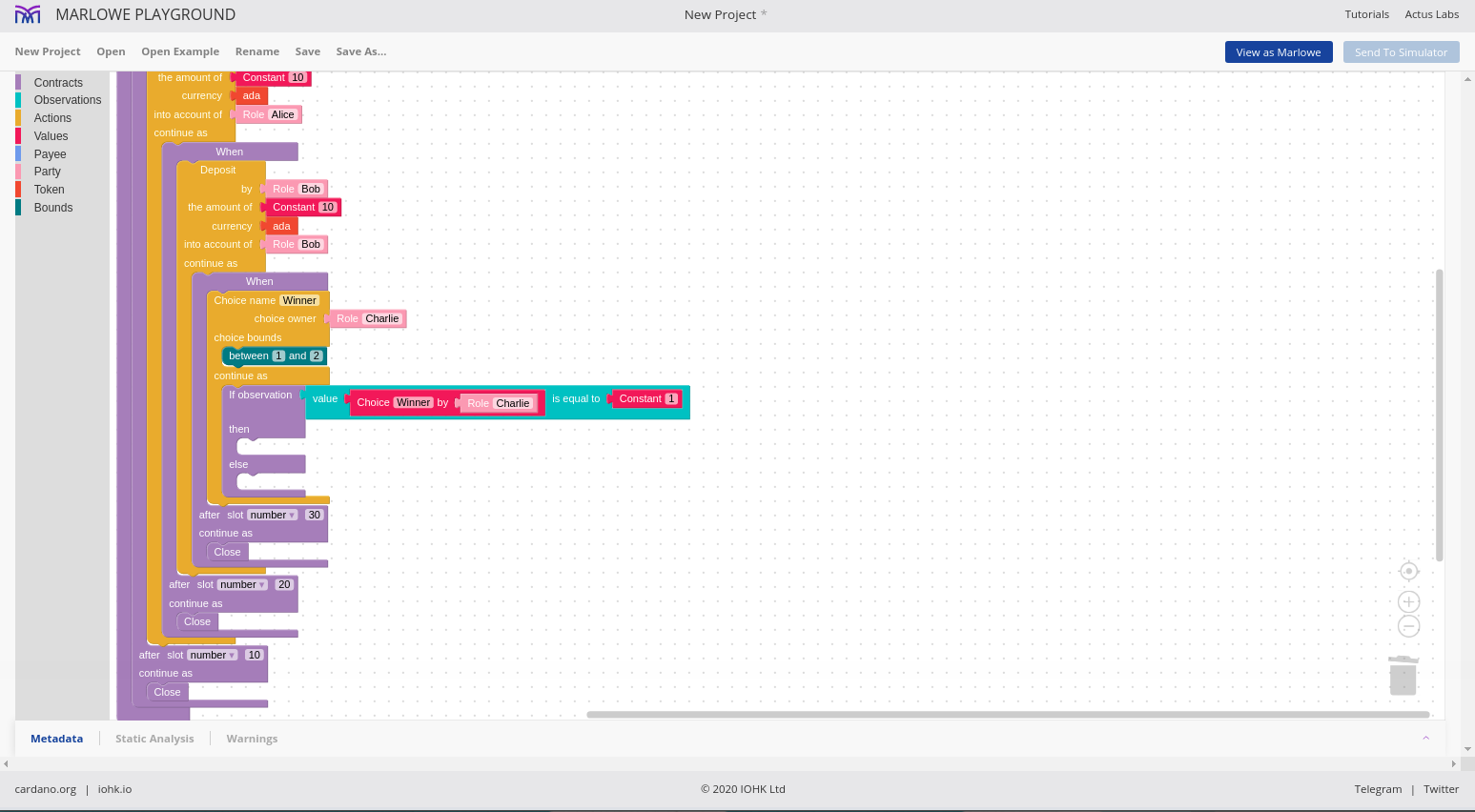
In the then branch we now take a pay contract. The payee is who gets the money - it can be an internal account or it can be an external party. In this case it doesn\'t matter, because when we close, all the parties get the money from the internal accounts as well.
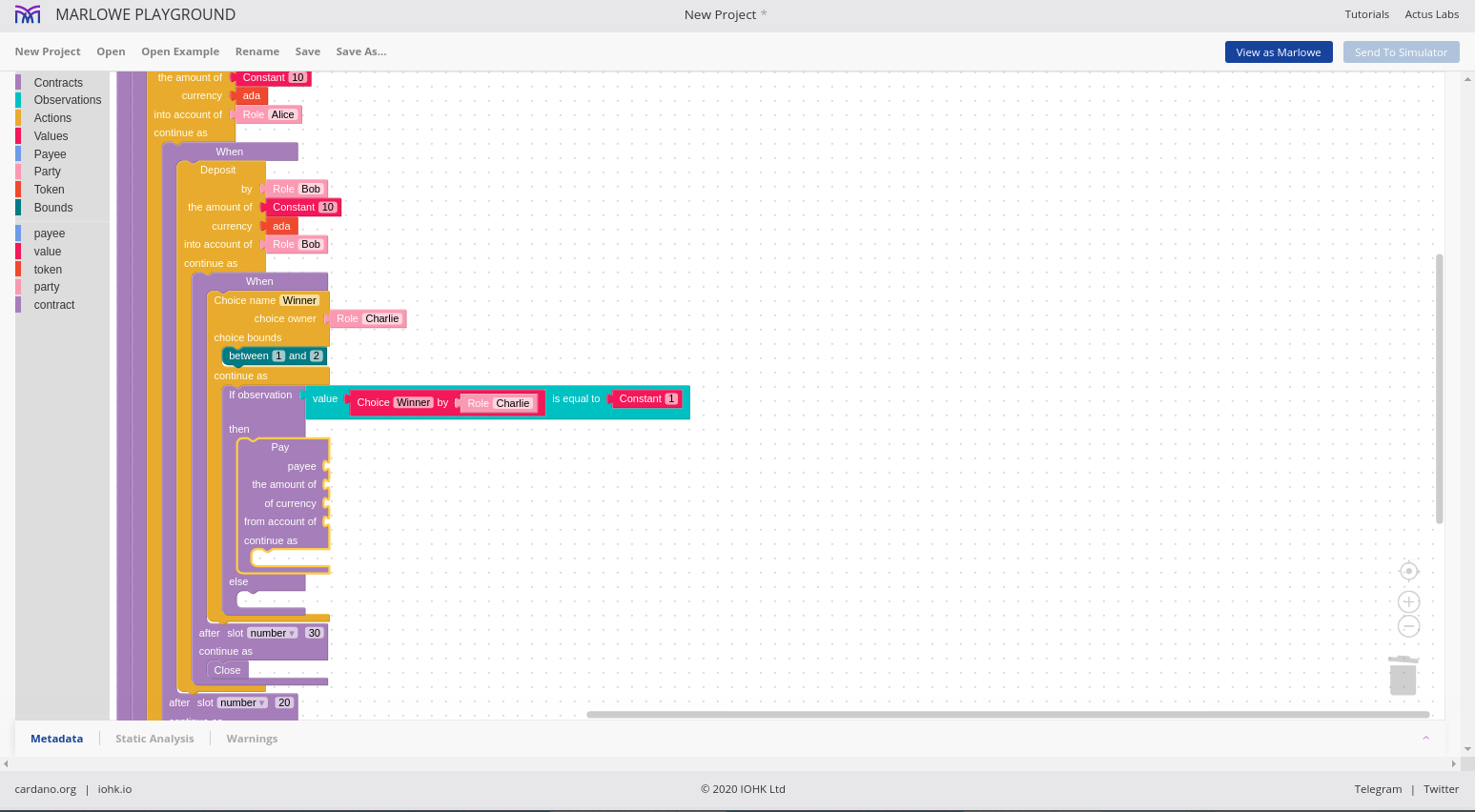
So, we\'ll just pick Alice\'s internal account.
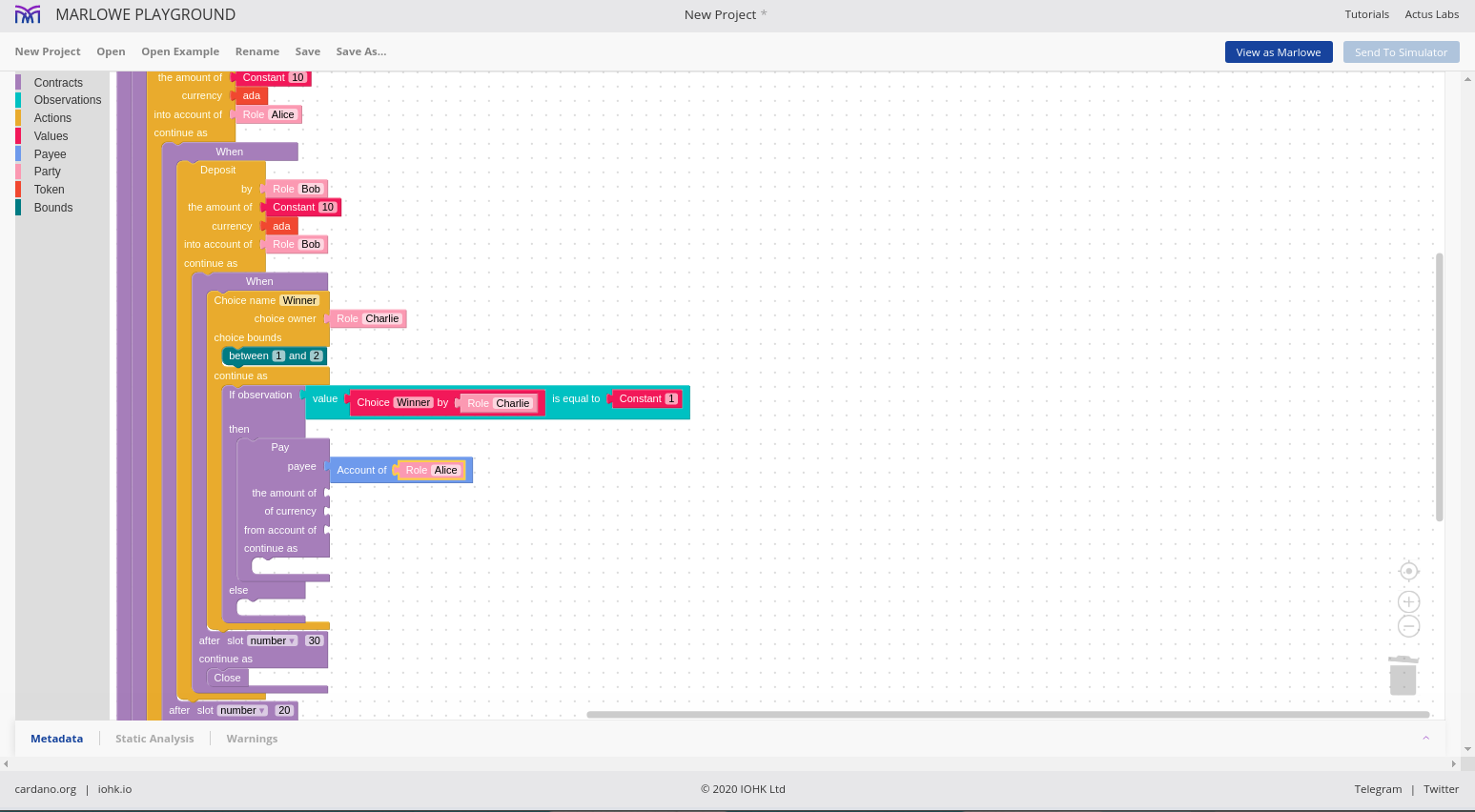
We will pay 10 Ada.
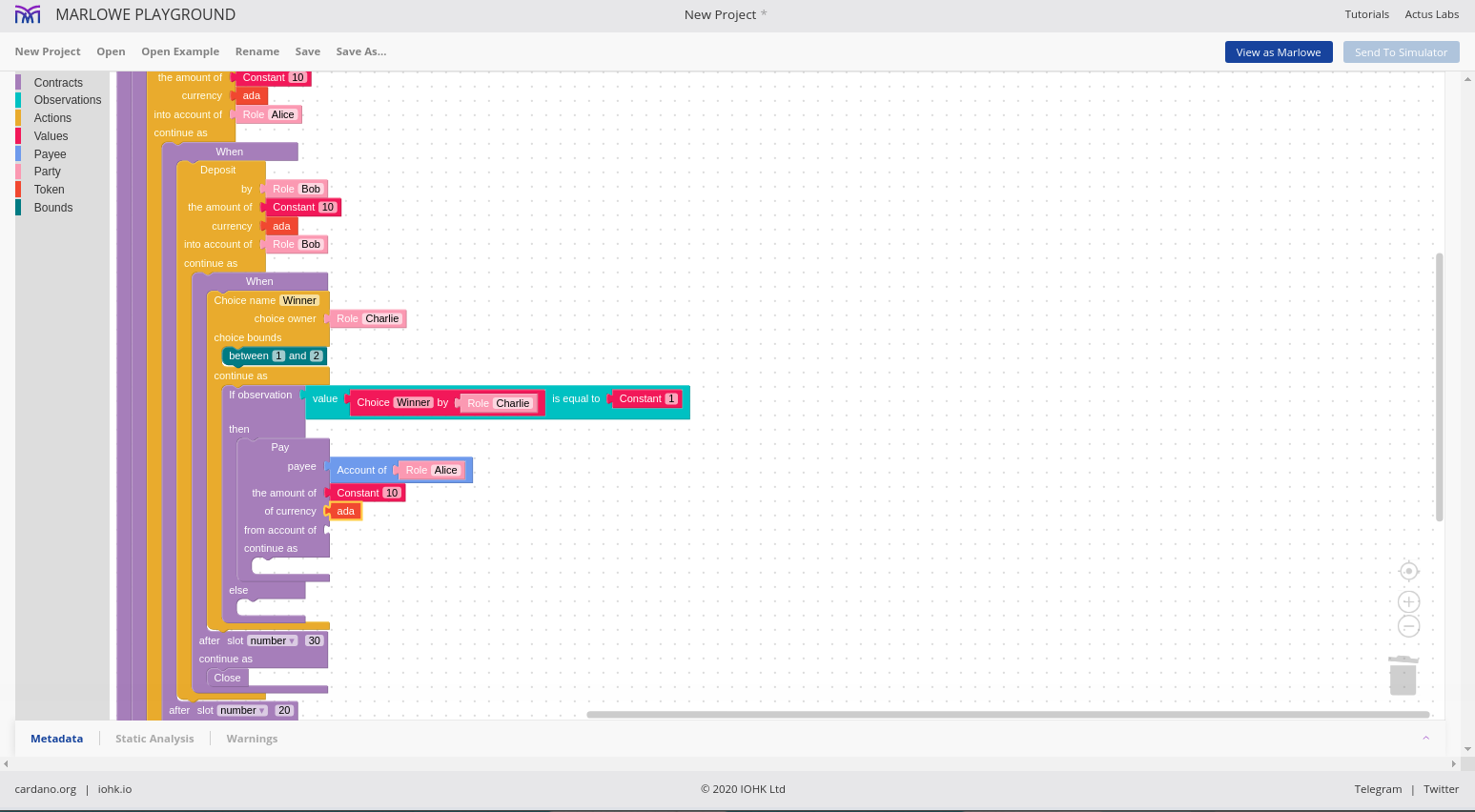
So who pays? It must be an internal account because this pay contract is something that the contract has control over, so it is not an external action. So, payments are triggered from internal accounts and in this case, it is Bob\'s account.
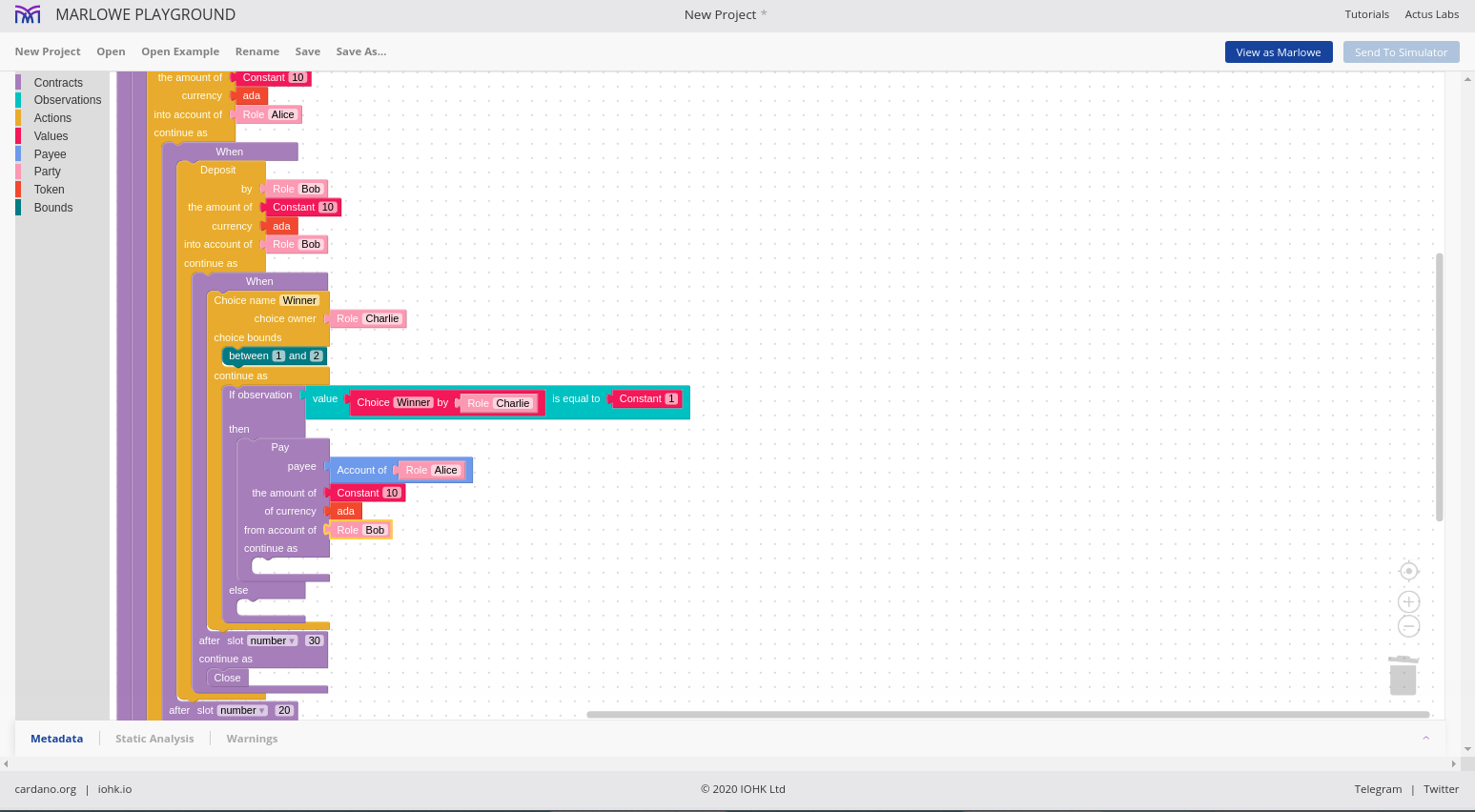
So this now says: If Charlie picked 1, then pay from Bob\'s internal account 10 Ada to Alice\'s internal account.
After this we can just close. And when we close, all the internal accounts will be paid to the external owners. At this point, Alices internal account will have 20 Ada, and when we close, she will get the 20 Ada paid to her.
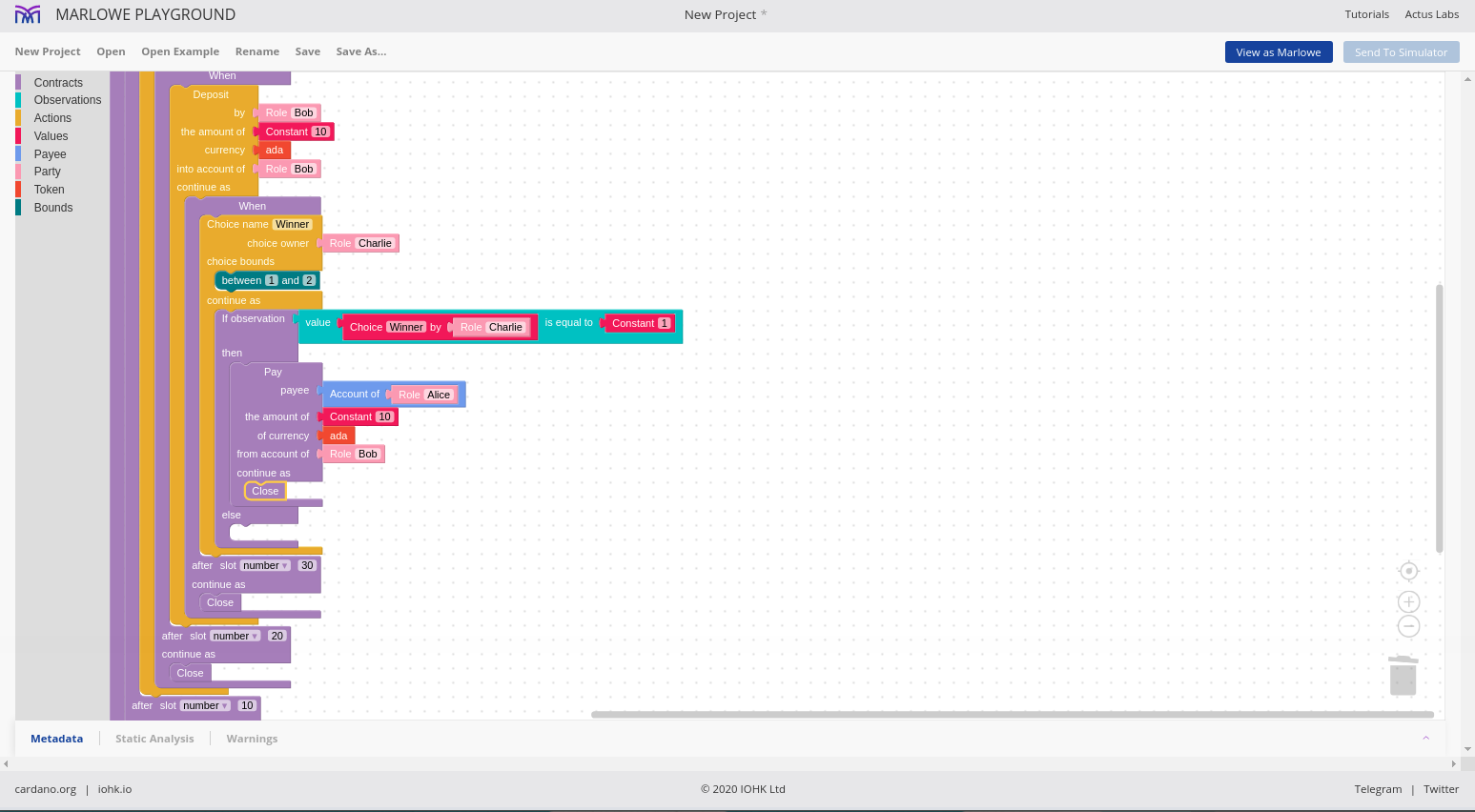
And, if Charlie did not choose Alice, then we must pay to Bob. We can copy paste the previous Pay contract for this and make the necessary modifications.
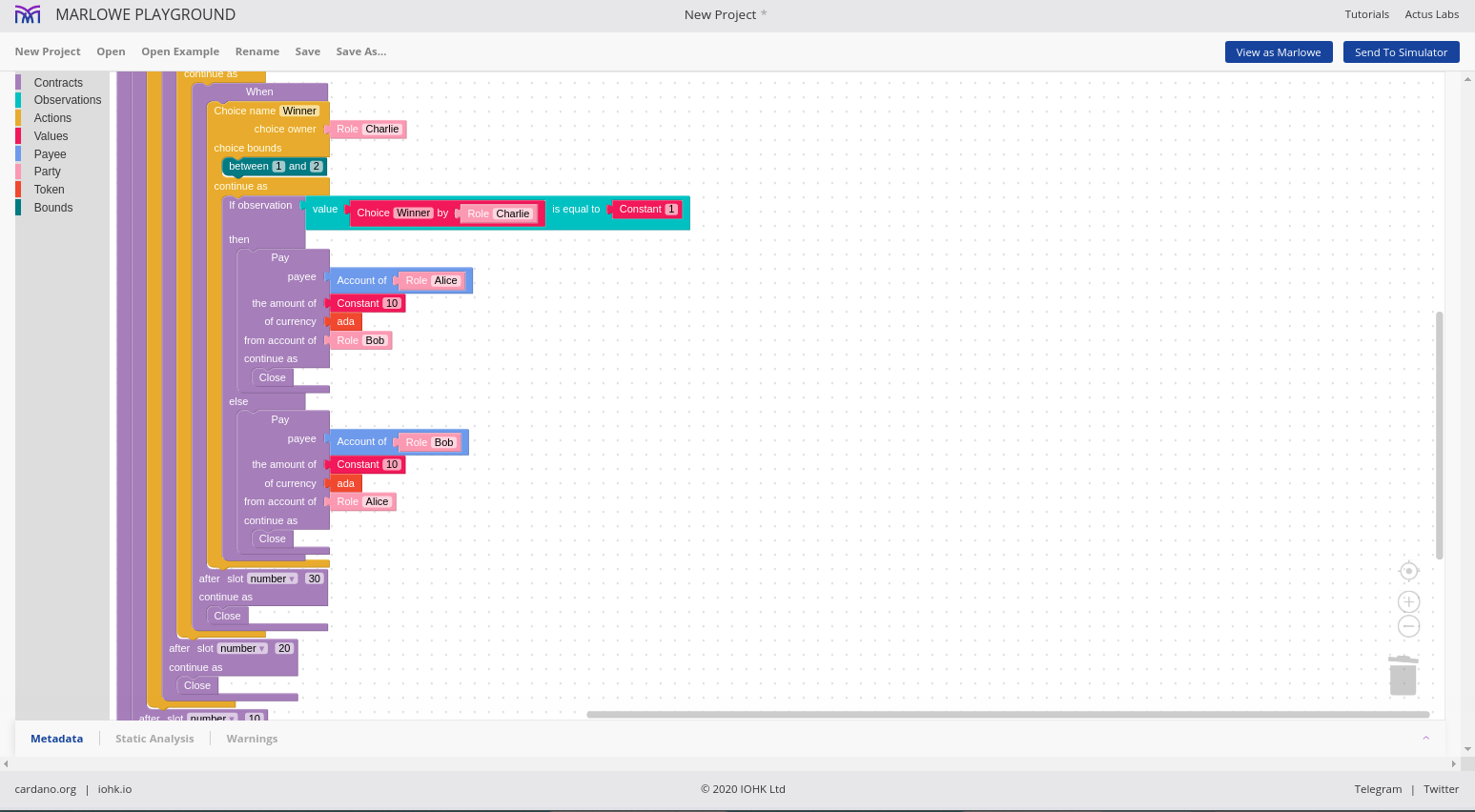
And this should be enough for our contract.
Now we can, for example, look at the pure Marlowe. This is the value of the Marlowe data type called Contract.
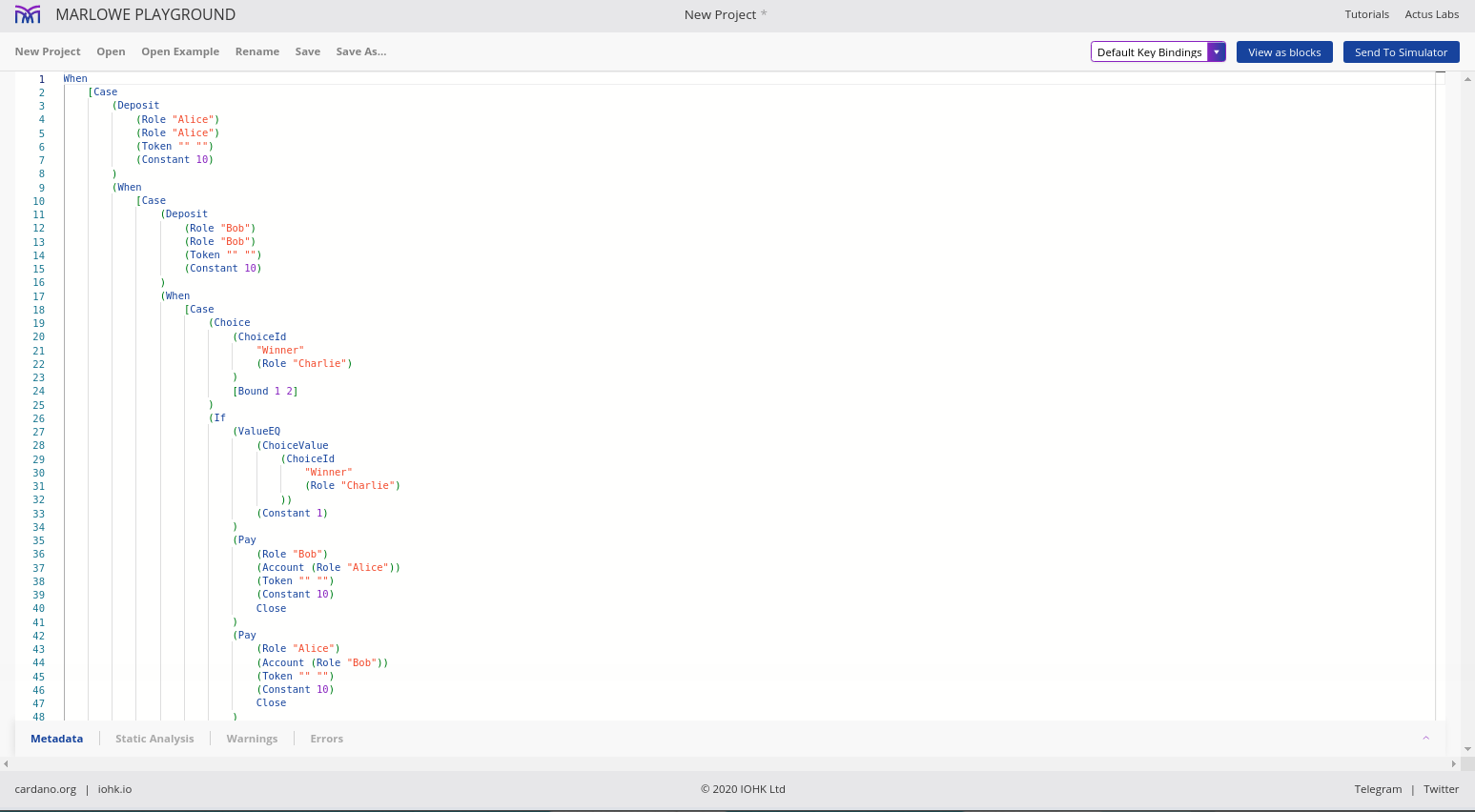
And we can send it to the simulator.
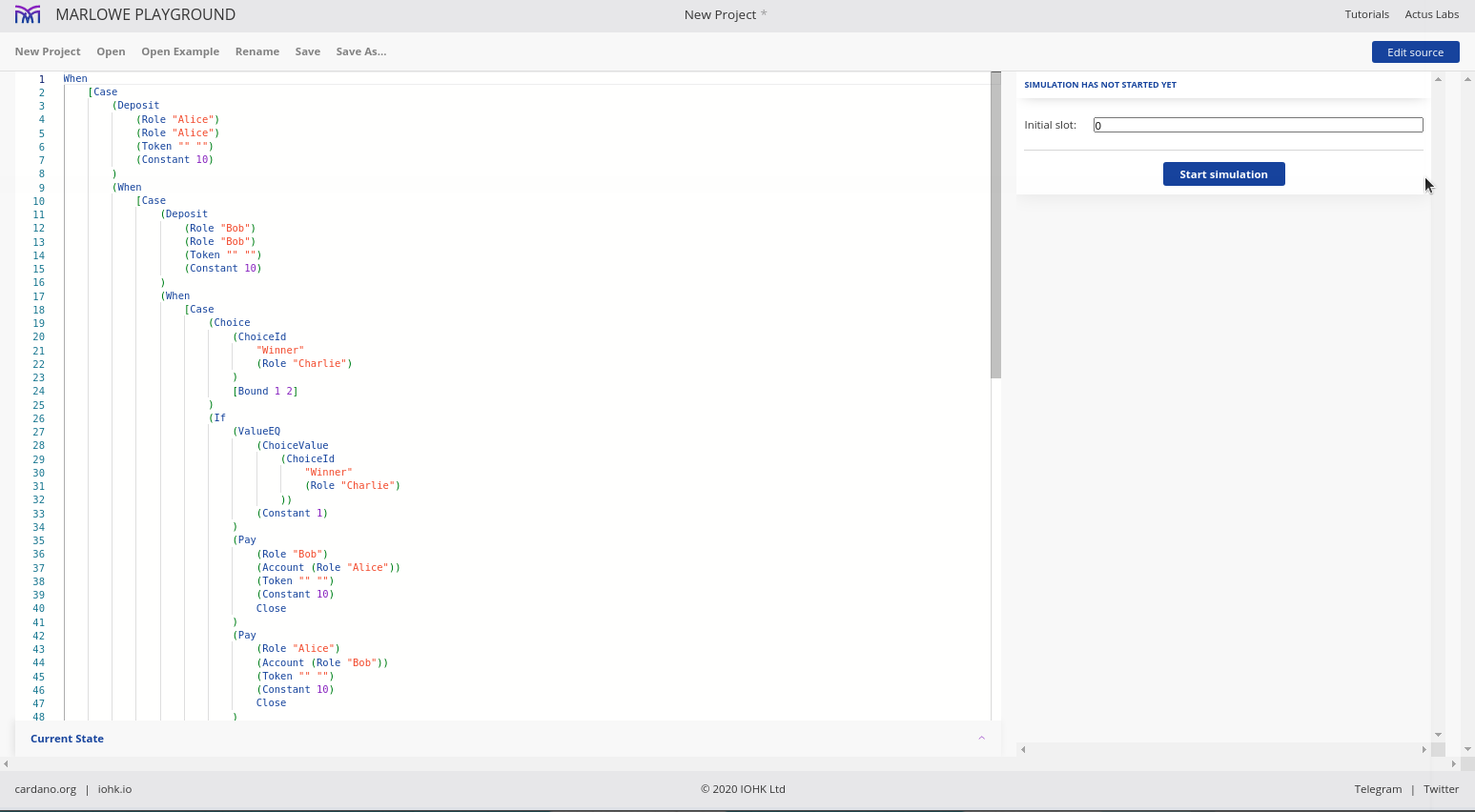
We can start the simulation.
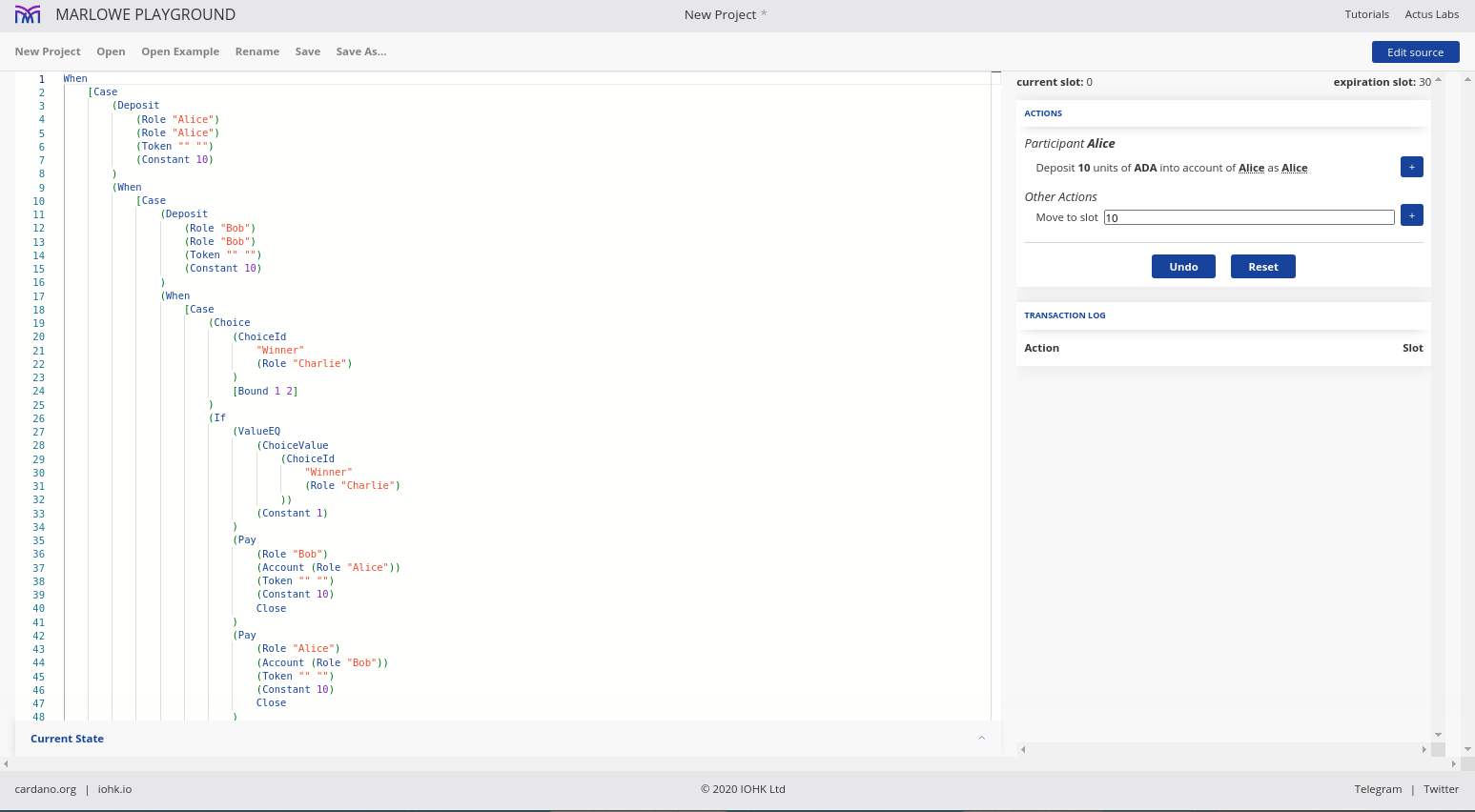
Now, whenever there is a When, we get prompted for which of the available actions to take. In our case we only ever have one available action at each point.
So in the first When, either Alice makes her deposit, or the timeout is reached.
If we wait for the timeout it is very boring. The contract is reduced to Close, and nothing happened.
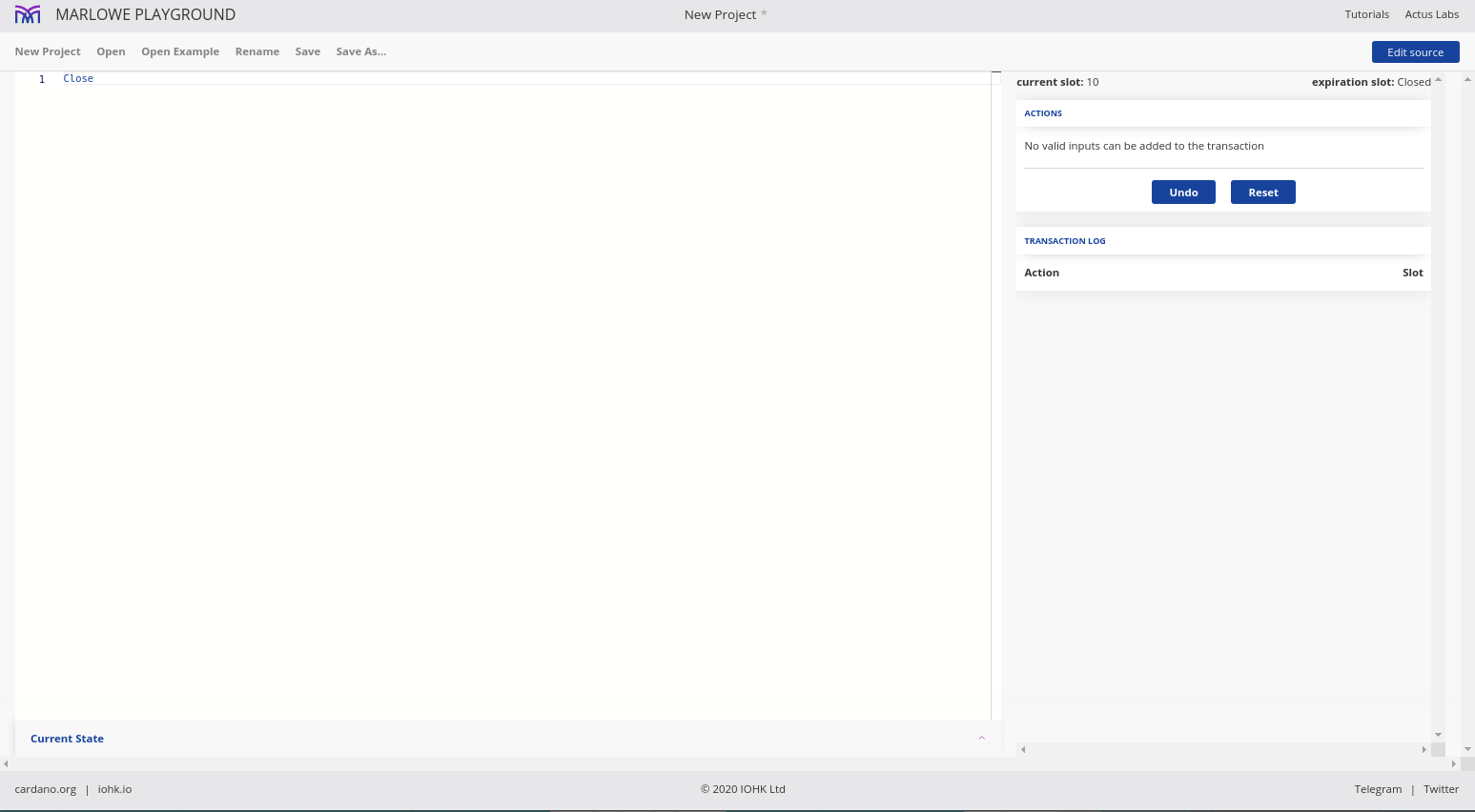
If, however, she makes the deposit, then this contract simplifies - it reduces to what happens after she makes the deposit.
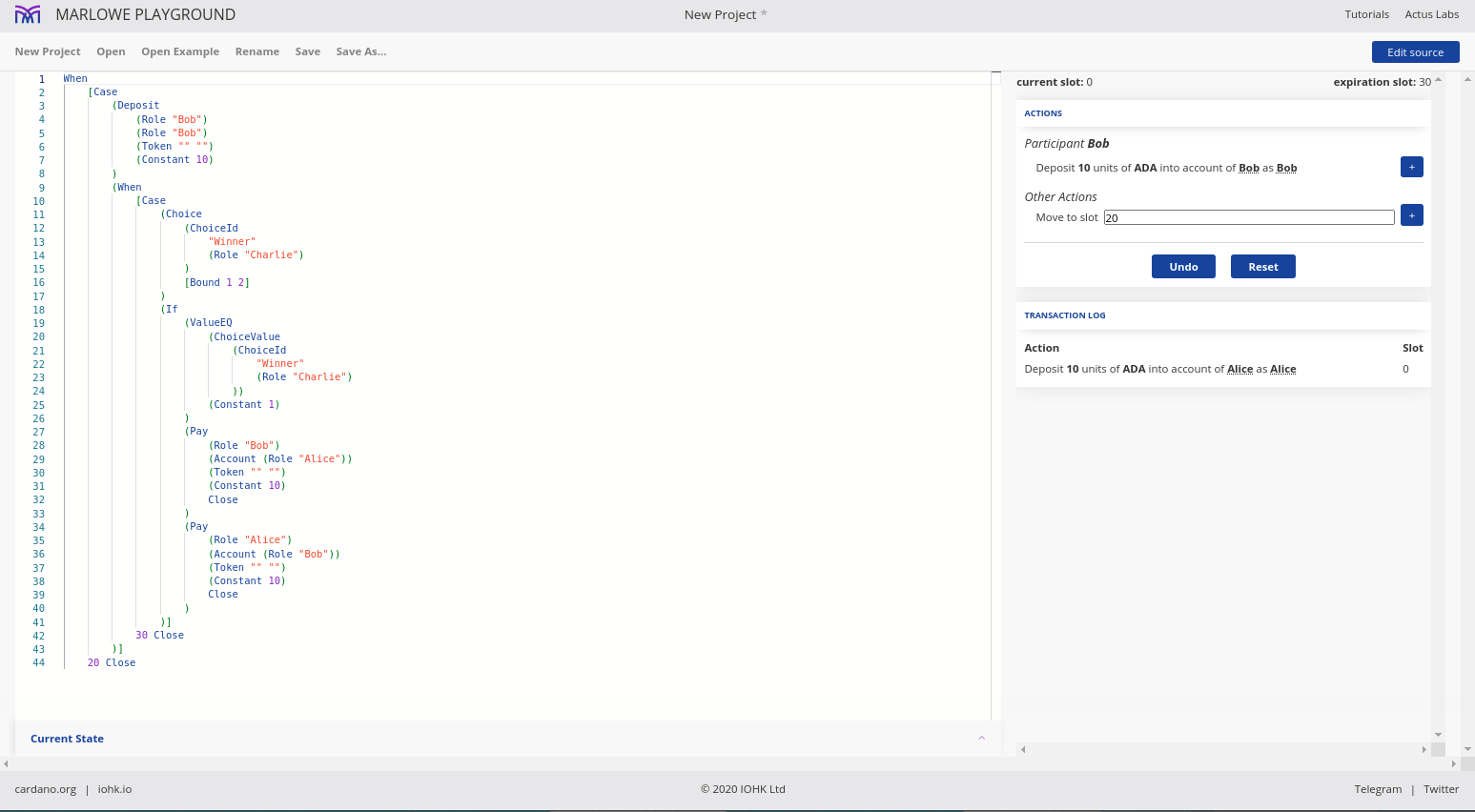
And now we can see we are in the second When, where we are waiting for Bob\'s deposit. Again, he can choose not to deposit. If he does that, then we can see the actions in the transaction log that Alice deposited 10 Ada and the contract pays this back to Alice upon close.
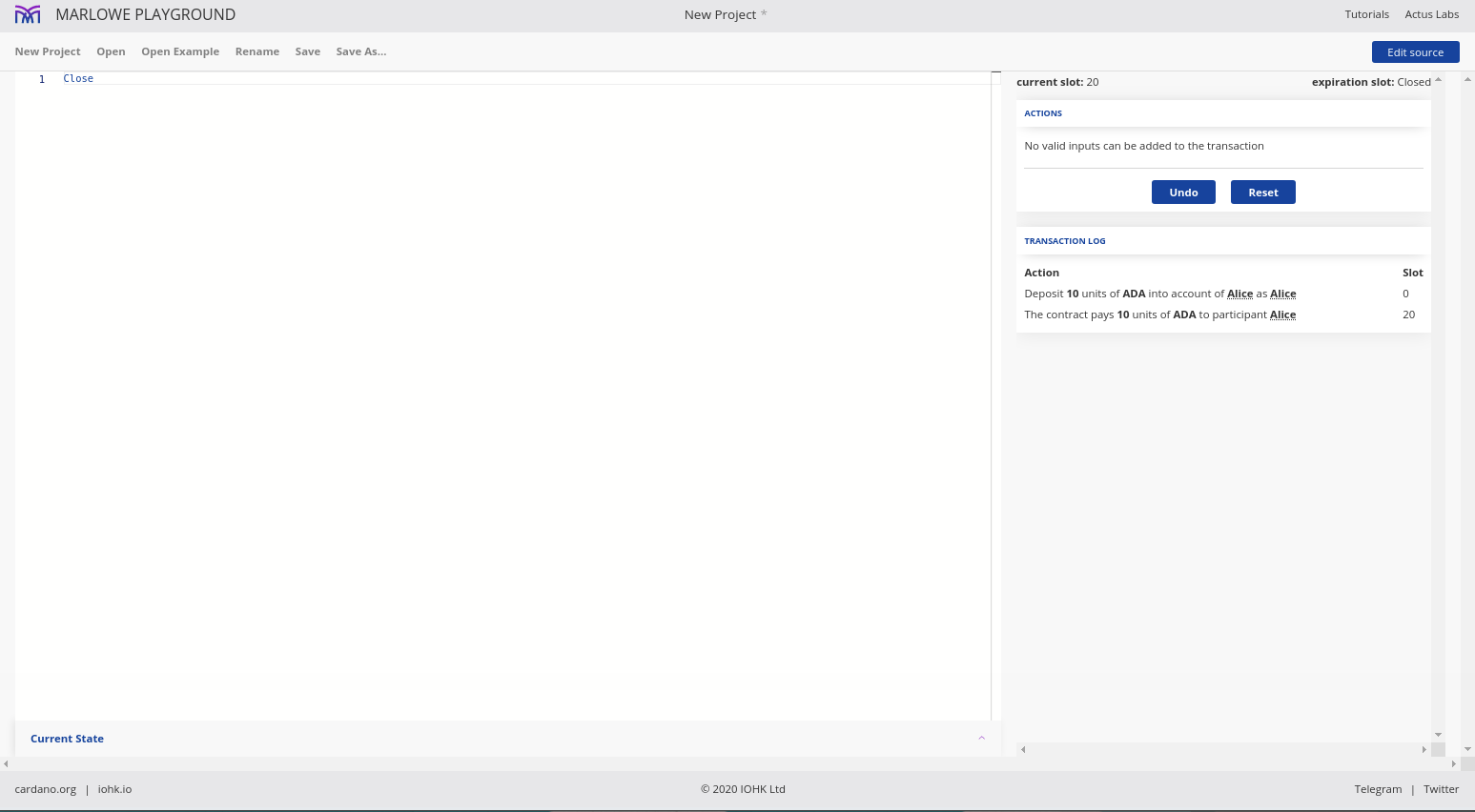
It is more interesting though if Bob also makes his deposit.
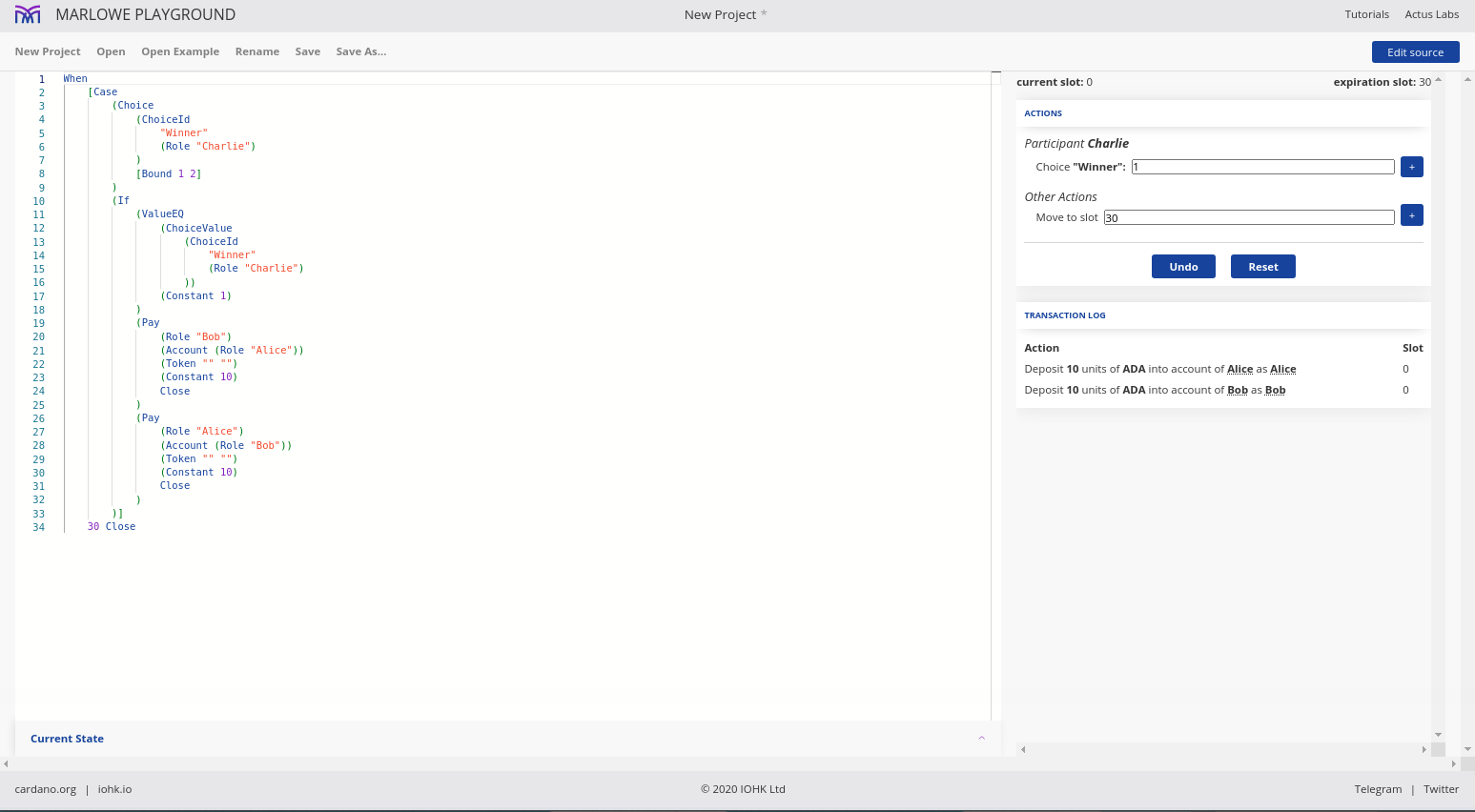
Now the contract has simplified again. Now we are in the When where the only available action is that Charlie chooses a winner.
If Charlie doesn\'t do anything and the contract times out, Bob and Alice both get their money back.
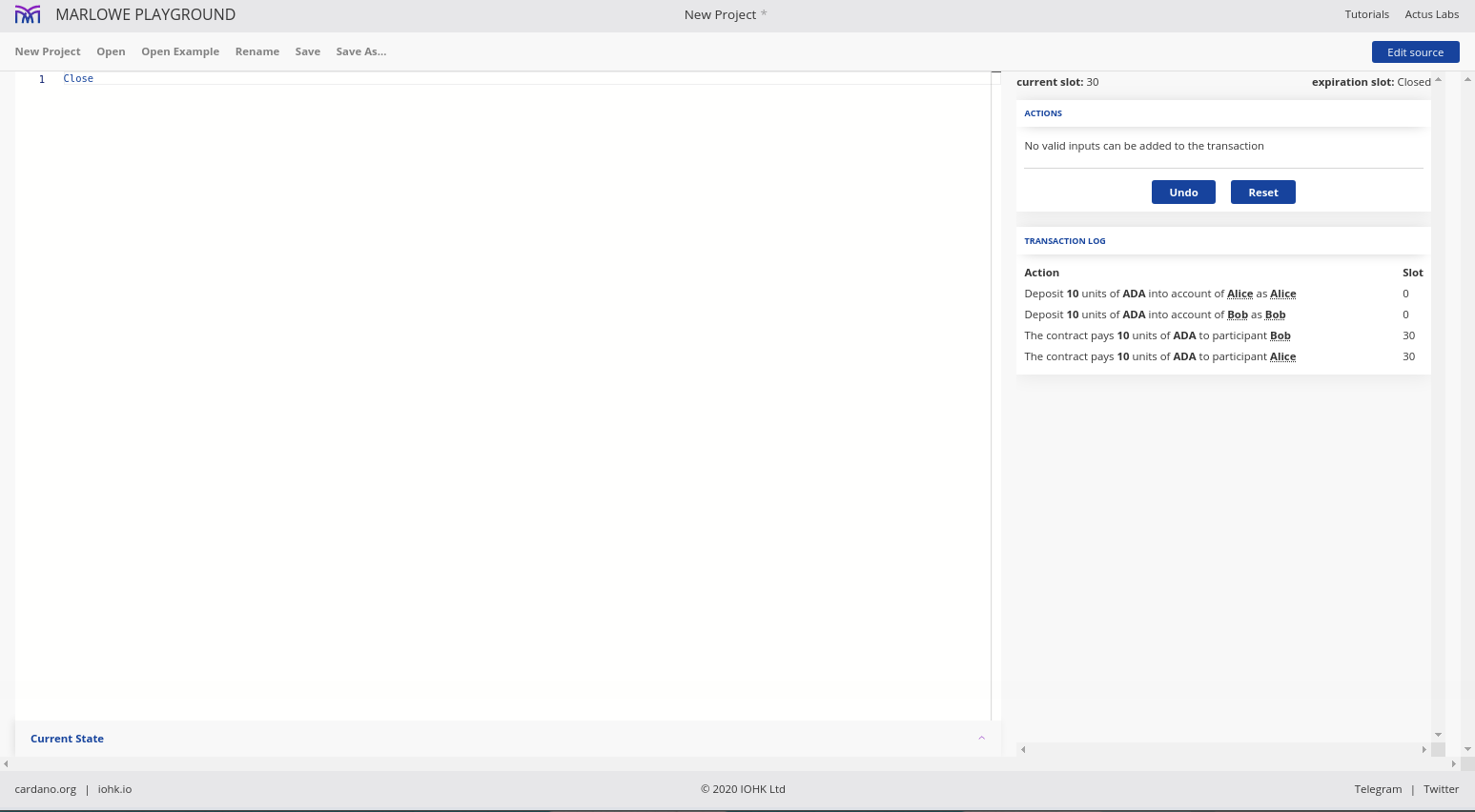
If Charlie picks Alice (choice 1), then we see that the contract pays 20 Ada to Alice.
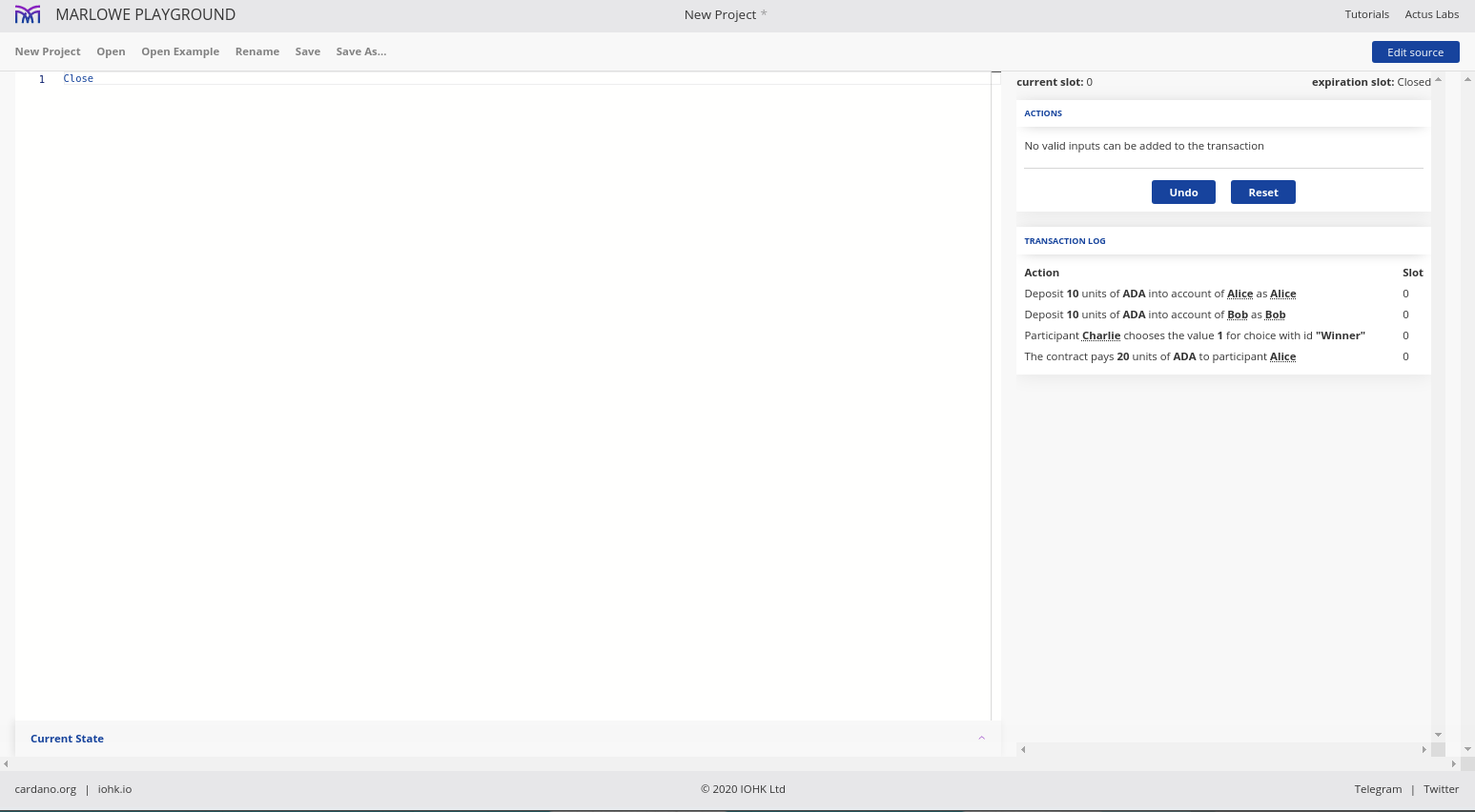
If instead he picks choice 2, then the contract pays 20 Ada to Bob.
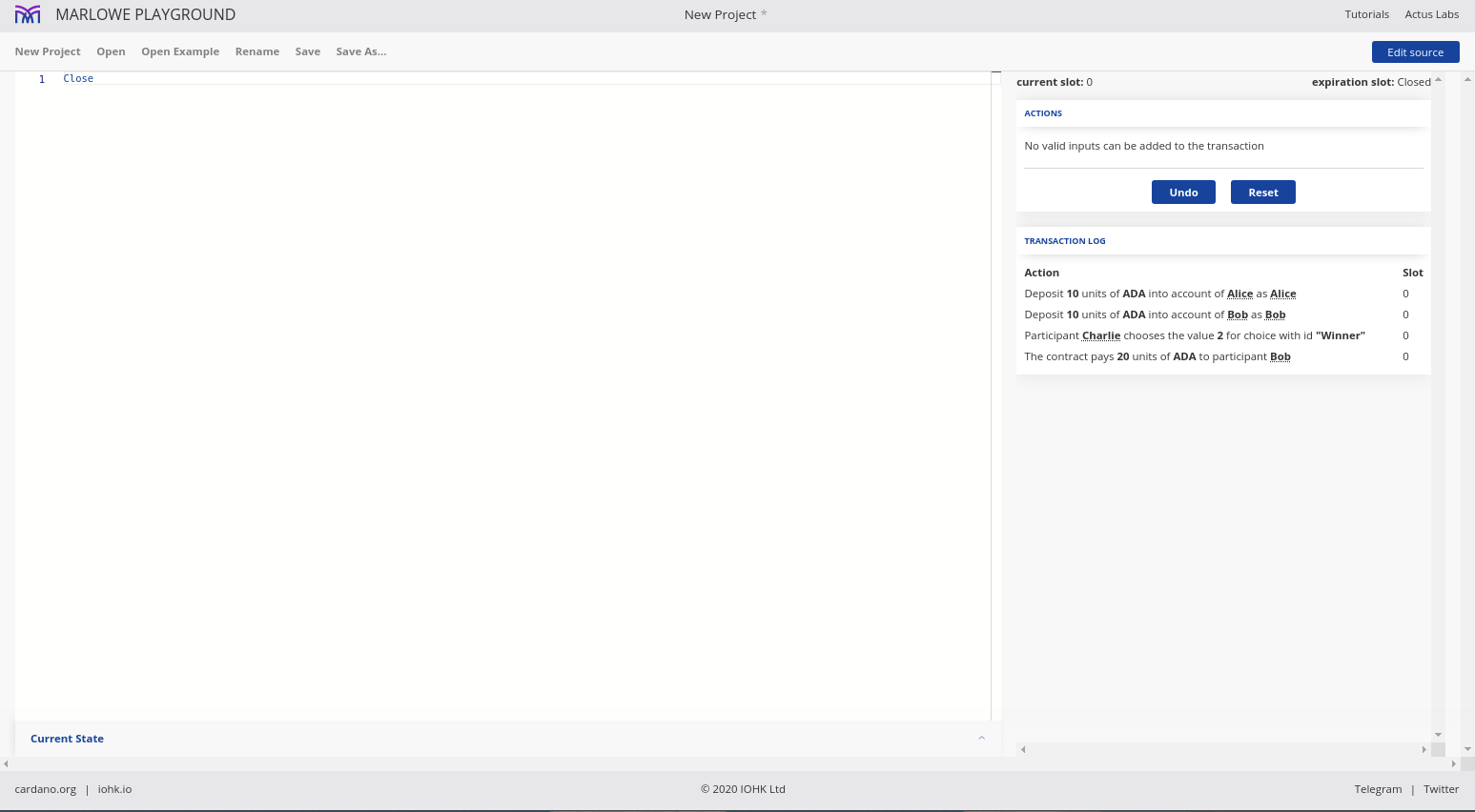
Let\'s now reset the contract.
We will copy the Marlowe code to the clipboard, then create a new Haskell project.
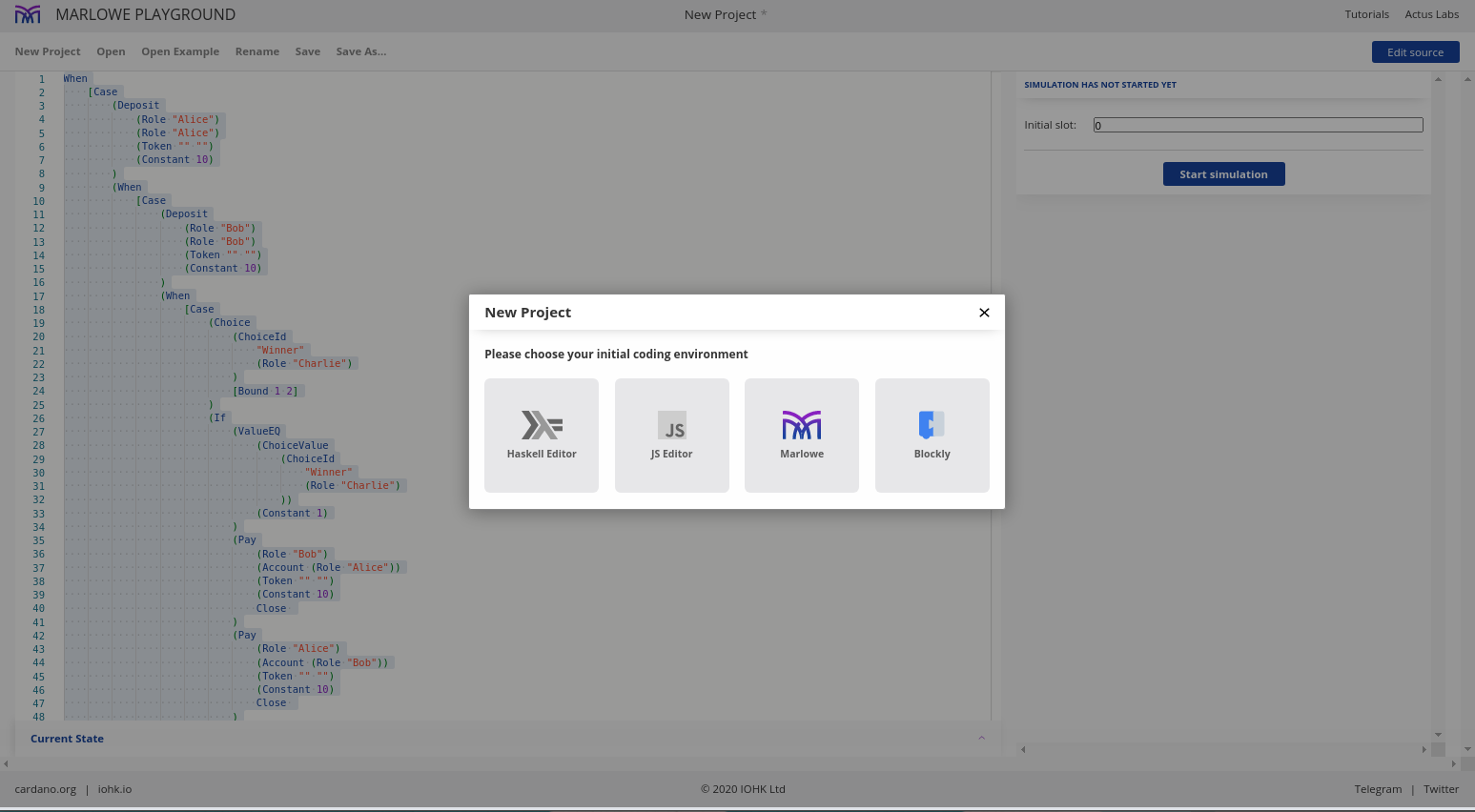
In the Haskell editor there is a template.
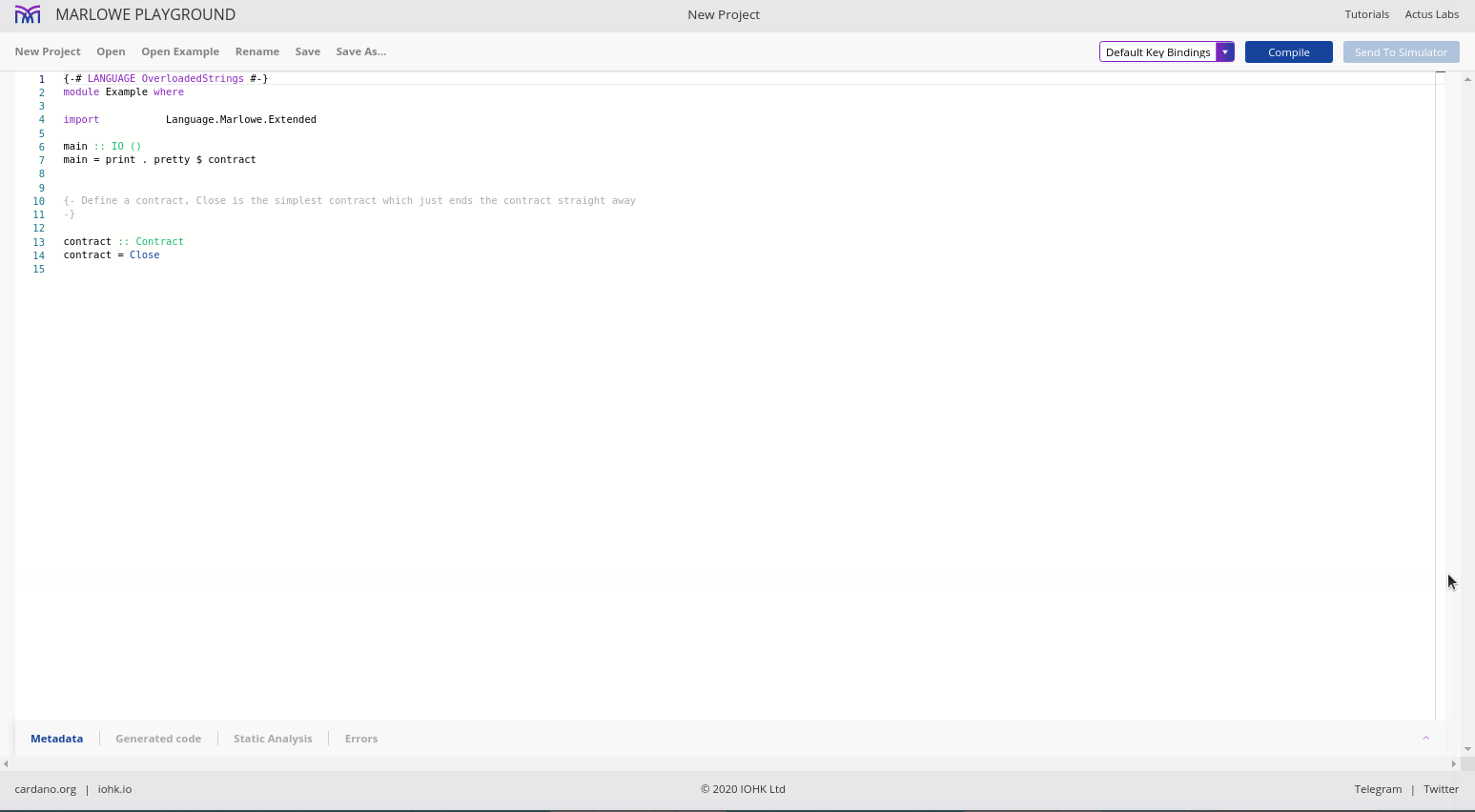
All this program does is to take a Marlowe contract, and then pretty prints it. This is then used to, for example, run in the simulator.
Instead of Close, we can paste what we just copied to the clipboard.
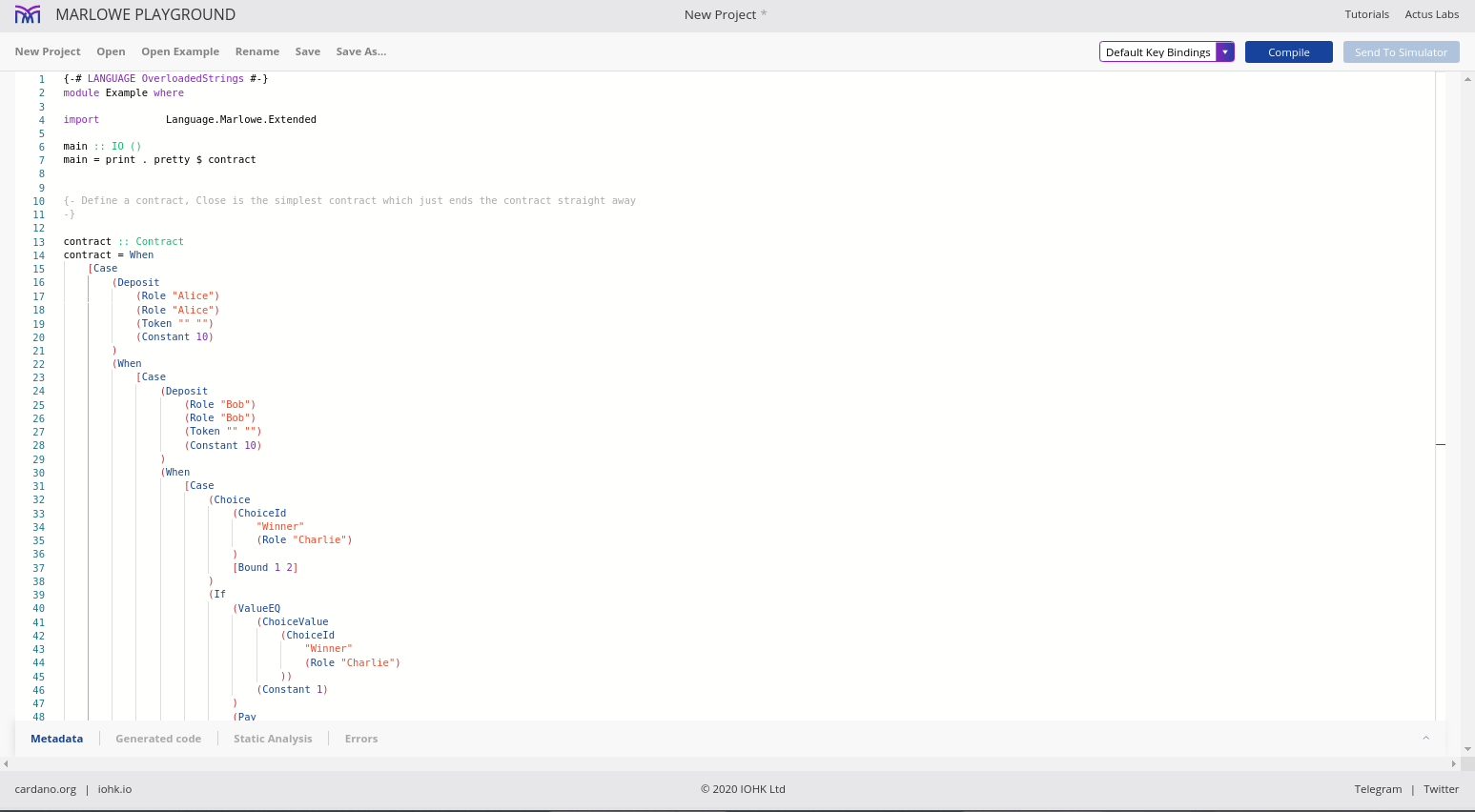
We can then compile this, and send it to the simulator and it should behave exactly as before.
There we don\'t really see the benefit of doing it in Haskell, we could just as well do it in Blockly, although you may find that Blockly is really only useful for learning and writing extremely simple contracts. We have just written a simple contract and already it was starting to get quite unwieldy in the Blockly editor. If you do something more complicated it can start to get very confusing in the editor.
But, we can do other things in this Haskell program. We don\'t have to literally define a contract. We can use the whole power of Haskell to help us to write the contract.
For example, we can see a lot of repetition because we always have the Alice, Bob and Charlie roles. We could define these separately.
Note that we can use overloaded string literals here because the fromString function uses the Role constructor for Party.
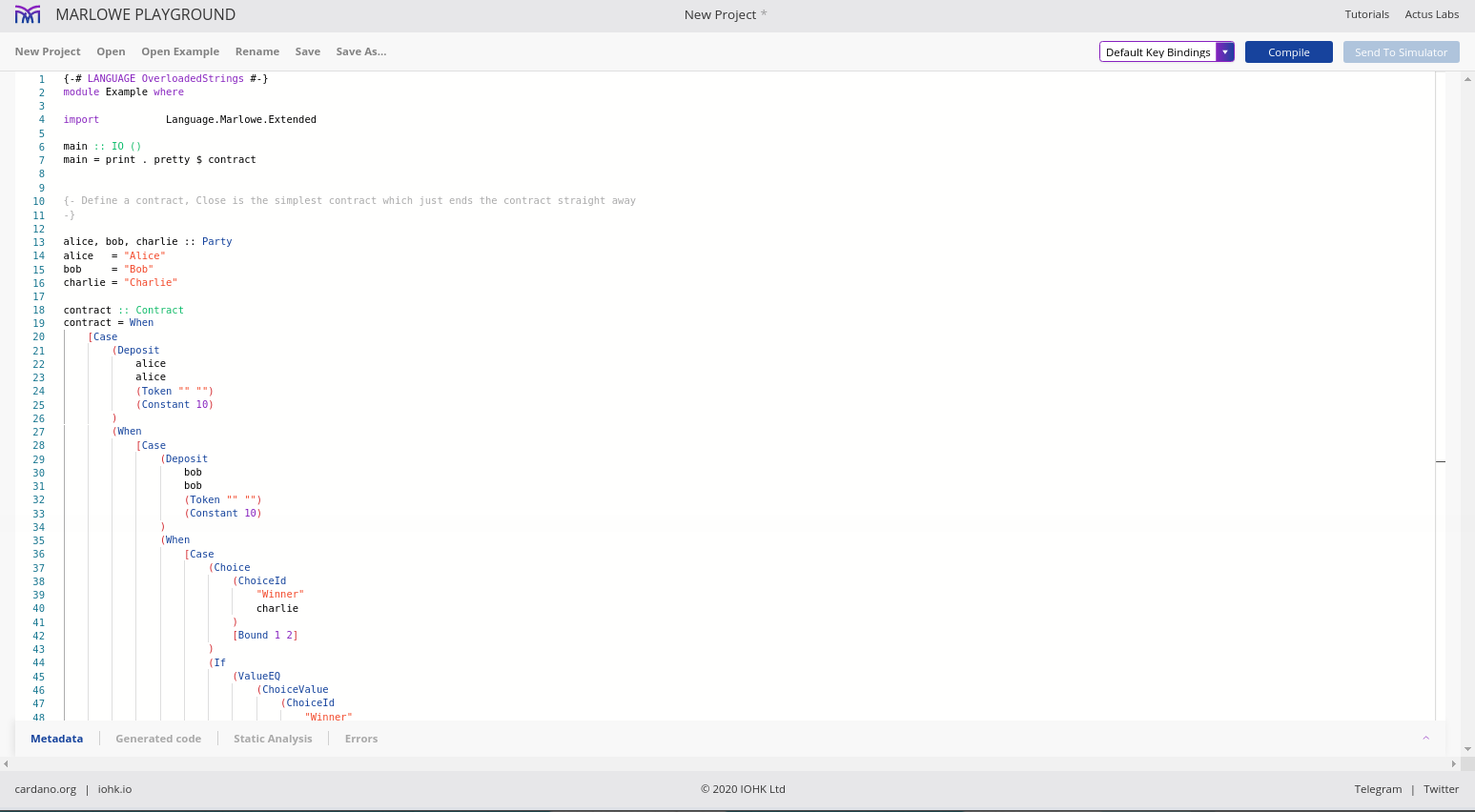
We can also define a constant for the deposit of 10 Ada.
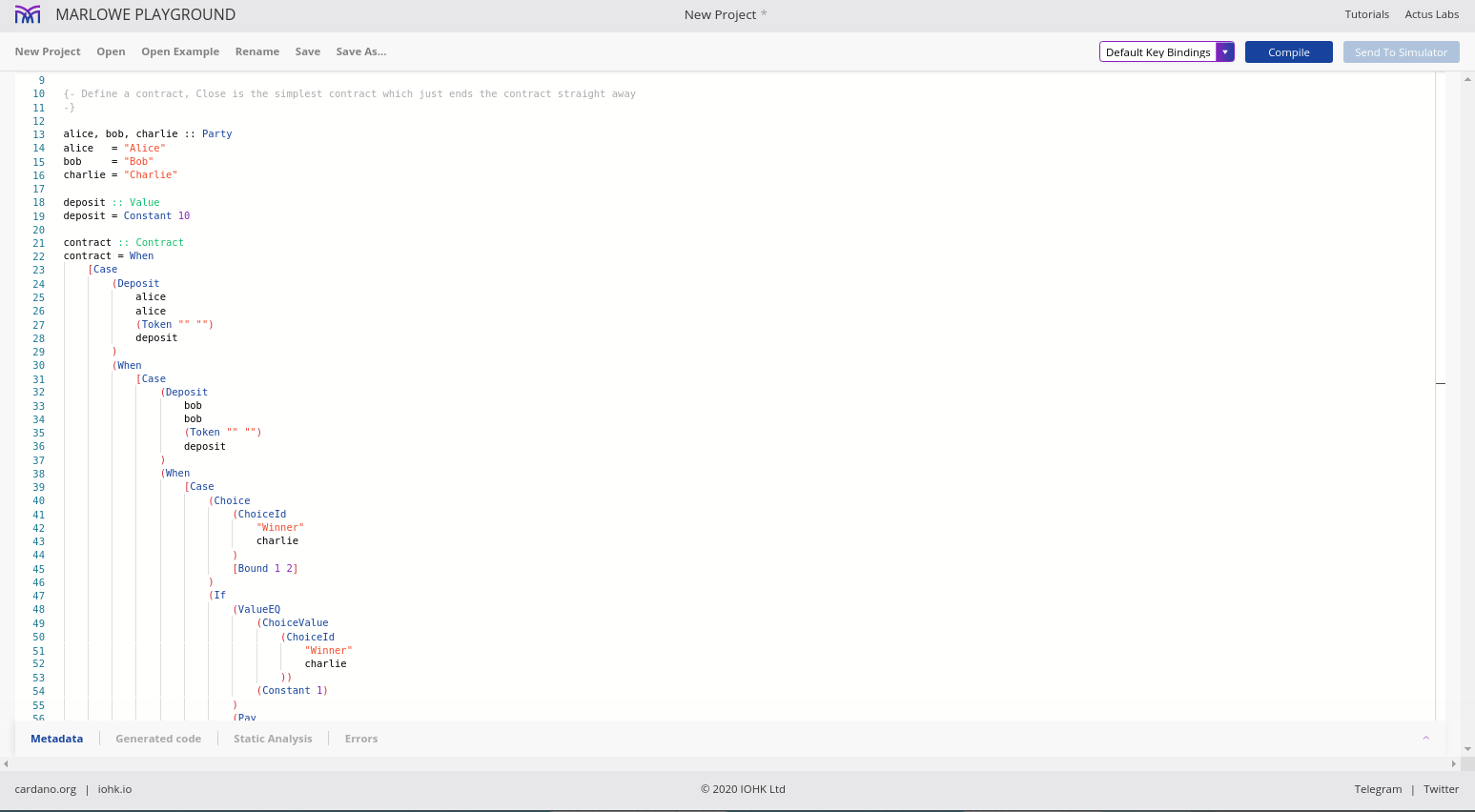
For (Token \"\" \"\"), we can replace this with the ada abbreviation.
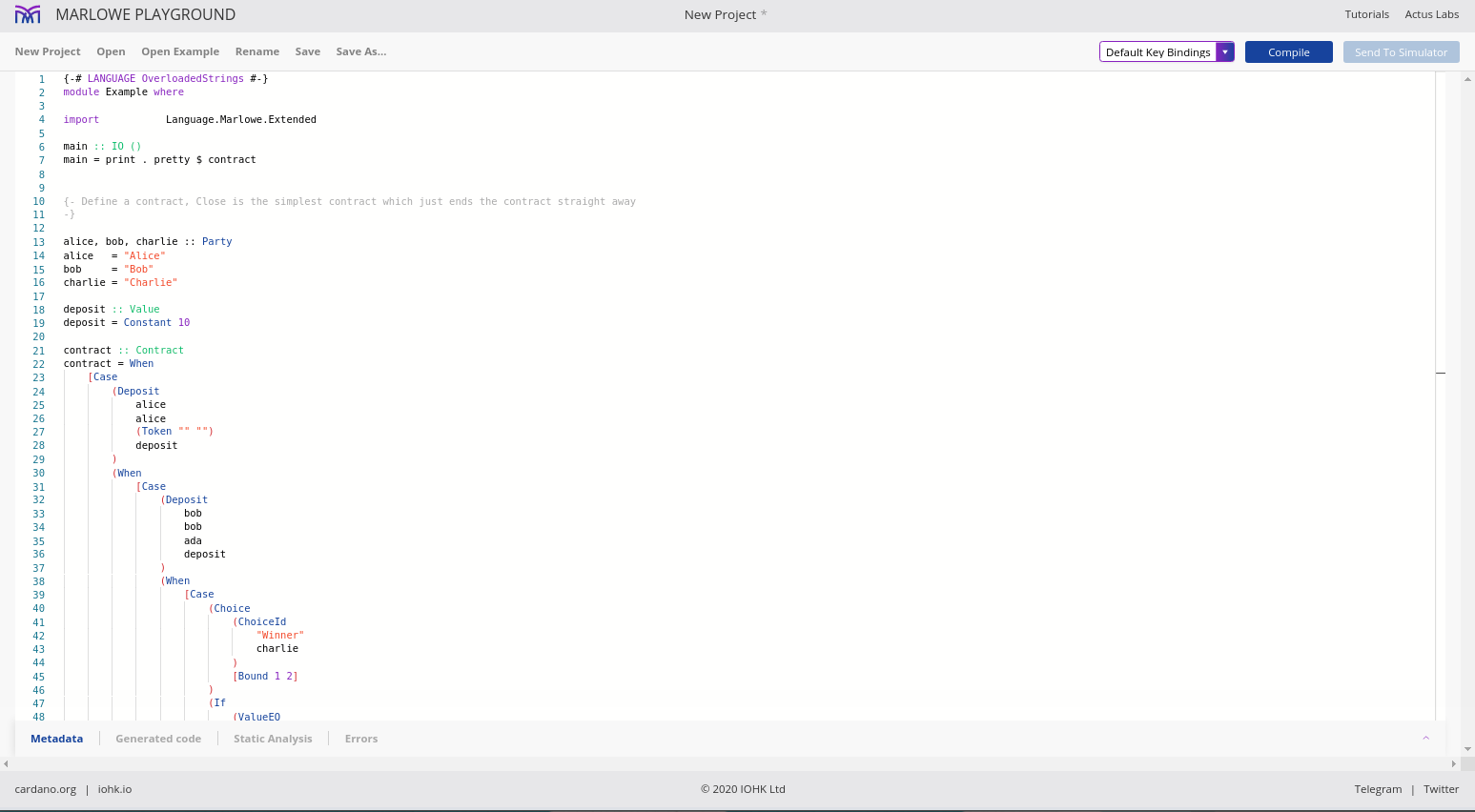
We can also simplify Charlie\'s ChoiceId.
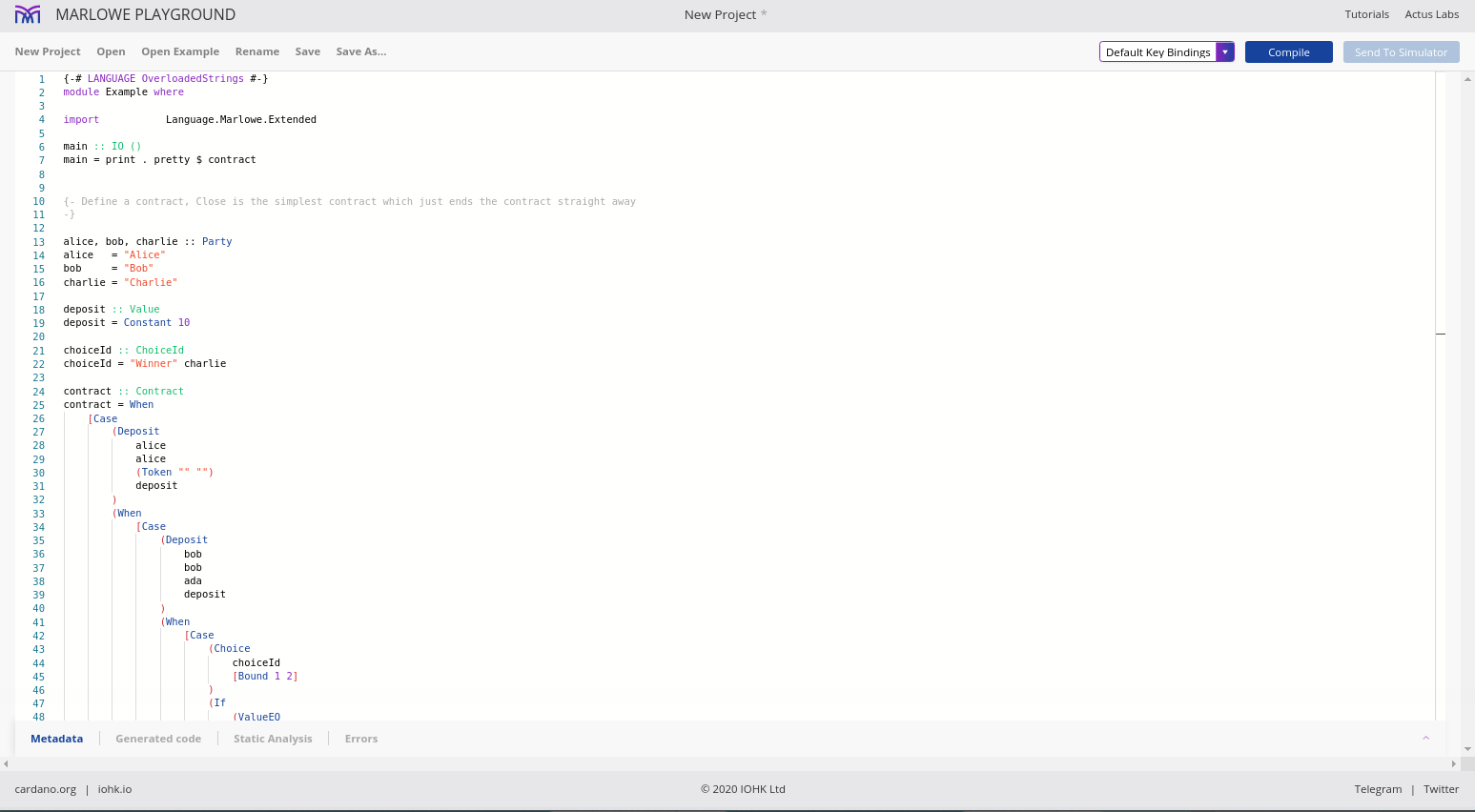
Now it is already cleaned up quite a bit.
It\'s possible to do more sophisticated things. Our contract is slightly asymmetric even though it sounds like a symmetric situation. Alice and Bob are completely symmetric, but in our contract, Alice has to deposit first.
What we could do is to allow Bob to deposit first as well. In the outermost When we would have two deposits - one where Alice deposits, and one where Bob deposits.
Let\'s make a little helper function. It takes two Partys - the party that deposits first and the party that deposits second and then it returns a Case. We can use this to parameterise Alice and Bob as x and y in the Case. Note that we only need to do this for the deposits, the part where Charlie makes his choice can remain the same, with Alice and Bob continuing to be represented by 1 and 2 respectively.
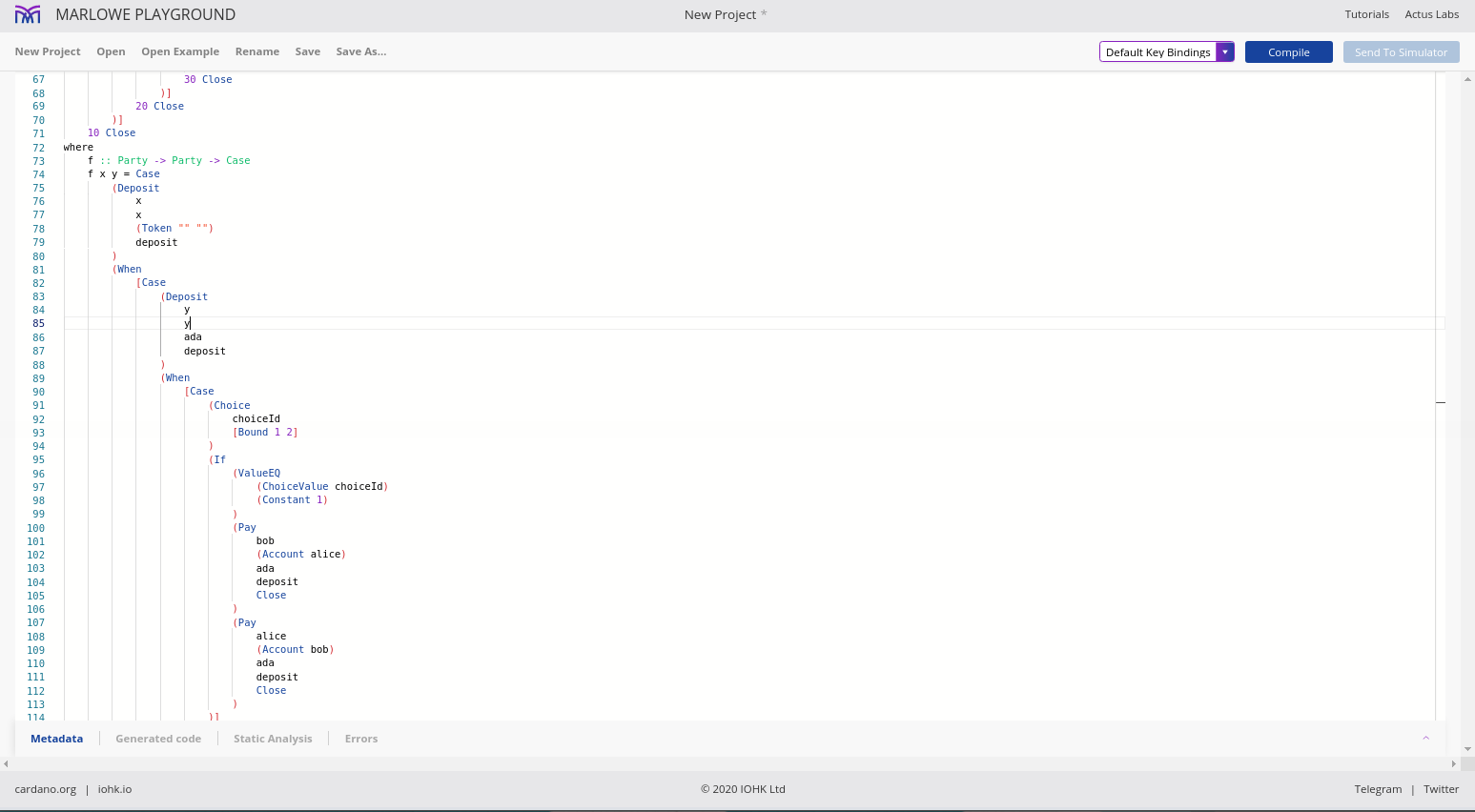
Now we can replace the originally-pasted code with our helper function, and we can create the symmetric case where Bob deposits first as an option to the outermost When.
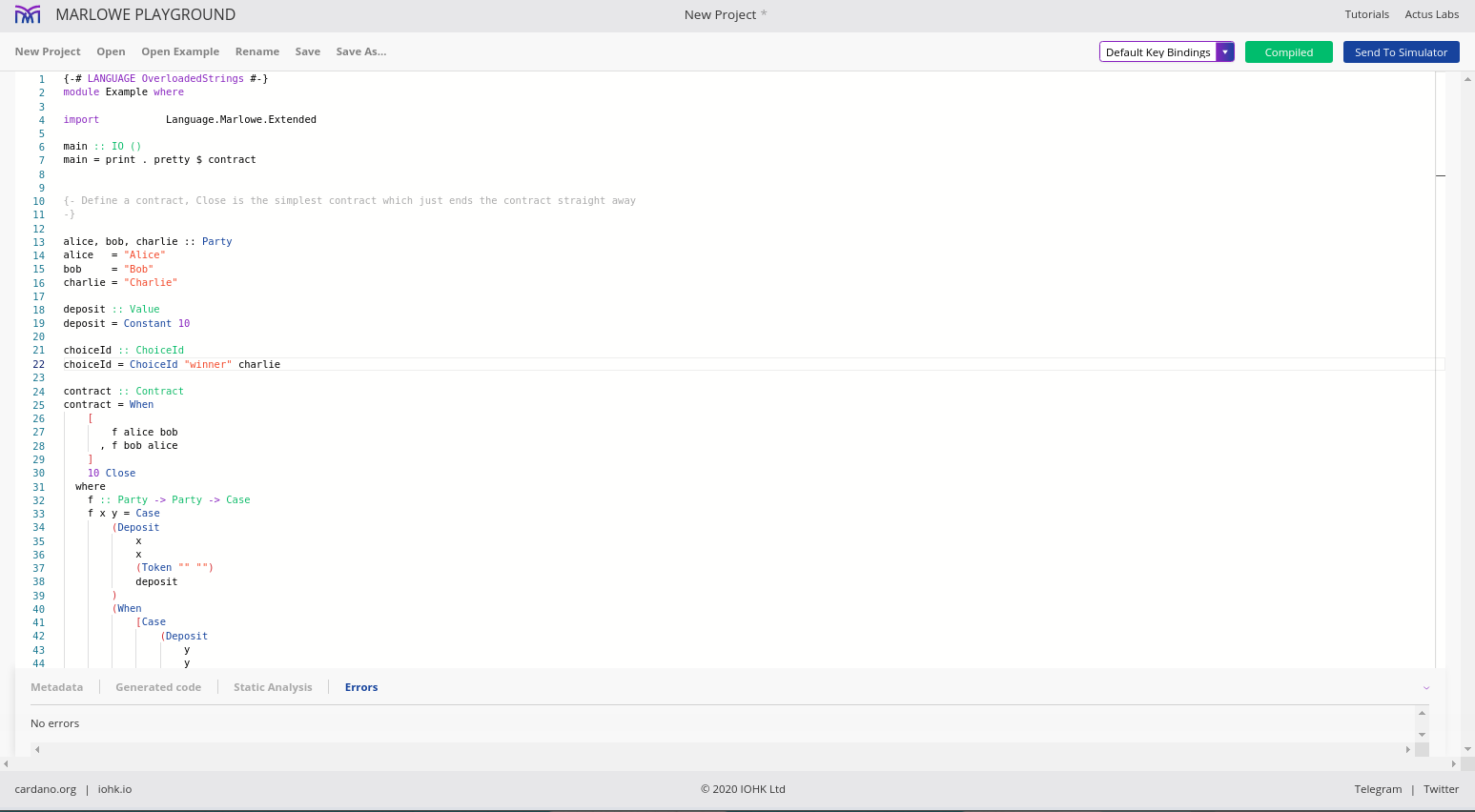
This should compile and we can now send to the simulator.
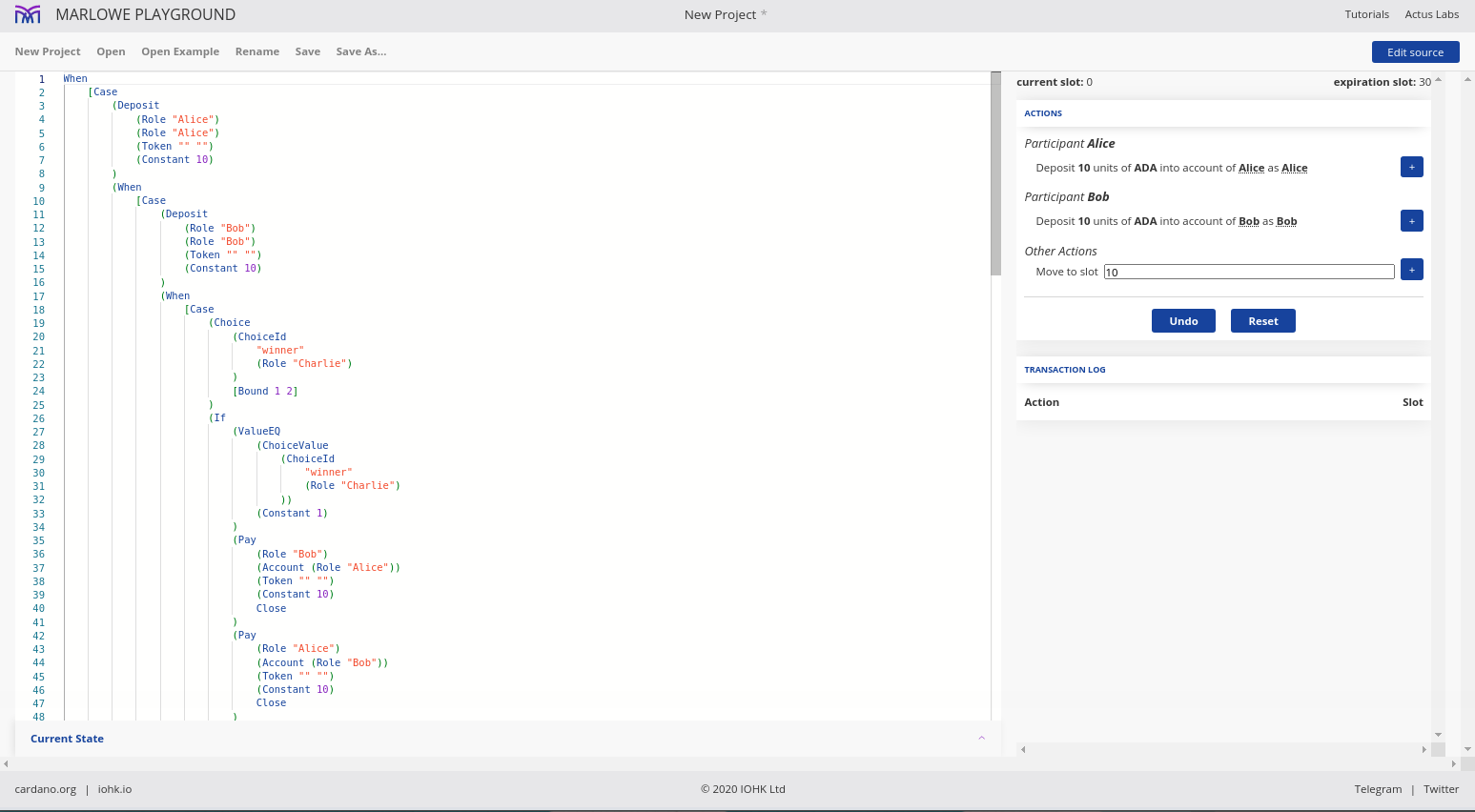
Now we have two possible actions that can happen in the first step. Alice can deposit 10, or Bob can deposit 10.
If Bob starts...

Then now it is Alice\'s turn.
So, basically, to use the Haskell editor, we write a program that produces something of type Contract and you can use all the features of Haskell like local functions or whatever to make your life easier.
When using Blockly, if we had wanted to give Bob the option of being the first to deposit, we would have had no choice but to have copy and pasted the whole When construct.
Of course, there are other options when using Haskell. We could also paramterise the contract, for example, we could pass in the deposit value as an argument.
We could also parameterise the parties and even generalise it so that the number of parties could be variable. This would be very inconvenient if we were to have to do this by hand using Blockly, but in Haskell it is quite straightforward.
What is noteworthy here is that Marlowe, in contrast to Plutus, is very simply Haskell. The Marlowe team made a point of using only basic Haskell features. You don\'t need lenses, you don\'t need Template Haskell, you don\'t even need monads or type-level programming.
Marlowe is not always appropriate because it is specifically for financial contracts, but if it is appropriate then it is a very nice option due to all the safety assurances that Simon mentioned and because it is much simpler and easy to get right than Plutus.